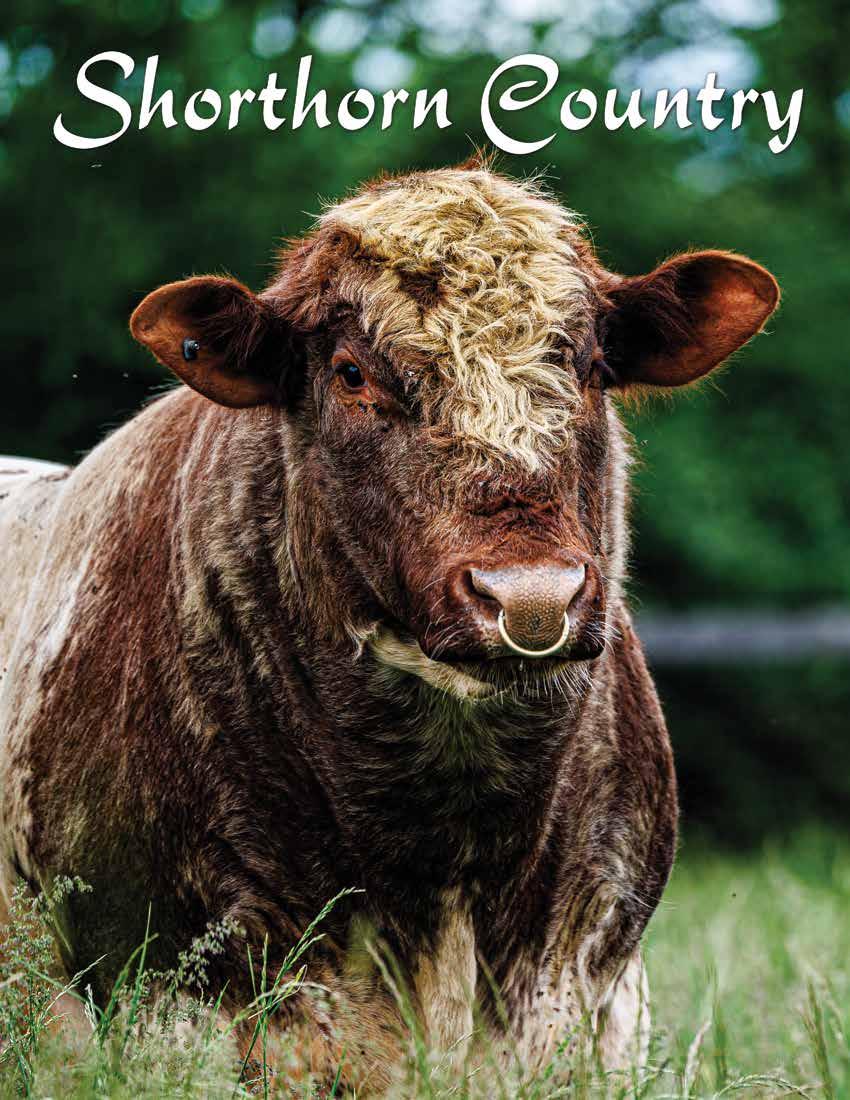
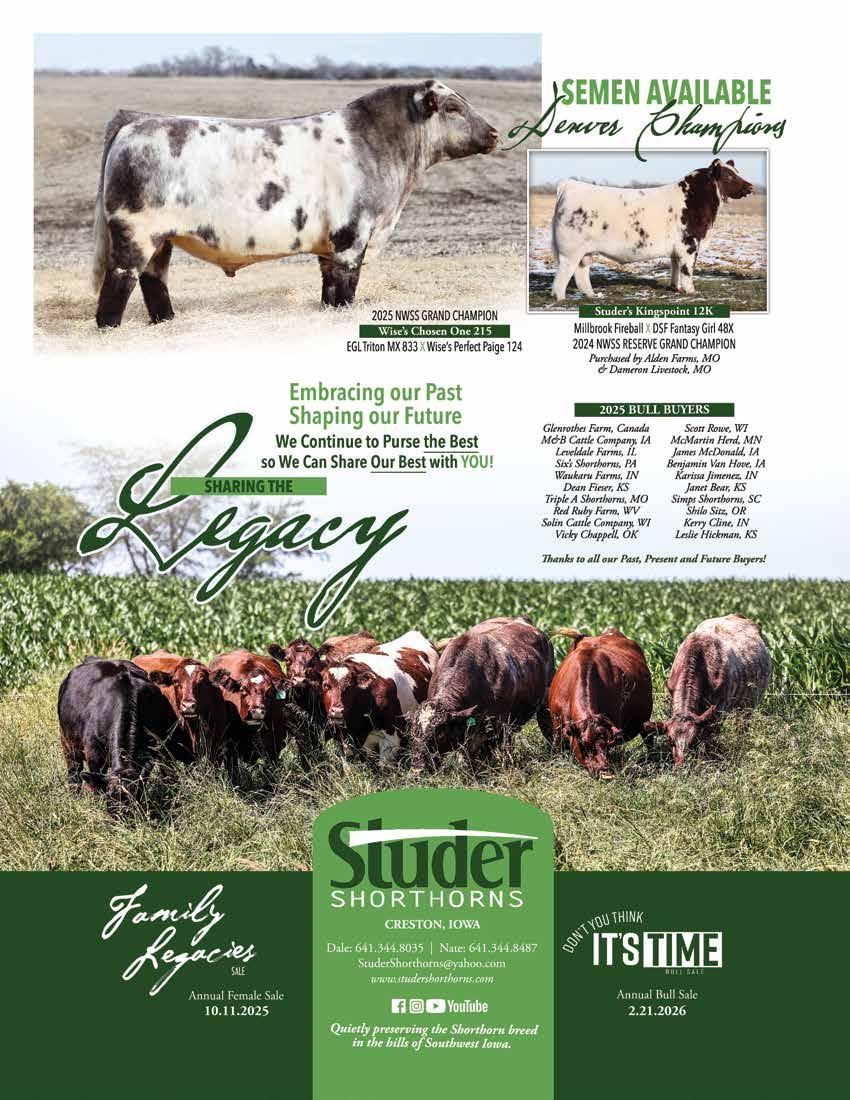

july 2025 issue 6 • volume 52
7607 NW Prairie View Rd, Platte Woods, MO 64151-1544 816-599-7777 www.shorthorncountry.net




july 2025 issue 6 • volume 52
7607 NW Prairie View Rd, Platte Woods, MO 64151-1544 816-599-7777 www.shorthorncountry.net

* Color only available on half of page or
Contract Rates And Discounts:
Contract rates require advertising in all 11 issues per year with a business card ad. Business card price is pre-paid at the beginning of the calendar year or pro-rated if started after the first issue of the year. Contract (11x) rates do not apply for any sale advertising. Contract advertisers must run the business card ad in every issue. Contracts will run by calendar year. No agency commissions are allowed.
Online Sale Packages & Sale Catalogs
Contact us about your upcoming Online Sale or Sale Catalogs for marketing options and pricing.
Don Cagwin, publisher
Amy Studer, managing editor/creative director 816-599-7777 • amy@shorthorncountry.org
Amanda Cagwin, accountant • amandacagwin@yahoo.com
Advertising Representatives
Cindy Cagwin-Johnston 217-452-3051 • cagwincattle@casscomm.com
Darryl Rahn 217-473-1124 • drahn@casscomm.com
Jay Carlson, Carlson Media Group, LLC 913-268-5725 • Jay@carlsonmediagroup.com
Advisory Council
Montie Soules, ASA representative
Don Cagwin, Durham Management Co.
Subscriptions
US: 1 year- $24 • 2 years - $38 • 3 years - $52 1 year US First Class - $54/year Canada: 1 year- $60 • 2 years - $110 • 3 years - $130 Other Foreign: 1 year- $120 • 2 years - $220 • 3 years - $300
SHORTHORN COUNTRY
(ISSN 0149-9319) Published monthly by the American Shorthorn Association, 7607 NW Prairie View Rd., Platte Woods, MO 64151. Subscription rates are $24.00 for 1 year, $38.00 for 2 years, and $52.00 for 3 years in the U.S.; $60.00 for 1 year, $110.00 for 2 years, and $130.00





American Shorthorn Association
7607 NW Prairie View Rd. Kansas City, MO 64151-1544 816-599-7777 • www.shorthorn.org
Montie D. Soules, asa executive secretary/CEO montie@shorthorn.org
Heather Lange, director of office operations; customer service, registrations & DNA • heather@shorthorn.org
Shelby Diehm, director of youth activities; marketing & communications • shelby@shorthorn.org
Cassie Reid, director of shows & events; customer service specialist cassie@shorthorn.org
Wade Minihan, director of shows & member communications; customer service specialist • wade@shorthorn.org
Bryce Schumann, director of performance programs and commercial acceptance consultant • bryce@shorthorn.org
Carrie Land, customer service specialist • carrie@shorthorn.org
Accounting • accountmgr@shorthorn.org
July
July 3-20 World Shorthorn Conference and Tour, Canada
July 4 ASA Office Closed
July 20-23 The Summit IGS Youth Leadership Conference, Philadelphia, Pa.
July 26 Ohio State Fair (Super Regional)
August
Aug. 1 Builder of the Breed Nominations due to the ASA
Aug. 1 Deadline for ASA Membership in good standing to be eligible to be a voting delegate at Annual Meeting
Aug. 4 Delegate Election Ballots mailed to members in good standing
Aug. 11 Illinois State Fair (Regional)
Aug. 15 State Fair of West Virginia (Regional)
Aug. 16 Iowa State Fair (Regional)
Aug. 20 Appalachian Fair (Regional)
Aug. 21 Western Idaho Fair (Super Regional)
Aug. 22 Kentucky State Fair (Regional)
Aug. 23 Tennessee State Fair at Wilson County Fair (Super Regional)
Aug. 24 Maryland State Fair (Regional)
Aug. 30 Minnesota State Fair (Super Regional)
Aug. 31 ASA Fiscal year ends: All registrations counted for Century Club must be registered
September
ASA Board of Directors
Lee Miller, president 330-231-6834
Mark Gordon, vice president 217-737-7905
John Russell, executive director 832-588-8604
Rick Osterday, 605-281-1175
Cory Bollum, 507-279-0480
Tyler Cates, 765-576-0035
Jeff Bedwell, 580-822-5590
Jeff Aegerter, 402-641-4696
Cary Gilman, 515-360-6006
Shorthorn Foundation
Bill Rasor, president
American Junior Shorthorn Association
Haylee Ferguson, president
National Shorthorn Lassies Tawana Holland, president
2025 WHR assessments will come available to complete online starting November 1, 2024. They will also be printed/sent to those whose preferences are set as so in their DigitalBeef accounts. The Board of Directors approved pushing the deadline windows back, and they are listed below.
2025 ASSESSMENT FEE SCHEDULE: April 1, 2025 – December 31, 2025 $30
1. WHR inventory assessments must be completed and paid in full prior to registering calves born in the current assessment period, (i.e. 2025 assessment on a dam must be completed and paid in order to register her calf born in 2025.)
2. Included with each assessment is the registration of a calf born to the dam in the year she was assessed (if calf is registered prior to one year of age) and a free transfer of said calf (if recorded within 60 days from the date of the sale.) (i.e. cost to register a calf born in 2025 to an assessed 2025 dam will be $0, if calf is registered within 12 months)
*Calves born in previous year(s) to unassessed dams will incur additional fees.
The Annual ASA Adult WHR Membership deadline was pushed back to April 1. Any TOC breeder that does not renew their membership before April 1, 2025 must become a WHR breeder – if they choose to renew after the new April 1 deadline.
Sept. 1 ASA Office Closed - Labor Day
Sept. 3 All ballots due in ASA office for electing delegates
Sept. 7 Washington State Fair (Regional)
Sept. 12 Kansas State Fair (Super Regional)
Sept. 14 Amarillo Tri-State Fair & Rodeo (Regional)
Sept. 27 Tulsa State Fair (Regional)
October
Oct. 4 Keystone International Livestock Exposition (National)
Oct. 12 Northern International Livestock Exposition (Regional)
Oct. 24 American Royal Livestock Show (National)
November
Nov. 18 North American International Livestock Exposition (Super National)
January
Jan. 11 Cattlemen’s Congress (Super National)
Jan. 16 National Western Stock Show (National)
Jan. 31 Fort Worth Stock Show (National)
February
Feb. 21 Dixie National (National)
Breeders can now send and are encouraged to send DNA samples directly to Neogen for testing rather than sending to the ASA office. Starting July 1, 2023, a manual processing fee will be incurred for those samples sent to the ASA office for preprocessing.
3 things will be required to send samples in for testing: 1. A registration (or recorded “U”) number for each tested animal
2. A paper copy of the finalized testing form, (emailed from staff, description below) which includes the Neogen order number
3. A barcode number for each animal tested
Breeders can queue up animals for testing in DigitalBeef and select which sample types they have, as well as which tests they want. Once the form is submitted, staff will process the testing request and get an order ID # from Neogen. A finalized printable PDF of the submission form will be emailed to you to print, sign and send to the lab with samples. Checks/ payments are still made to the ASA. Once staff approves the testing request, the breeder’s DigitalBeef account is billed accordingly.
Monday - Thursday 8:00 am to 4:30 pm
Friday 8:00 am to 2:00 pm
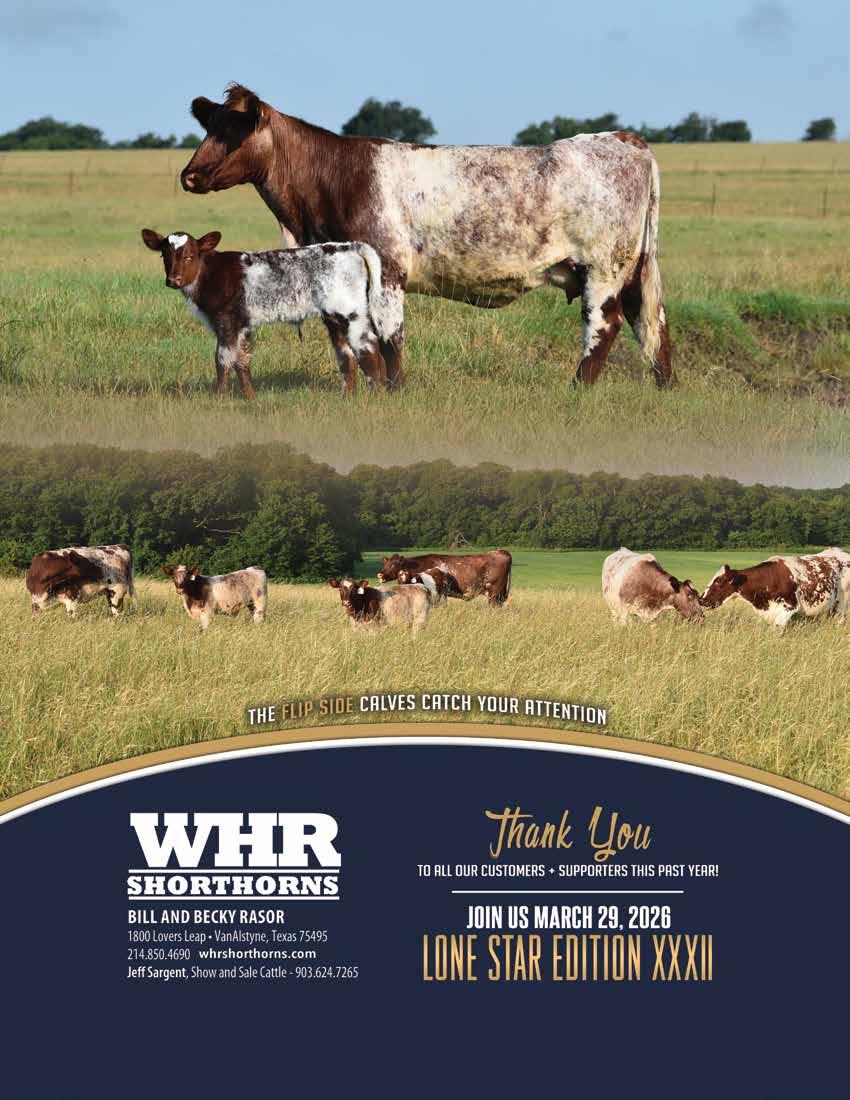


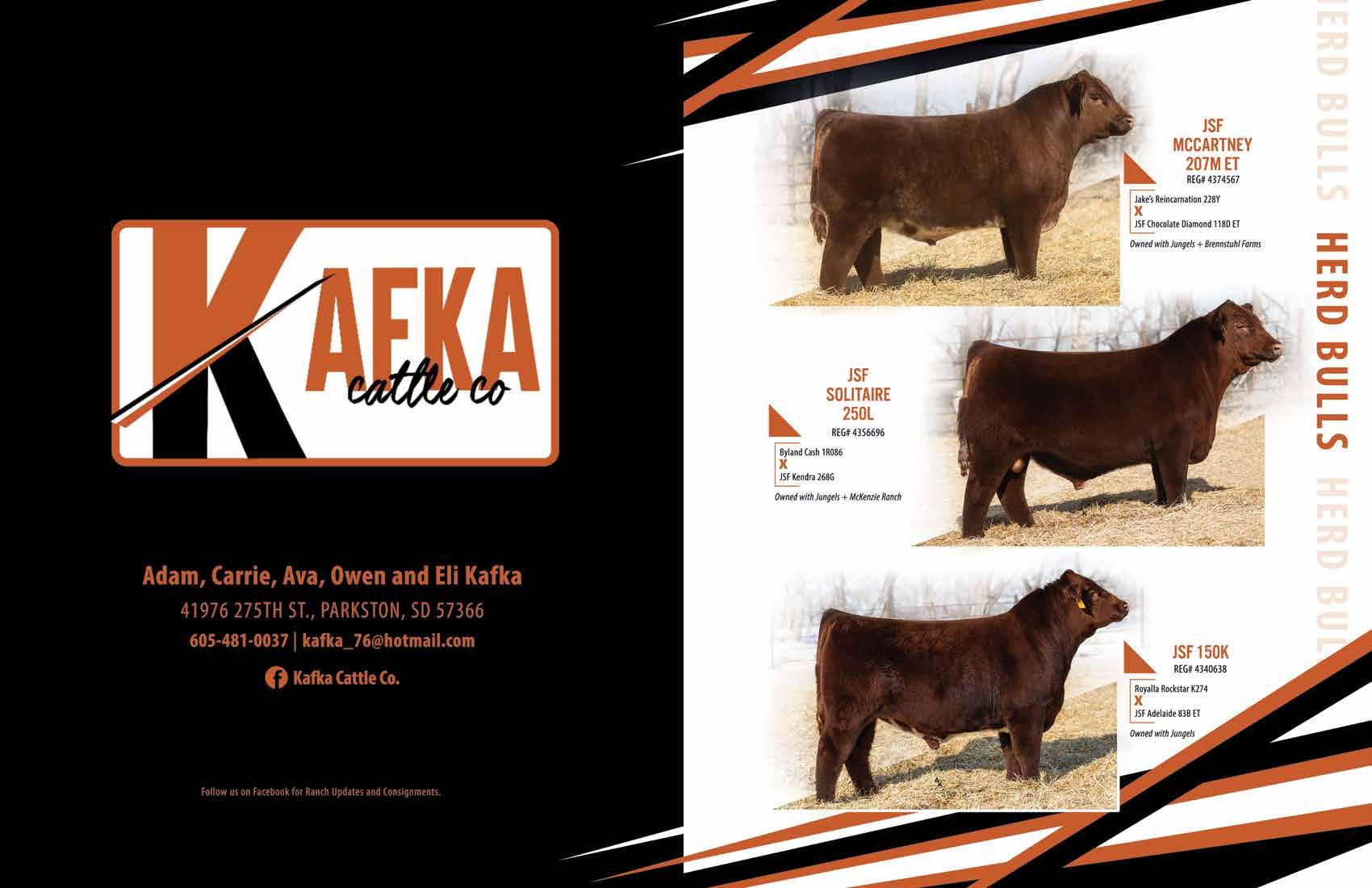



Montie D. Soules asa executive secretary/CEO
As we reflect on the past twelve months within the Shorthorn community, it is clear that the ASA Board, staff, and most importantly, the membership’s collective efforts have propelled us to new heights of success and recognition. From milestone events to record-breaking achievements, each moment has underscored the strength and vitality of our Shorthorn family.
The Shorthorn Symposium in July 2024 stands out as a pivotal gathering where breeders and enthusiasts converged to exchange knowledge and insights. Hosted at a top-tier facility and supported by industry leaders, the event showcased our commitment to continuous learning and reinforced our dedication to advancing the breed’s genetic potential.
This past year also marked the release of our new Maternal Index CPI (Cow Productivity Index, $CPI), a strategic tool designed to help breeders better identify and select for maternal strength. This forward-thinking approach reflects our continued effort to make Shorthorns the go-to maternal breed in the cattle industry.
At our Annual Meeting last fall, we proudly celebrated four consecutive years of registering over 15,000 head. As I write this article, registrations for the past 12 months are just under 16,000. A figure that demonstrates outstanding momentum and breed popularity across this great nation. Equally impressive, we’ve welcomed over 800 new junior
members in the past 12 months, injecting fresh energy and enthusiasm into our Shorthorn family. Nearly 50% of the first 100 entries for this year’s Junior National are from first-time exhibitors, a trend we noticed growing last year as well. These numbers are proof of the incredible excitement and participation that continues to build within the breed.
The growth of our membership continues to be a point of pride, with record numbers of both junior and senior breeders joining the Association. There is a reason we see new memberships cross our desks nearly every day—Shorthorns are gaining ground, and our people are the reason why. We make it a priority to greet each new member with enthusiasm and personal attention, ensuring they feel welcomed into our community from day one.
Promotion of the breed has also reached new levels. Our continued presence at the National Cattlemen’s Beef Association annual conference and trade show reinforces our commitment to being part of the larger beef industry conversation. Additionally, our partnership with The Grant Company and The American Rancher television program—featuring two Shorthornfocused episodes each year—has helped bring our message to living rooms across the country, drawing new eyes and interest to the breed.
I commend our breeders for continuing to produce better Shorthorn cattle each year. The exceptional bull sales
this past season and the strong number of entries and exhibitors at National Shorthorn shows reflect both the quality of our cattle and the dedication of our membership.
Our junior programs continue to thrive, building future leaders while showcasing cattle that compete on equal footing with any breed. At the same time, Shorthorns are gaining renewed traction in the commercial sector—a clear sign that our efforts toward practicality and performance are resonating with producers.
The past year has been a shining example of how the Shorthorn family continues to move the breed forward. Now is not a time to become complacent. It’s a time to charge ahead—harder and faster—to reach even higher goals for Shorthorn acceptance and performance across the industry.
Thank you to every member of the Shorthorn family for making this breed what it is today. You are the reason Shorthorns are not only a family-friendly breed, but one that is producing cattle suitable for both the show ring and the commercial arena. The well-rounded strength of this breed is just one more reason why families continue to join and help us grow.
Let’s keep the momentum going!

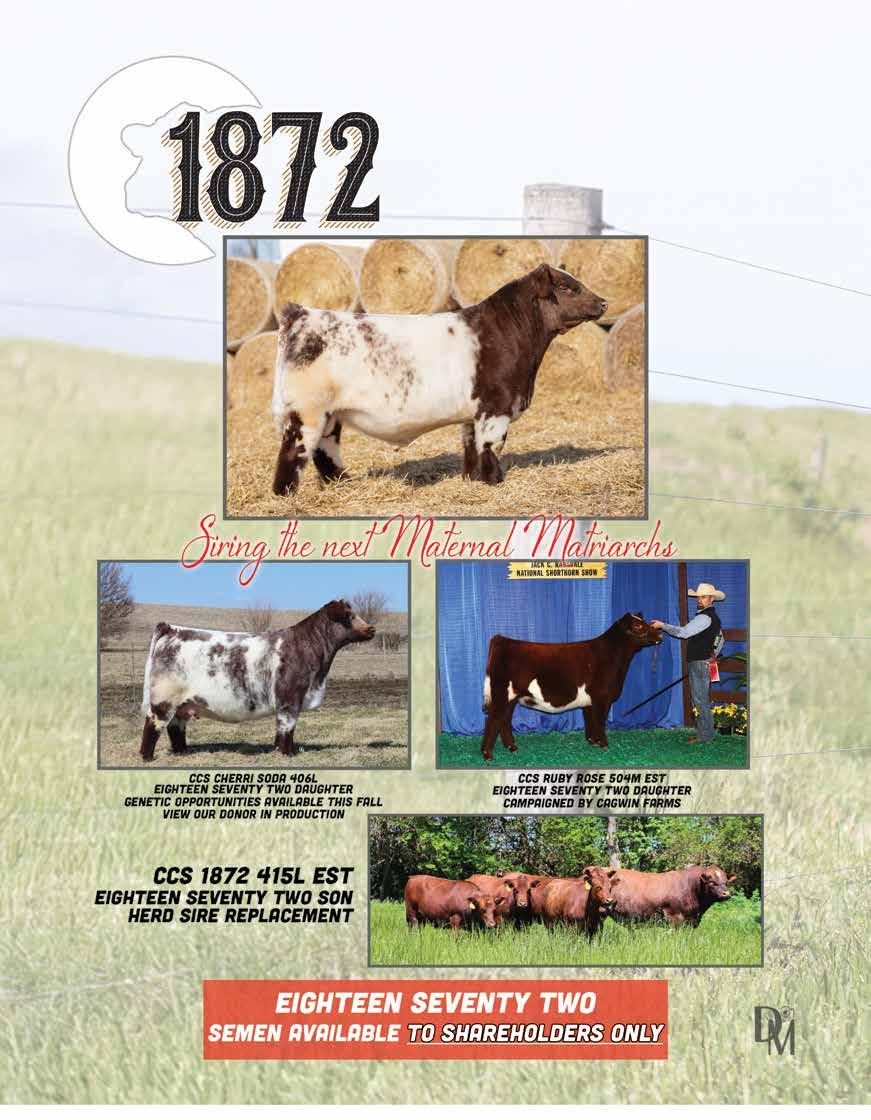



As someone who has spent a lifetime in the cattle industry, I’ve always believed performance data is one of the most powerful tools in a breeder’s toolbox.
I was raised on a family cattle operation in Kansas and have had the privilege of serving in leadership roles across several segments of the beef industry—including my time as CEO of the American Angus Association. These experiences deepened my appreciation for how reliable performance programs can drive both genetic improvement and breed sustainability.
I am honored to join as the American Shorthorn Association (ASA) as the Performance Activities Consultant, and look forward to helping Shorthorn breeders enhance the productivity and profitability of their herds by better understanding and using the performance tools available to them.
Shorthorns are known for their maternal strength, docility, and versatility. But in today’s performancedriven beef industry, even the most respected traditions need measurable improvement.
That’s why ASA offers the Whole Herd Reporting (WHR) program. This system encourages complete, accurate data submission on traits like:
• Birth weight
• Weaning weight
• Yearling weight
• Calving ease
• Maternal performance
These data points lay the groundwork for a reliable genetic evaluation.
One of the most impactful
advancements has been the use of Genomic-Enhanced EPDs (GEEPDs). GE-EPDs incorporate genomic test results into EPD calculations for more accurate predictions—especially in young animals. They offer a significant advantage for breeders marketing seedstock or making key selection decisions.
Through the WHR system, breeders submit comprehensive records that feed directly into the breed’s genetic evaluation model.
When combined with genomic data from partners like International Genetic Solutions IGS) and Neogen®, you gain a clearer picture of your herd’s future—whether selecting replacements, planning matings, or selling bulls.
No matter the size of your operation, consistent data collection can pay real dividends in herd performance, reputation, and return on investment.
To simplify complex genetic data and align selection with your breeding goals, ASA offers a suite of selection indexes. These indexes provide economic values for different production scenarios:
• $Cow Productivity Index ($CPI): Targets maternal function and longterm profitability. Emphasizes stayability, milk, weaning weight and calving ease. Best for those retaining females and focused on efficiency.
• $Balanced Merit Index ($BMI):
A complex, multi-trait index. Prioritizes calving ease, maternal milk, and moderate mature size—ideal
for producing practical, high-quality replacement females.
• $Feedlot ($F):
Designed for terminal-focused operations. Emphasizes growth and carcass traits like weaning/yearling weight, marbling, and ribeye area.
These indexes are easily accessible through ASA’s DigitalBeef platform and updated regularly with data from IGS and any GE EPDs
Performance tools aren’t just for largescale breeders. They are for anyone who wants to make better cattle. Whether you market bulls, build commercial females, improve cow longevity or are producing a show heifer for juniors, the tools are there to support your goals.
My role is to help you use them—accurately, effectively, and with confidence. From data entry to interpreting GE-EPDs and indexes, I’m here to support your success.
The future of the Shorthorn breed is being built on tradition—enhanced by innovation. Let’s take that next step together.






2025 is flying by and feels like we sprinted through the halfway mark. The State Associations Board of Directors have been updated, as well as their contact information. You can find that list of directors in this issue of the Shorthorn Country, or on the new ASA website (shorthorn.org) underneath the contact tab. If you check this list out, and see any changes or corrections, please email wade@shorthorn.org to get that updated.
The National Junior Shorthorn Show is over, and we are gearing up for our next Shorthorn events traveling to the Super Regional shows. Before we know it, it will be sale season, show season, and all around a busy fall season. Don’t forget to send in events happening within your state association for me to update and put on the website calendar. Check out what’s to come under the events tab on the website. This will help keep members informed and up to date with everything happening in the Shorthorn Breed.



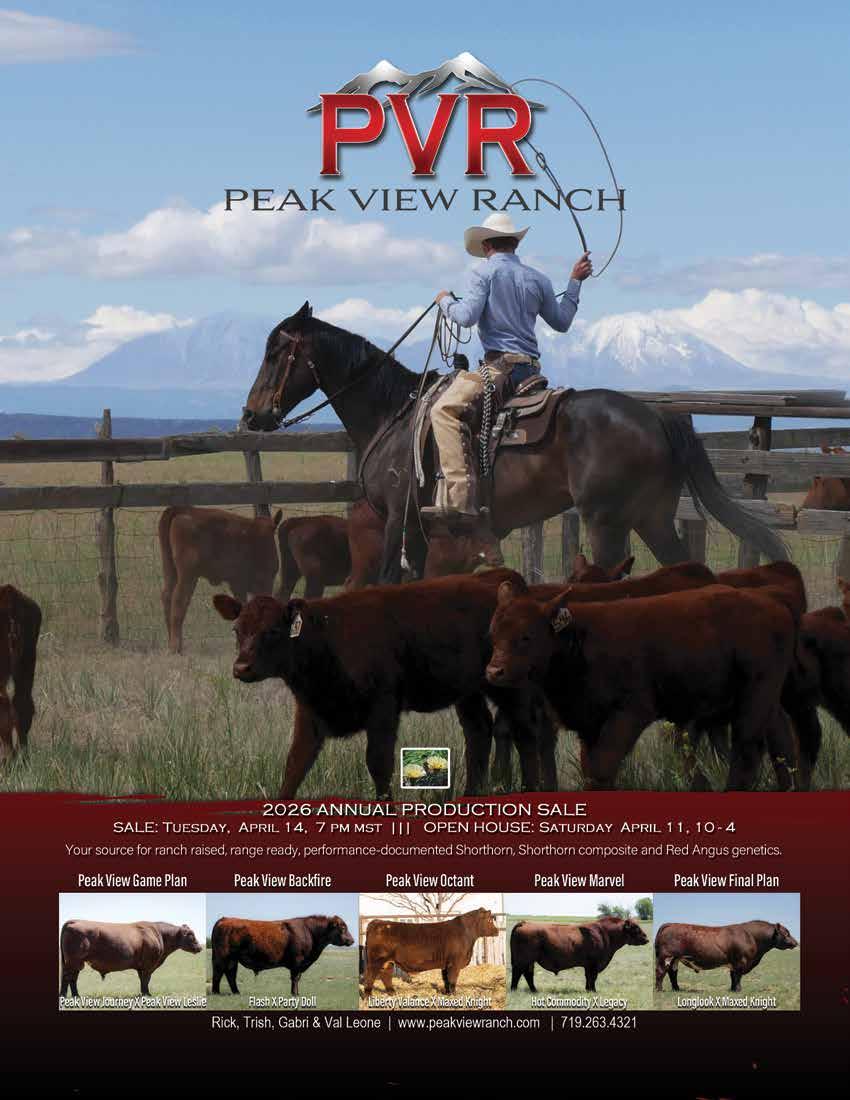




“My heifer won her class!” “I had champion bull!”, both phrases an exhibitor’s support system hopes to hear following a show. Sounds easy enough, right? Walk into the ring, celebrate your winnings! Long before any of that can happen though, there are several key steps to remember. By following them, you will be one step closer to setting yourself up for success in the show ring.
• Enter early! Take note of entry deadlines and be sure not to miss them. Avoid hassle during check-in by checking your entries (at least) twice at submission time. A headache at check-in is no fun for you or staff. Check animal details, particularly registration numbers, birthdates and tattoos for accuracy. Should you notice an error prior to the show, contact ASA staff ASAP.
• If a show requires DNA testing, such as the E.D.G.E. shows, request the testing and submit your samples early. DNA must be completed in order to compete.
• Send stalling requests with entries
and/or to ASA staff. Think of stalling assignments as one big jigsaw puzzle. Each stalling group a different piece, and each a different size and shape. The sooner we know specific needs, the better chance that we can accommodate requests. I believe the happier you are with your stall space, the more likely you are to enjoy the show!
• Remember to check show schedules for times and locations. Check-in and show start times are important to follow as to not miss any deadlines and arrival times. Missing these could mean missing the show.
o For the 2025-2026 Shows, there are several construction projects in progress or being completed, there is a possibility the schedule that has “always been this way”, may not be that way this year. Pay attention to ALL show schedules for potential changes as we get closer to shows.
At the Show
• Bring registration papers to check-in, ASA staff will accept digital or physical copies.
• If a show requires tattoo verification,
Attending an upcoming National or Super National Show?
Checkout our Bitly site to be linked to all things specific to that show!
Using your phone camera or QR code reader, scan this QR code to be linked to show information!
If you have trouble scanning the code, visit bit.ly/m/shorthornshows through your web browser. Staff will update this page for each show with schedules, stalling, show programs and live streams if available! (Scan
do so before coming to check-in.
• Show programs will be posted online and on the Shorthorn app once they are finalized. Once posted, we ask that you check the programs to ensure your animals appear in the program. Many variables affect our timeline of receiving printed programs. Printed programs may not be available until the day of show in some cases. Should you notice an error in a program, please notify ASA Staff.
• Should you decide to stay in a hotel, watch for information about host hotel blocks available through the ASA. Book early when the block opens. These room rates will be exclusive to ASA exhibitors. Once these blocks are full, rooms cannot be added.
• And finally, remember to have fun with every show!
We look forward to seeing all exhibitors and breeders at our upcoming shows and can’t wait to see you reach your goals! And as always, if you have questions regarding a show, contact Wade or Cassie!

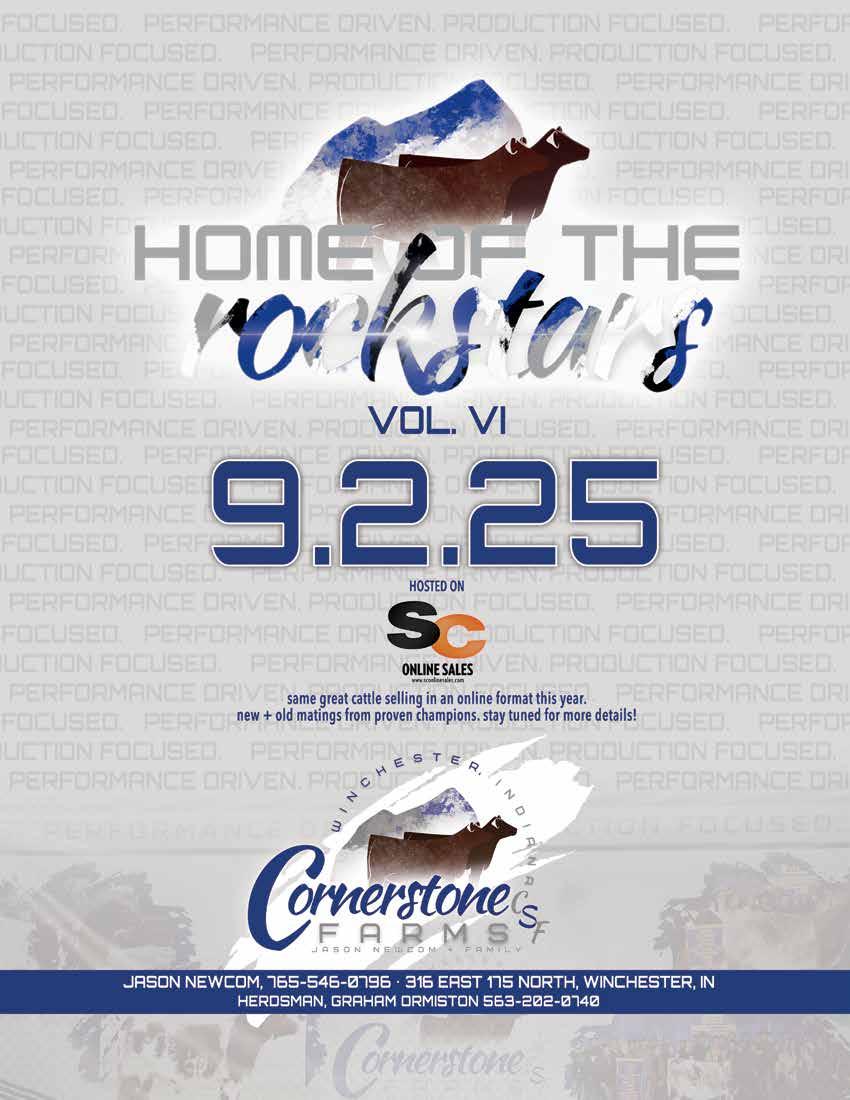

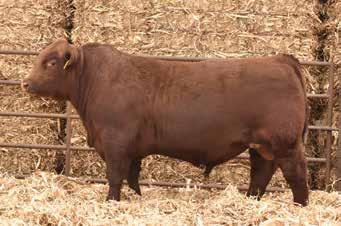
• High Seller in our 2021 Sale to Leachman Cattle of Co.
• Calving ease specialist with bulletproof calving ease
• His MB EPD is the highest in the breed and as has progeny have an average IMF ratio of 110
• Top feed efficiency bull in the 2021 Sale
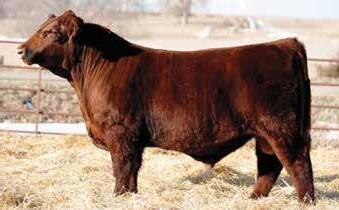
• Our pick of the 2023 Gilman bull sale and a 3/4 brother to Gilman Liberty Valance
• WW, YW, and $F are in the top 2% of the breed

• High seller in our 2022 Sale
• Balance of growth, carcass, and feed efficiency


• The do-everything sire, calving ease, growth, and carcass
• His progeny ranked in the top 25% for his first four groups tested for feed efficiency
• Suitable for use on heifers



BCHF is an acronym you will likely be hearing more and more – even in this very issue, there is another article dedicated to it. Bovine congestive heart failure can be quite the mouth-full, though, so for my fingers’ sake, I’ll stick with BCHF from here out.
We have been hearing the buzz about this newer test offered by Neogen which ranks an animal’s heart score from 1-10. This number essentially assesses the risk of BCHF developing; lower scores mean lower risk, therefore the lower the score, the better. An article in this issue titledIgenity® BCHF: A Genomic Approach for Advancing Heart Healthy Cattle, explains a lot more, so I won’t go further with the definition.
What I want to share with you regarding BCHF is how you can go
about getting your cattle tested. We have added it to our regularly offered tests, so assuming you are already familiar with the online DNA submission process, ordering BCHF testing should be a breeze. It can be ordered as an add-on to the 100K test, which is a $10 fee ($55 for 100K, so total of $65 OR if adding onto the AI Sire/Donor Dam package, a total of $95) or it can be ordered on a stand-alone basis for the regular $29 fee. If you have tested animals in the past for 100K and are interested in getting a BCHF score from that, please email us a list of animals’ registration numbers, and we will do our best to get a quick result turnaround for you – but this is only if they have already been tested specifically for 100K. Should you have questions regarding BCHF, I would recommend
reaching out to Bryce Schumann directly (bryce@shorthorn.org)
As a reminder, because we are still getting some confusion regarding the Natural Service Sire test requirement. Any bulls born 1/1/2022 and after must have 100K testing on file for their natural calves to be registered. If you are registering calves and receiving an error that reads “sire requires a genomic panel to register calves” – this is what it is talking about. If time is of the essence and you have pending calves out of bulls that still need testing – once the bull’s sample is at the lab, we are able to push said calves on through without results being in yet. As always, if you have any questions do not hesitate to reach out to the office!




by Dr. Kelsey Luebbe, Dr. Victor Pedrosa, Dr. Kirk Ramsey DVM, and Dr. Karen Schutt with Neogen
With recent genomics advancements – and the opportunity to test with Igenity BCHF through Neogen, the cattle industry can confidently select for heart-healthy herds that will uplift the industry overall and mitigate both herd health, and economic risks.
Bovine Congestive Heart Failure (BCHF) stands as a significant threat to the health and productivity of feedlot cattle. Physiologically, BCHF is characterized by a progression of cardiopulmonary changes, beginning with pulmonary hypertension, ventricular fibrosis and stiffening of the myocardium, diastolic dysfunction, and severe ventricular remodeling leading to heart failure and mortality.1
In severely affected cattle pens, mortality rates have surged up to 7%, translating to staggering annual losses surpassing $250,000 for a single operation.2 However, the causes of heart failure are often multifaceted and influenced by environmental stressors as well as management practices. BCHF is particularly challenging to address because it often manifests late in the production cycle when cattle are nearing market readiness. This timing exacerbates the economic impact, as it represents a significant loss of prior investments in feed, labor, and veterinary care. Altitude and temperature fluctuations can further complicate the issue, interacting with genetic predispositions and management practices for the onset of heart failure.
The true source of this syndrome is often difficult to determine because it may be caused by any cardiac abnormality resulting in the heart’s inability to pump enough blood to meet animal maintenance requirements. Due to the absence of definitive clinical diagnoses, the terminology describing and characterizing heart failure symptoms remains unstandardized and continues to evolve as new research is published within the scientific community.
Recent research has identified genetic markers associated with an increased susceptibility to BCHF.3 The development of standardized diagnostic criteria and early warning systems for identifying cattle showing subclinical symptoms holds promise for more effective interventions. By leveraging genomic insights alongside
improved management practices, the economic and animal welfare impacts of this multifactorial syndrome can be significantly reduced.
Igenity BCHF is a revolutionary genomic test designed to assess an animal’s genetic predisposition to heart failure, and accounts for the latest advances in research today. The test results (1-10 scores) directly correlate with the percentage of BCHF risk an animal has (and should pass on to their progeny), serving as a genetic indicator of the likelihood of disease development. A lower score on the scale is more favorable. This chart provides a comparative assessment of genetic potential rather than predictive rates. It illustrates the genetic impact anticipated in progeny, offering a reference between Igenity scores and genetic effects for BCHF. These values predict the relative profile of an animal compared to the progeny of other reported animals, where minor scores indicate a lower risk in the development of Bovine Congestive Heart Failure.
cardio-pulmonary changes resulting in ventricular remodeling and leading to reduced performance or mortality, it was imperative that heart pathology was considered in a genomic solution.
Providing a Solution for ASA Members

To create Igenity BCHF, a robust database of phenotypes (32,763) and genotypes (25,186) was assembled from animals fed at a single commercial feedlot and harvested at a single facility, which represents one of the largest single source commercial data sets of its kind.4
A subset of this reference population was also selected for genomic sequencing to determine the heritabilities and genetic correlations of the phenotypes collected and complete a genome-wide association study (GWAS). Moderate heritability of heart score (0.36) was observed, reinforcing the genetic selection potential of this syndrome.4 Because BCHF has been phenotypically characterized as a progression of
Igenity BCHF represents additive polygenic effects across the entire genome rather than the single nucleotide polymorphism (SNP) markers initially discovered at USDA-ARS, which was based on the non-additive effects of two SNPs. Igenity BCHF captures more genetic effects along the entire genome instead of a few genomic regions. With more robust marker sets, the polygenic effects can be better characterized, resulting in a more precise test. When you test with Igenity BCHF through American Shorthorn Association, you will garner your herd’s 1-to-10 BCHF score as well as an associated genomically enhanced EPD. Continue learning, at Neogen.com.
1 Krafsur, G. M., Neary, J. M., Garry, F., Holt, T., Gould, D. H., Mason, G. L., et al. (2018). Cardiopulmonary remodeling in fattened beef cattle: A naturally occurring large animal model of obesityassociated pulmonary hypertension with left heart disease. Pulm. Circ. 9(1)1-13.
2 Heaton, M. P., Bassett, A. S., Whitman, K. J., Krafsur, G. M., Lee, S. I., Carlson, J. M., & Vander Ley, B. L. (2019). Evaluation of EPAS1 variants for association with bovine congestive heart failure. F1000Research, v. 8.
3 Heaton, M. P., Harhay, G. P., Bassett, A. S., Clark, H. J., Carlson, J. M., Jobman, E. E., Sadd, H. R., Pelster, M. C., Workman, A. M., Kuehn, L. A., Kalbfleisch, T. S., Piscatelli, H., Carrie, M., Krafsur, G. M., Grotelueschen, D. M., & Vander Ley, B. L. (2022). Association of ARRDC3 and NFIA variants with bovine congestive heart failure in feedlot cattle. F1000Research, 11, 385.
4 Buchanan, J. W., Flagel, L. E., MacNeil, M. D., Nilles, A. R., Hoff, J. L., Pickrell, J. K., & Raymond, R. C. (2023). Variance component estimates, phenotypic characterization, and genetic evaluation of bovine congestive heart failure in commercial feeder cattle. Frontiers in Genetics, 14, Article 1148301.




We all know recognizable brands. Wrangler, Nike, Walmart, to name a few. Each of these companies have built their brand by marketing themselves to their desired audience. As you plan your marketing strategy, you need to identify your audience and how to reach them best. Then you can find the specific ways you can market to that audience.
In an everchanging world of technology, some marketing strategies remain strong, especially in the agricultural world. Print is still a popular source of education, information and advertisement. It is not a dead medium. And with print publications, you can find most digitally as well, reaching a larger audience. While print is still relevant in the agricultural world, it is important to market your business using several avenues.
Social media remains a strong (mostly free) opportunity for marketing your herd. Facebook, Instagram, TikTok, LinkedIn, and Snapchat are all available for your use. It is not always necessary to use them all; find what fits YOU best. Facebook is still widely used in the livestock industry even with the younger generation. It provides a way for you to
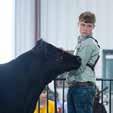

Shelby Diehm director of youth activities, director of marketing & communications
post photos, text and even stories about your herd. When you have a Facebook business page you can cross post across Instagram at the same time when you have a photo included. This makes it easy to each several different target audiences at once. TikTok/Reels are popular with the younger generations but used more for entertainment and education. You can learn some about TikTok and Reels in the Bull Pen Podcast episode featuring Tucker Brown of RA Brown Ranch. Tucker has used social media to build the RA Brown Ranch brand.
As the American Shorthorn Association, we have leaned heavily on using video for our marketing. From the American Rancher on RFD-TV to our video podcast, we have reached a large group of viewers in the agricultural industry. We also use Facebook and Instagram as a free resource to market the ASA brand. Even our website can be considered marketing. Speaking of, we just released a new website earlier this spring; take a look at the upgrade and hopefully you find it easier to navigate what you came to the site for.
When you create a marketing plan for your herd or business, it is important to
utilize several different types of media to share your brand and message. This will allow it to be seen more often by more people. Find what fits YOU best. Whenever you find what fits your operation, QUALITY is just as important as QUANITY. Be sure you are using high-quality photos for your content rather than just posting to post. Being intentional with your content will help your following grow.
Be sure to check out how you as a member can advertise via the website or the Shorthorn Insider eblast. The website homepage has a few different options to place ads to reach those who visit the website. The Shorthorn Insider goes out every other week and reaches more than 9,000 Shorthorn enthusiasts. Both offer an easy way to reach a Shorthorn audience.
Use your resources, build your brand. Find what works best for you, all while staying in your marketing budget. When you do, you can grow your business and market more effectively. Make yourself a recognizable brand.

Age: 13 Town/ State: Hiawatha, Kansas
What is one must have item at a cattle show? Why? A great selection of snacks is the one must have item at a cattle show. I say this because you have to keep yourself going.
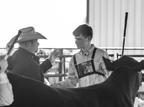
What do you want to be when you grow up? I would like to judge cattle when I get older.
What is one thing you have learned through showing cattle? I have learned responsibility and teamwork. What is your favorite cattle show you have exhibited at? Why? My favorite show is definitely the Shorthorn Jr. Nationals. I say this because you get a whole week to show off your animals and participate in contests. You also get to meet so many people from all over the United States that love Shorthorns.

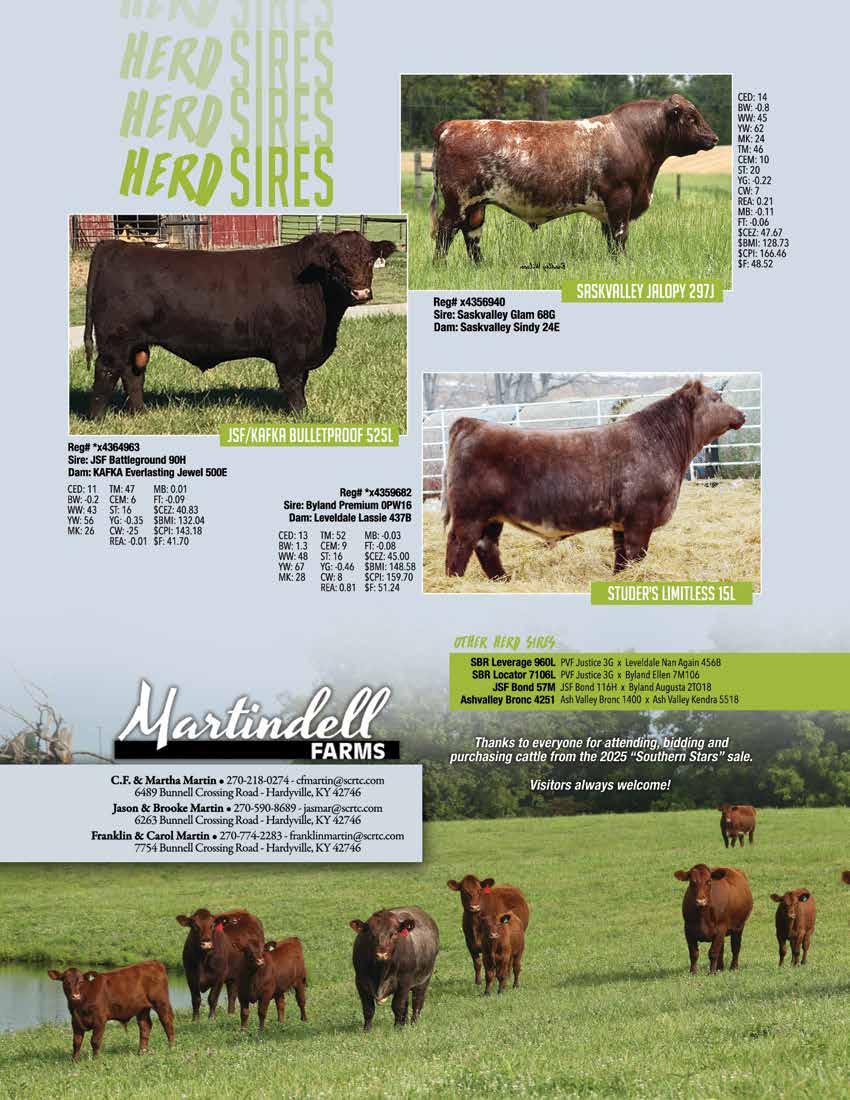


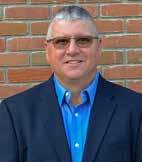
There are few things I enjoy more than talking cows with fellow Shorthorn breeders. Recently, during a conversation with a fellow breeder who had invested time in us when we first became involved with Shorthorns, I was struck by a powerful realization. The relationships we’ve built within the Shorthorn community are not just connections; they are bonds that have grown into friendships, rooted in shared passion and mutual respect.
Over the years, many of these people have become more than acquaintances. We know their families, their cattle operations, and even their professional lives. We’ve shared laughs, meals, and endless conversations about bloodlines, breeding strategies, and the future of the breed. It’s these connections that make the Shorthorn breed so much more than just a breed—it’s a family.
Our family has been involved with Shorthorns for over two decades now, and if there’s one lesson we’ve learned, it’s that this breed is rich in both exceptional cattle and exceptional people. Shorthorn breeders are a rare group—helpful, generous, and always willing to extend a hand, whether it’s sharing knowledge, lending equipment, or opening their homes during travels. The willingness to
support one another is as much a part of the Shorthorn legacy as the cattle themselves.
Yes, great cattle come and go. Bloodlines rise and fall in popularity. But the one constant in all of it is the people— the dedicated breeders, the passionate families, the young 4-H kids who catch the Shorthorn bug early and never let go. These are the people who uphold the Shorthorn name, who carry its legacy forward, and who inspire the next generation to do the same.
As we look forward, it’s worth considering how we, as a community, can continue to kindle that passion for Shorthorns in others. When we first got involved, others took the time to teach us, guide us, and inspire us. They shared their knowledge, their time, and sometimes even their living rooms. They showed us that being a Shorthorn breeder was about more than just raising cattle—it was about becoming part of a community.
Now, it’s our turn. What are we doing to light that spark in the next generation? How are we inspiring new breeders to get involved, stay involved, and become lifelong Shorthorn advocates? Are we extending that same hand of friendship and guidance that was extended to us?
It could be as simple as inviting a young family to a sale, explaining the traits of a good brood cow, or showing a newcomer the ropes at a show. Maybe it’s offering advice on herd management, or simply sitting down over a cup of coffee to share the story of how you got started. Every conversation, every gesture, every bit of shared knowledge matters. It’s these moments that build relationships—and it’s these relationships that sustain the breed.
The heart of the Shorthorn breed isn’t just found in pastures or show rings—it’s found in those moments of connection, those acts of generosity, and those lifelong friendships. It’s found in the people who call to ask how your calf crop is doing, who check in after a tough year, or who celebrate your wins right alongside you. So, as we move forward, let’s keep that spirit alive. Let’s remember those who helped us when we were just getting started, and let’s make it our mission to pay it forward. Let’s continue to build the kind of relationships that make the Shorthorn community strong, enduring, and unforgettable.
Because at the end of the day, it’s not just about the cattle. It’s about the people who make up this great breed.




Mark Gordon ASA vice president
As Shorthorn breeders, we have every reason to be proud. Over the past several years, we have seen significant growth— not only in the quality of our cattle, but in how the beef industry recognizes and values the Shorthorn breed. That growing acceptance has been hard-earned, and it’s a direct result of your dedication, your passion, and your commitment to making our cattle better.
One of the clearest signs of this progress is in the success breeders are having with commercial cattlemen. More and more Shorthorn-influenced genetics are finding their way into real-world operations, delivering the performance, efficiency, and maternal traits commercial producers demand. The result? Increased demand, repeat customers, and real profitability. That kind of success speaks louder than any ad—it proves that what we’re doing is working.
And across the show ring, that same story of advancement continues. Breeders and exhibitors have truly stepped up their game. The cattle being presented today are more competitive, better prepared, and more structurally sound than ever before. These show cattle not only turn heads—they raise the bar. Their quality reflects the genetic progress being made throughout the breed and strengthens our reputation from top to bottom. But as much as we have to celebrate, now is not the time to let up.
We must continue our pursuit of better cattle. Don’t stop what you’re doing— keep your foot on the gas pedal. Whether it’s through thoughtful breeding, honest evaluation, better management, or leveraging new technologies, every step we take forward strengthens the future of the Shorthorn breed.
The American Shorthorn Association has
been an essential partner in this progress. Tools like genomics, improved data reporting, breed promotion, and youth programs have helped give breeders the resources and visibility needed to thrive. With these tools in hand and a unified commitment to progress, we’re equipped to take the breed even further. The road ahead is full of opportunity. Let’s stay focused. Let’s stay aggressive. And above all, let’s keep working together—breeders, exhibitors, and association—united in our mission to make our cattle better, one generation at a time.
We’ve come a long way. Let’s go even further.




by Martha A. Hollida
Bill Rasor stands as a living link between WHR Shorthorns’ deep-rooted past and its promising future. As a third-generation cattleman, Bill carries forward more than a century of dedication to the Shorthorn breed, an enduring legacy now taking shape through his children and grandchildren.
The Rasor family’s Shorthorn story began in 1920, when Bill’s grandfather established the original herd in North Texas. His father continued the tradition, using Shorthorn bulls on commercial cows while operating a farming enterprise. Bill grew up showing Shorthorns, and in the 1960s, began acquiring registered cows to build upon his family’s foundation.
After earning a degree and working in banking near
Houston, Bill returned to the family farm in Allen in 1975 following his father’s declining health. He took over the farm and continued developing the Shorthorn herd.

In 1984, Bill and his wife, Becky, made a pivotal decision, not only to raise registered Shorthorns but to build a nationally competitive program. Initially they acquired genetics from the renowned Sutherland Farms, managed by Jack Ragsdale in Kentucky and later from Cates Farms in Indiana. One of their most influential purchases was a female named Sutherland Crystaleen 882, whose legacy continues in the WHR herd today.
Since then, WHR Shorthorns has become synonymous with quality, functionality, and show ring success. Bill and Becky’s children, Ann and Will, both showed champions across Texas majors. Today, the fifth generation is continuing the winning tradition, with the
grandchildren and others leading WHR cattle to top honors.
Heifers carrying the WHR prefix have claimed three national championships at the American Junior National Shorthorn (AJSA) Show—Will Rasor with WHR Crystaleen R02 in 1991, Ashley Parker with WR4 Demi 6R24 in 1997, and Catherine (Williams) Neumayer with WHR Cumberland 9R86 in 2001. All three of these winning heifers, now have over 20 registered progeny each in the American Shorthorn Association (ASA) Herdbook. In addition, these cow families continue to be an important part of the WHR breeding program.
the integrity and service WHR delivers.
“Seeing multiple generations of families come back to buy heifers is incredibly rewarding,” Bill says. “The Parker family is a great example, Gus Parker showed our heifers as a junior exhibitor and now his kids are showing WHR cattle.”

Caitlyn Rasor, now a junior at Texas A&M, recently added to the legacy with a standout female named WHR HCAT Mona Lisa 1104, sired by Continental Divide, who is a son of NBS Low Rider 42W, a bull used extensively at WHR. Mona, who racked up wins at the Houston Junior Show and twice at the State Fair of Texas, now resides in the WHR herd and is poised to begin her own cow family legacy.
The Lone Star Edition: A Tradition of Excellence
The Rasor family hosts the Lone Star Edition Sale at the ranch on the last Sunday of March. The 2025 sale marked 31 consecutive years for the event. Known for elite junior show heifers, the event also includes bred females, cow-calf pairs, and a select group of bulls. Buyers from across Texas, Oklahoma, and beyond return year after year, not just for quality cattle but for
Despite the changes in marketing over the years, Bill still personally photographs the cattle for their sale catalog and ads. WHR quickly embraced online bidding during the 2020 pandemic shutdown, and today it’s an essential part of their marketing strategy.
“You have to have quality photos and videos of every lot now,” he explains. “People will buy with confidence if they can see what they’re getting— even from a distance.”
Today, WHR runs about 150 females and utilizes AI and IVF to continue advancing cow families like Augusta Pride, Cumberland, and Cecilia.
In the 2025 sale alone, 20 lots carried Cecilia genetics, showcasing the program’s consistency and depth. WHR also markets bulls annually throughout North and Northeast Texas and Southeast

Oklahoma.
Customer service remains a cornerstone. Whether it’s providing show support or herd-building advice, WHR is hands-on with its buyers, especially juniors. Longtime team members Jeff Sargent, Chris Ellason and Will Holloway are regulars at major shows, offering support and sharing WHR’s commitment to youth.
Service to the Breed
Bill and Becky have long been active in both the Texas and American Shorthorn Associations, with Bill having served as president of both. Today, his passion lies with the American Shorthorn Foundation, which awards over $20,000 in scholarships annually and funds breed research and genomic advancement.
“We’re focused on scholarships and research—that’s our mission,” Bill says. “Thanks to strong annual supporters, we’re able to invest wisely and fund our programs through the returns.”
Family First: The Next Generations
While Bill is proud of his own contributions to the breed, his greatest pride is in watching the fourth and fifth generations thrive.
Daughter
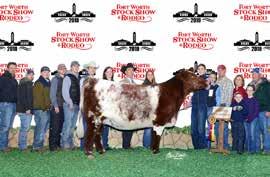
Ann, an active Shorthorn showman and Texas A&M graduate, lives on the ranch with her husband Ross Wells, who she met at college. He is an attorney specializing in eminent domain and Ann consults for

the American Meat Science Association. Their children, Beth (15) and John (13), are active in FFA, and show Shorthorns on a local, state and national level.
Son Will works in the banking industry and lives with his wife, Kim on the ranch. Their children are Quinn (23) and Caitlyn (20). They both showed champions at Texas shows and capitalized on the leadership and educational experiences of FFA. Quinn now works at Sky Ranch Christian Camps in East Texas. Caitlyn,
an agribusiness major at Texas A&M, is still eligible to show at junior nationals and is looking forward to this year’s trip to Nebraska. She is Bill’s right-hand during the summer and Christmas breaks and hopes to return full-time to manage WHR one day.
“I love the ranch. I’m very invested here,” Caitlyn says. “My grandfather is a huge role model for me, and I want to carry WHR forward.”

With over 65 years in the breed, Bill Rasor has seen fads rise and fall, embraced innovation, and weathered challenges. While today most of the farming land is leased out, he and Becky, along with the entire Rasor family, remain committed to the breed and doing their part to breed quality cattle that will surpass the coming industry demands.
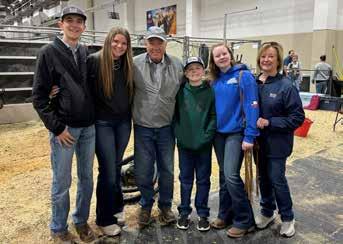



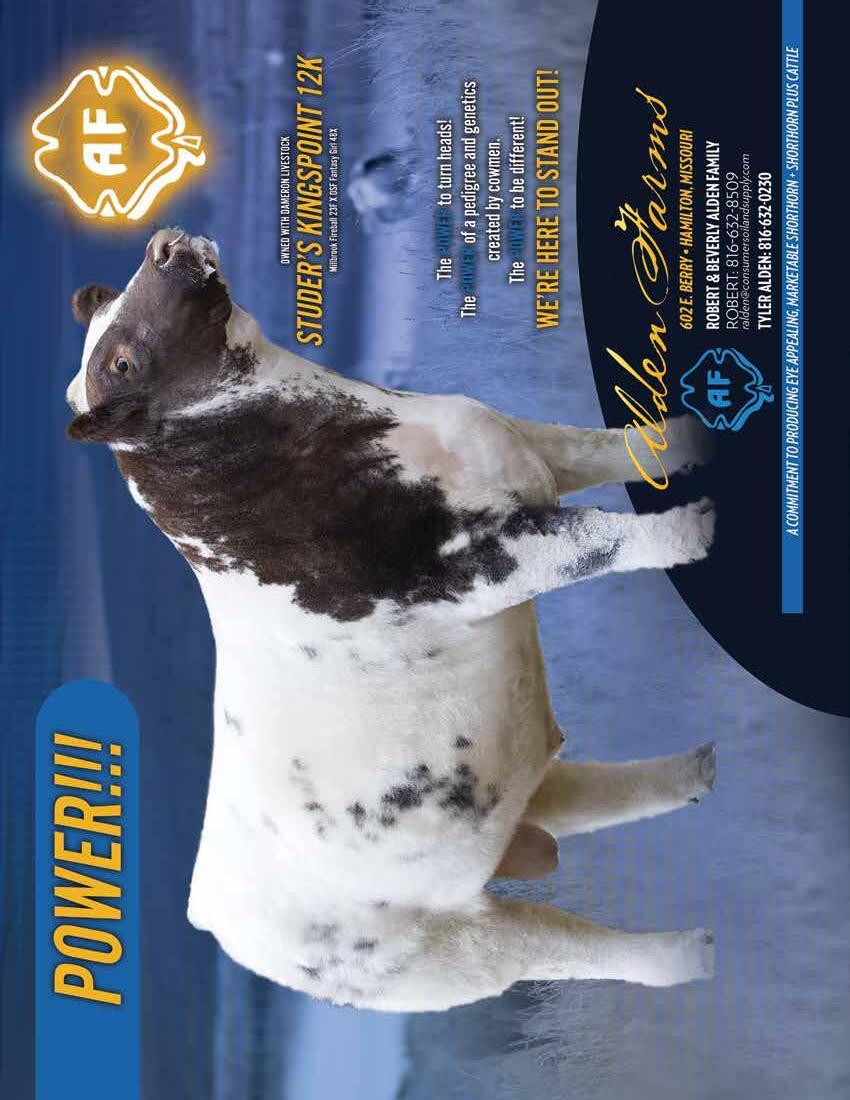
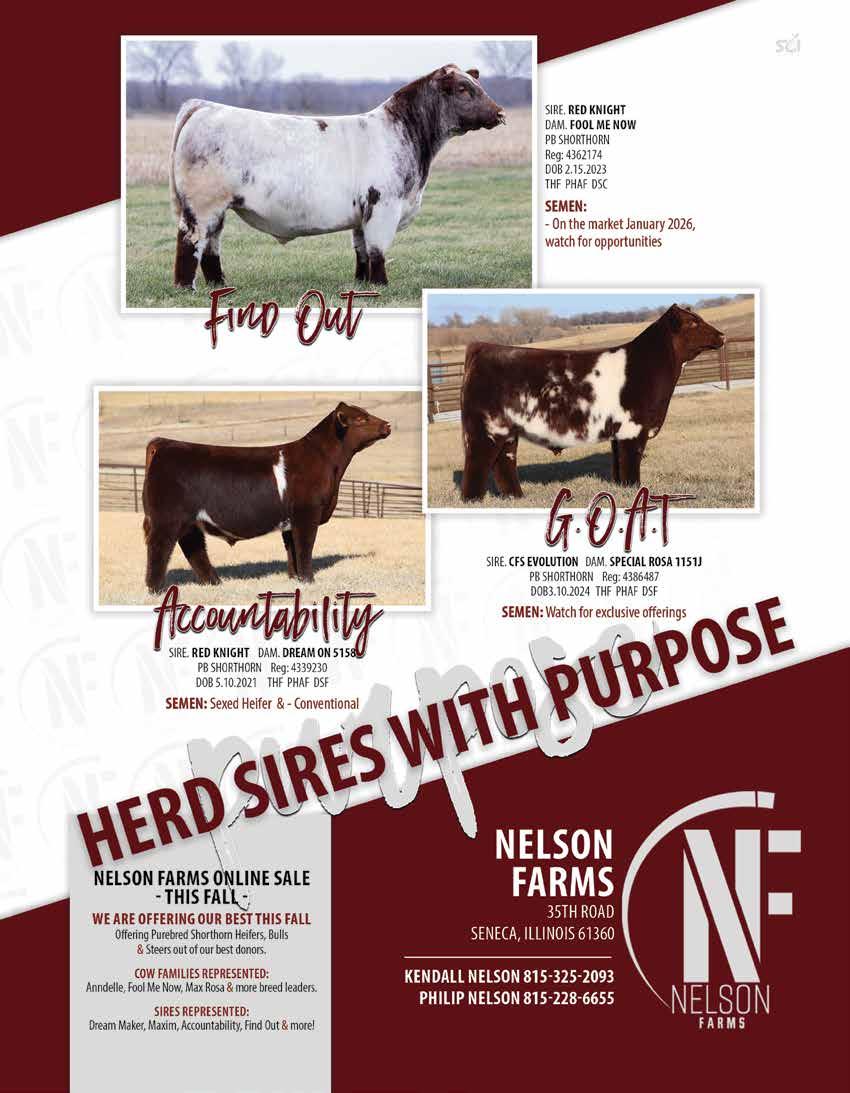

by Marty Ropp, CEO, Allied Genetic Resources and Luke Bowman, Director of Operations, American Simmental Association
Significant economic information, data, and research consistently suggest that maternal traits are two to three times more impactful to profitability than are growth and carcass traits. Despite this, many producers historically select almost solely for terminal traits when choosing their genetics, while continuing to claim that their focus is on the long term.
There is no doubt that advancing terminal and meat quality traits are crucial for the success of the beef industry as a whole, but this need not come totally at the expense of enterprise profitability. Even poorly thought-out decisions, like not utilizing planned crossbreeding and hybrid vigor in the cow herd, are terminal choices that erode profitability far out into the future.
Certainly, there are circumstances where producers should select largely or even solely select for terminal traits. Producers who do not retain any replacement females from their herds should absolutely prioritize terminal value. Also, those who plan to exit the business in the next three years can focus solely on terminal traits. These folks exiting the industry without new generation succession on the ranch, well, they might be best off to just harvest those calf crops off the land with as much weight and gross income as possible.
For the majority, however, who keep their own replacement females and value enterprise success for the long term, maternal, value-generating genetics are crucial in the majority of genetic decisions. For the increasing number of producers purchasing their replacements, it is critical to ensure whomever you purchase from is prioritizing maternal traits, and not simply marketing weight and terminal value.
This is where the American Shorthorn breed has long had an edge; a history built on maternal excellence. Shorthorn genetics, when managed with intention, create a cow herd that sticks around, pays her way, and leaves daughters that do the same. It’s a breed known not just for carcass value or docility, but for cows
that generate generational returns.
Fortunately for the beef industry, marbling is the overwhelming influencer of carcass value today, and it is not strongly correlated to fertility or longevity traits either positively or negatively. The only scenario where there may be a relationship between marbling and maternal traits is when a genetic line may have been selected highly for a specific trait like marbling with little or no selection for fertility and longevity traits. In that specific case, if a genetic line is limited to a small number of highly influential sires, the artificially high genetic influence of these selected sires could create issues in the maternal trait complex. This is not because the traits are highly correlated, but instead because their negative maternal genetic effects were so highly concentrated due to single trait selection bias on that population with no available tools for co-evaluation of high-value maternal profit genetics.
As stated, it is clear that today the focus of genetic selection is leaning toward terminal traits, without a solid plan to maintain profit in the long run. Across all breeds, purchasing big, stout bulls with the most growth genetics, at a high price, is becoming the norm. While there is appeal to this plan, it doesn’t consider future implications. Most of these sires are genetically terminal. Traits like actual weaning weight are easy to promote and have been pushed for generations, and it’s simply easier to sell the short-term hope of bigger calves 18 months from now.
The benefit of maternal traits, which aren’t fully realized for many years and several generations in the cow herd (5 to 15 years), can be much more difficult to market. Saying, “Buy these bulls and in eight to ten years you will be very happy and more profitable,” is a tough, but important sell. Most producers envy those trouble-free and profitable cow herds, generated by many years of commitment to cow profit traits. In fact, we often try to buy females from herds where maternal traits have been prioritized long term. Still, the promise of heavy calves in the near term distracts producers from longer-term goals.
But let’s be honest: there’s no shortcut to a durable, low-maintenance, high-
output cow herd. Those herds didn’t happen by chasing the next flashy but terminal sire. They were built by disciplined selection, a need for efficiency, and prioritizing maternal function every single generation. In other words, the long game wins.
These shortsighted decisions will likely cause operations to suffer through cows that are too expensive to maintain and leave the herd much too quickly in the future. When these females become too expensive to maintain, producers might blame anything from the breed of bulls used, to management systems like health or mineral programs. The bottom line is that your genetic decisions will absolutely affect your enterprise profitability for years and years to come, which is why selection for genetics that promote cow longevity, reduced cost, and ultimately profit, is so important. It’s imperative that the industry doesn’t repeat the mistakes of the 70s, 80s, and 90s, which ultimately forced producers to make drastic genetic changes, or even exit the business.
There is historical marketing and selection bias shared by many promoters for pounds and “power.” The old adage “we sell cattle by the pound” is true, but can be misleading, as it may have little or nothing to do with actual, long-term enterprise profitability. While it is true that many commercial producers sell calves by the pound each year, there are much better measures of total gross sales than just individual calf weight. Total weight produced by the same cows can also be greatly affected by maternal traits that are not related to and can even be antagonistic to growth.
More calves weaned per cow exposed, less dystocia, faster return to estrus, more calves born in the first 21 days of the breeding season, and a higher percentage of calves born to mature cows than heifers because of greater cow longevity; these are all non-growth-related factors that deliver added income with little or no added cost of production. The bottom line is that when it comes to selecting for growth traits, none of the extra pounds of calf generated come for free.
Individual cow costs are not equal. Therefore, evaluating a cow based on
how large the calf she weaned doesn’t paint the full picture, especially if she produced a calf that put enough stress on her system that she bred back late or came in open. Cows that produce these high weaning weight calves are often larger, require more feed and resources, and as a result may often stay in the herd for a shorter period of time. As a rough example, a 1,600-pound cow will consume approximately one ton more delivered winter feed than one that weighs 1,200 pounds (based on 150-day feeding period). Certainly, summer and long season stocking rates are reduced as well based on forage consumption, and that difference results in the potential to graze fewer cows on the same land base. A heavier cull cow does return more salvage value, but after ten years of added maintenance it certainly isn’t enough more. Also, heavier calves bring less per pound, so the value of each additional 100 pounds of weaned calf is much less than the last 100 pounds. If those resources were used to make more calves instead of just heavier ones, the value of each pound of calf produced for the operation would be significantly higher.
500 pounds @ $3.50/pound = $1,750 (Every pound produced is worth $3.40)
600 pounds @ $3.20/pound = $1,920 (+$170 or per $1.70/additional pound)
700 pounds @ $2.90/pound = $2,030 (+$110 or per $1.10/additional pound)
We well know that the number of live calves a female produces and the earlier she calves in the calving season have profound effects on lifetime production and therefore reduce the costs associated with developing her replacement. Most of us attribute added longevity to fertility, but other genetically influenced traits like milk yield, efficiency, mature cow maintenance requirement, environmental adaptation, physical structure, and even disposition can and do affect cow longevity and profit. Crossbred commercial cows, on average, last at least one year longer in production than their purebred counterparts.
Having emphasized the importance of maternal, long-term trait selection, it’s important to note that terminal traits are still significant. Improving genetics for efficient growth, carcass yield, and marbling are crucial for the success of the larger beef industry. Down-chain, other segments face cost increases too, but they only live with the genetics that are delivered to them for a relatively short period of time, compared to a cow-calf operation (6 months vs. 10+ years). With that in mind, segmenting production seems like a pragmatic solution to general improvement for all segments. Perhaps some of these arguments and skyrocketing costs of production might finally drive the commercial beef business into a future with maternal herds and terminal herds, even on the same ranch. The idea being able to generate maternal genetics to help produce the lowest-cost and longest-lived females possible, then cordon off a large segment of the nation’s cow herd to be mated to terminal options to create the most profit those cows can generate. It works in other industries, but these structures have just been a harder sell for many in the beef business, partially because of the relatively low reproductive rate in cattle and the unique management challenges of the beef industry. Despite those traditional hurdles, we will likely see more maternal vs. terminal production herds as we move into a more efficient and precisely managed future.
We are learning more every day about which genetics make the most profitable commercial females for the beef industry, and the results will be sobering to many who have always been fixated on a specific phenotype. Sure, there are crucial phenotypes related to cow longevity. Udder longevity, feet longevity, appropriate (but not extreme) body condition, and other factors have merit to evaluate. Those traits matter for maximum longevity and profit.
The myths about the big, stout, square-hipped, over-fleshed, stoutboned, feminine-headed, massive-bodied cow being the longest-lived and most profitable commercial cow, however, just aren’t panning out. Expect some surprises
when the dollars are really counted. Cows that produce the most profit over their lifetime in the commercial sector are apt to being below average for size, average muscled at best, more refined appearing, definitely crossbred, and maybe even a little “plain,” at least based on today’s definition. We are discovering it is far better to find the more profitable cows and select for their genetics and physical attributes than it is to decide the physical attributes we prefer up front and hope they are the same as the ones that generate the most profit to the ranch and the larger beef business
Phenotype = Genetics + Environment or P=G+E
Thankfully, the American Shorthorn Association has solid genetic and genomic evaluation tools. The maternal index, $CPI, can help Shorthorn breeders move cow longevity and enterprise profitability in a positive direction, faster, and more consistently. The old adage that “maternal traits are lowly heritable, so we can’t make much progress,” has led to plenty of misunderstanding. Genetics actually play an enormous role in maternal profitability; it was just our challenges with measuring those traits accurately and consistently that made the “E” (Environment) such a large part of the equation and the “G” (Genetic) component seem so small, resulting in low heritability estimates. Now that we can better evaluate fertility, longevity, and the other factors involved in the maternal trait complex, that the realized heritability is improving each and every year.
The suite of genetic tools provided by the American Shorthorn Association from International Genetics Solutions (IGS) should be used when making bull buying decisions more often, rather than fixating on marginally useful, often unrepeatable, and highly variable data like actual weaning weights. And if more maternal trait tool use and emphasis is employed by the Shorthorn membership, our cow-calf operations will definitely have a longer and more profitable future, guaranteed.



by Wade Minihan, ASA director of shows & member communications
As many of us have experienced, mail is taking longer and longer to arrive these days. We have also received feedback that people are failing to receive their DNA blood and/or hair cards due to getting lost in the postal service; which is out of our control. In an effort to help solve the problem, we have updated our DNA card request process.
DNA cards can still be ordered at shorthorn.org, however, there are two options now. The first option is to request nine DNA cards or less. These cards will be processed at the American Shorthorn Association and mailed out from our office. With this request option, we will offer two shipping options, standard USPS or 2nd day UPS with tracking. Cards being mailed by standard mail will be mailed from the
ASA office every Thursday.
The second option for DNA card requests is directly through the NEOGEN website. This process is linked on shorthorn.org to directly order DNA (hair or blood) and ALLFLEX tissue sample kits from NEOGEN. This would be for ten or more card orders. NEOGEN requires a ten-card minimum when ordering hair or blood cards. When ordering cards through NEOGEN, simply type hair card, blood card, or tissue sampling unit into the search bar at the top. Tissue sampling units can only be purchased directly from NEOGEN; not through the ASA. Once you have added/selected your desired amount; you will proceed to the checkout. You will need to create an account with NEOGEN during the
checkout process.
In an attempt to serve our members better, we will now be offering DNA blood and hair cards at our ASA sanctioned shows. Save time and shipping costs by ordering ahead from us to deliver at the shows we attend. You can contact Wade or Cassie prior to the shows, or at the shows to obtain those cards. You can pay for preordered cards when picked up at shows with cash or card, or be billed via your DigitalBeef account.
When sending your DNA samples and form to the lab, we recommend sending with tracking. This will help you, the member, guarantee you know when/ if your sample has been received at the lab.




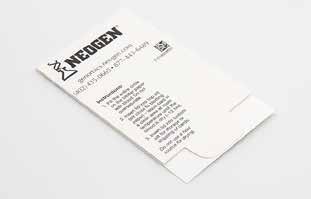

by Wade Minihan, ASA director of shows & member communications
A question we’ve been asked a million times, and then some, “How are judges selected for the ASA Point Shows?”. By sharing how this process works, we hope our members can better understand how a judge is selected for a show. We would like to say this is an easy task, like drawing names out of a hat, but it is a process that we take our time on, in an effort to select the best possible judges available. The American Shorthorn Association Show Committee and Staff work together on this project over a five month period to complete judge selections.
Throughout the year, our show committee and staff compile a list of judges. We watch other shows and reach out to fellow breed associations to ask for feedback on judges they have previously used. Each year, we compose this list by August 1st and begin the judge voting process for the next show season. This means that in August of 2025, we will begin working on the judges for the 2026-2027 Show Season. Once we have that list, ASA staff sits down and weeds out the judges that do not meet the requirements best suited for the Shorthorn breed. A judge recommendation may be removed from the eligible list if they have recently judged a Shorthorn show and need a break for a year or two, or judges that may not be able to judge to the level we expect. By examining this list, we allow for a rotation in judges at shows and sometimes, even invite a “new to us” judge the opportunity to step into our breed and judge a smaller show before moving onto larger shows in the coming years. Once that list has been narrowed down, we filter the judges into show levels they are qualified to judge: Super National, National, and Super Regional/ Regional. A judge may be eligible for multiple levels but will only judge one
show each Show Season.
Once judges have been filtered into judging levels, the list is taken to the ASA Board of Directors for approval, usually occurring in September. After that, the work of selecting judges begins with a voting process completed by the members serving on the show committee. Every other year, the show committee ranks the National shows on the importance of each show. This order of priority sets the voting order for selecting Super National and National judges. We start with the most important voted show and work our way down. Each show (or round) begins with eight judge options for the committee to vote on. The committee has 24 hours to cast a vote for each round. The committee chair abstains from voting, unless a tie breaker is needed. A majority vote is required for the judge to be selected. Once a judge has been chosen for a show, a second round of voting occurs to select an alternate judge for the show. We do this for all two Super National Shows and five National Shows, usually finishing up in mid-late November.
Once we have wrapped up the National show judge selections, we move onto the Super Regional and Regional judge voting, which is a bit different. The show committee is provided with a list of judges, and they vote either yes or no if they do or do not think a nominated judge should judge a Super Regional or Regional show. Each year, 15 judges are utilized for Super Regional and Regional shows, which requires a large list of names to pull names from. Once the voting is complete, we organize the list from judges with the most yes votes to the least. The judges with the highest number of yes votes are sent to the Super Regionals and then work our way down the list until we have sent a judge to
every show. This list can become jostled as judges are contacted, and not able to judge due to many scheduling conflicts for various reasons.
This whole process from start to finish takes about five months to complete. The show committee works diligently with us to provide the best set of judges for all our ASA point shows. We certainly appreciate their time and efforts put into selecting judges for our ASA Point Shows each and every year. The show committee is always open to judge recommendation and suggestions from the members to bring back to the committee. We understand that not every person is going to love all judges, but a part of everyday life is dealing with things we don’t like.
A quote I think describes this well is “I don’t care for their presence, but I love the beauty of this world, the warmth of the sun, the laughter of children. Life is full of things to cherish, even if not everyone is one of them.” -unkown
Chair- Jeff Bedwell
Vice Chair- Josh Berg
Tyler Cates
Cory Schrag
Mark Blaninkship
John Allen
Josh Greenhorn
Rick Leone
Christy Campbell
Mitchell Smith






(E.D.G.E. Show for Cattlemen’s Congress + NWSS) Purebred Shorthorn Only Show Season: April 1, 2025 - March 31,
1. All animals must be registered as purebred Shorthorn in the records of the American Shorthorn Association (ASA) at the time of the show.
2. ASA will accept electronic registration papers at ASA sanctioned shows for check-in, unless otherwise stated by the hosting show rules.
3. All animals must have a birth weight and weaning weight recorded in the registry.
4. All animals must have a 100K Genomic testing sample submitted and received at the lab by November 1.
5. The fair/show must adhere to the below divisions for all Shorthorn Shows regardless of entry numbers. Age divisions are not flexible.
6. The show will be judged by a panel of three judges on both phenotype and genotype. The same judges will judge both portions of the show.
7. Genotypic and phenotypic components will be evaluated as separate proportions in this show. Both genotypic and phenotypic components will have equal parts in the overall tabulation (50% genotypic/50% phenotypic).
8. Genotypic judging will take place prior to exhibition in the phenotypic portion. During the phenotypic class, the judge will be provided with animal birthdates and placed on phenotype. During divisions and overall championship drive, EPDs will be provided, and the judge will be asked to rank the group of cattle using both phenotype and genotype.
9. The top two animals in a class will be announced and advance onto the division classes. If a tie occurs in class, EPDs will be provided to the judge.
10. Females 20 months of age on the day of the show need to have a pregnancy verification signed by an accredited, non-owner veterinarian at the time the female is processed for the show. If verification cannot be produced upon request, the exhibitor is allowed to find a qualified veterinarian to verify pregnancy prior to time of show.
11. Senior Yearling Females who have calved will show based on age and will show without the calf at side. Cow/Calf pair classes will not be offered.
12. All Shorthorn cattle are subject to a tattoo inspection, parentage DNA testing, an age inspection and/or females 20 months of age on day of show are subject to a blood test to prove pregnancy if deemed necessary by the ASA. The decision of an examining veterinarian is final.
IMPORTANT: Each of the following classes MAY be broken into multiple classes to accommodate large numbers of entries, but separate classes may NOT be combined into one. For example, there MAY be four “Junior Heifer Calf” classes, but “Late & Early Spring Calves” may NOT be combined into one single “Spring Heifer Calf” class.
Class numbers provided below are an example format, each fair and/or show may renumber each class and division as needed. Female Classes & Divisions – Entry in this show binds the exhibitor to all regulations pertaining thereto.
Bull Classes & Divisions – Entry in this show binds the exhibitor to all regulations pertaining thereto.
Shorthorn
1 Late Spring Bull Calves – calved after May 1, 2025
2 Late Spring Bull Calf Champion
3 Late Spring Bull Calf Reserve Champion
4 Early Spring Bull Calves – calved between March 1 and April 30, 2025
5 Early Spring Bull Calf Champion
6 Early Spring Bull Calf Reserve Champion
7 Junior Bull Calves – calved between January 1 and February 28, 2025
8 Junior Bull Calf Champion
9 Junior Bull Calf Reserve Champion
10 Winter Bull Calves – calved between November 1- December 31, 2024
11 Senior Bull Calves – calved between September 1 and October 31, 2024
12 Senior Bull Calf Champion
13 Senior Bull Calf Reserve Champion
14 Summer Yearling Bulls – calved between July 1 and August 31, 2024
15 Late Spring Yearling Bulls – calved between May 1 and June 30, 2024
16 Intermediate Champion Bull
17 Intermediate Reserve Champion Bull
18 Early Spring Yearling Bulls – calved between March 1 and April 30, 2024
19 Junior Yearling Bulls – calved between January 1 and February 28, 2024
20 Junior Champion Bull
21 Junior Reserve Champion Bull
22 Senior Yearling Bull – calved between July 1 and December 31, 2023
23 Two-Year-Old Bulls – calved between January 1 and June 30, 2023
24 Senior Champion Bull
25 Senior Reserve Champion Bull
26 Grand Champion Bull – chosen from Late Spring Calf, Early Spring Calf, Junior Calf, Senior Calf, Intermediate, Junior & Senior Champion Bulls
27 Reserve Grand Champion Bull – chosen from Late Spring Calf, Early Spring Calf, Junior Calf, Senior Calf, Intermediate, Junior, and Senior Champion & Reserve Champion Bulls
–

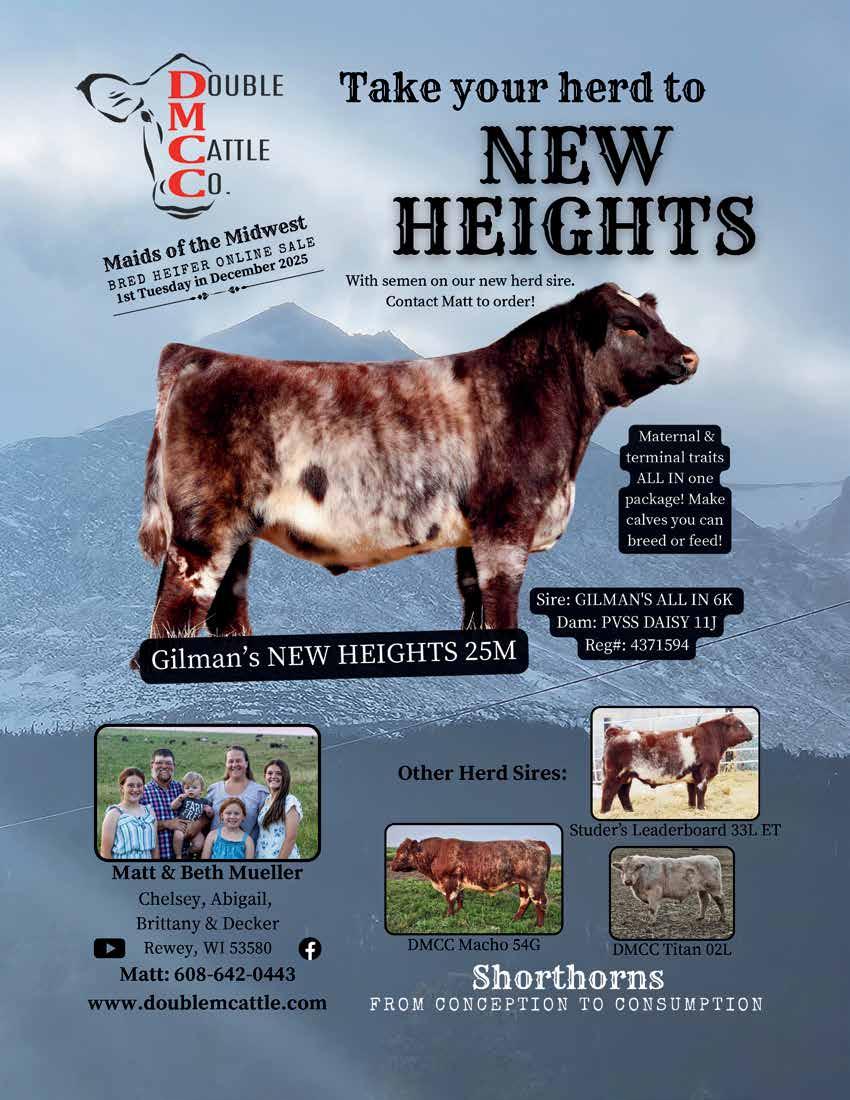
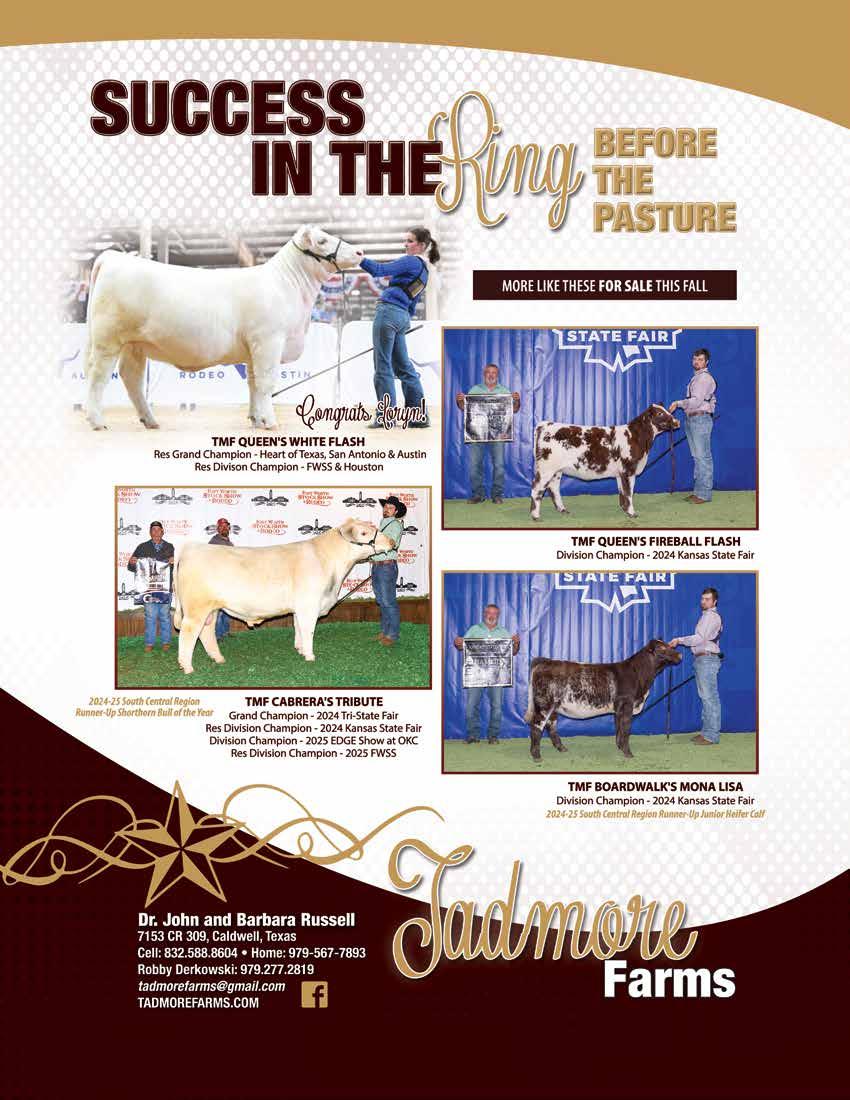

Shorthorn Breed Improvement Committee *NEW*
Chair, Cory Bollum (507) 279-0480 cdbollum@hormel.com
BOD Rep., Tyler Cates (765) 576-0035 tylerncates@yahoo.com
BOD Rep., Cary Gilman (515) 360-6006 crgilman@coonvalleytelco.com
BOD Rep., John Russell (832) 588-8604 tadmore@gmail.com
Members at Large, Ross Mosteller (785) 541-1012 redcowfamily@gmail.com
Members at Large, Cory Schrag (605) 941-5241 cory@605sires.com
Members at Large, Andy Scott (405) 650-5249 lynn_racer@yahoo.com
ASA Representative, Bryce Schumann (785) 424-0360 bryce@shorthorn.org
ASA Staff, Montie Soules (918) 645-4322 montie@shorthorn.org
Shorthorn Senior Show Committee
Chair, Jeff Bedwell (580) 822-5590 jeff.bedwell@okstate.edu
Vice Chair, Josh Berg (641) 832-7772 jaberg03@gmail.com
ASA Staff, Cassie Reid (816) 599-7777 cassie@shorthorn.org
ASA Staff, Wade Minihan (816) 599-7777 wade@shorthorn.org
ASA Staff, Montie Soules (918) 645-4322 montie@shorthorn.org
Auto Appointed, Cates Farms, Tyler Cates (765) 576-0035
Auto Appointed, Schrag Shorthorns, Cory Schrag (605) 941-5241
Auto Appointed, Lost Diamond B, Mark Blankinship (405) 334-2401
Elected, John Allen (724) 321-3163
Elected, Josh Greenhorn (937) 681-1948
Elected, Rick Leone (719) 468-1981
Elected, Christy Campbell (937) 533-7051
Elected, Mitchel Smith (765) 606-6224
Shorthorn Junior Advisor’s Committee
Appointed by AJSA Board, Joe Bales
Appointed by AJSA Board, Jeff & Darla Aegerter
ASA Board Liaison, Jeff Aegerter (402-641-4696)
ASA Staff, Shelby Diehm (816) 599-7777
ASA Staff, Montie Soules (918) 645-4322
Nominating Committee for Board Candidates
Chair, Joe Bales (615) 330-2342
Jeff Byers (419) 651-7293
Ross Mosteller (785) 541-1012
Bill Rasor (214) 850-4690
Nate Studer (641) 344-8487
Shorthorn Youth Development Fund Foundation
Jeff Agerter, President
Lee Miller, ASA Board Liaison
Shelby Diehm, ASA Representative
Julie French
Nancy Grathwohl Heter
Jerry Nickels
Keven Wendt
Montie Soules
President, Lee Miller paintvalley81@gmail.com 330-231-6834 2020-2026
Vice President, Mark Gordon markwpgordon@gmail.com 217-737-7905 2020-2026
Executive Director, John Russell tadmore@gmail.com 832-588-8604 2019-2025
Director, Jeff Bedwell jeff.bedwell@okstate.edu 580-822-5590 2021-2024
Director, Rick Osterday rsosterday@venturecomm.net 605-281-1175 2022-2025
Director, Cory Bollum cdbollum@hormel.com 507-279-0480 2023-2026
Director, Tyler Cates tylerncates@yahoo.com 765-576-0035 2023-2026
Director, Jeff Aegerter jeff.aegerter@gmail.com 402-641-4696 2024-2027
Director, Cary Gilman crgilman@coonvalleytelco.com 515-360-6006 2024-2027
Lee Miller, president
Mark Gordon, vice president
John Russell, executive director
Montie Soules , executive/CEO
Finance Committee Chair, Rick Osterday
President, Lee Miller
Vice President, Mark Gordon
ASA Director, Jeff Aegerter



Tucked in the rolling hills of southern Ashland County, Twin Oak Farms of Perrysville, Ohio, has been raising cattle and farming for seven generations. What began in 1831 as a single homestead has endured the test of time, growing into a successful beef and crop operation.
Today, Jason Workman leads the family’s Shorthorn cow-calf operation, caring for 150 cows and 500 acres of crops. With help from his family and local conservation partners, Workman uses modern agricultural practices to raise high-quality beef while preserving the land that has sustained their family for nearly two centuries.
This spring, Workman and his parents, Fred and Cami Workman, were recognized by the Ohio Cattlemen’s Association as the 2025 Environmental Stewardship Award winners. The award honors Ohio farms demonstrating a strong commitment to caring for their land, water, and livestock while operating sustainably.
The Workmans are no strangers to conservation.
“The first contour strips in Ashland County were here on our farm,” Workman said. “My great-grandfather, Joe Cowen, served on the first Ashland Soil and Water Conservation District board back in 1944. My grandpa, Barry Cowen, was a supervisor for the board as well.”
Family members have been named Outstanding Cooperators by the Ashland SWCD three times since 1967.
“There have always been cattle and crops on this farm since the beginning, and conservation has been implemented through the generations and passed down. We have all tried to grow on that,” Workman said.
Pasture care is a top priority at Twin Oak Farms.
“We soil sample the pastures. I treat them just like I would a regular row crop field,” Workman said.
The pastures are sprayed for broadleaf weeds and frost-seeded annually. The cattle are rotationally grazed and moved as needed based on pasture conditions.
The Workmans fenced the streams to keep cattle out and constructed creek crossings for cattle movement. Concrete feeding pads in the pastures reduce mud during the summer months, and approximately 2,400 feet of heavy-use driveways help move cattle between
paddocks without damaging the soil.
“We have developed three natural springs to reduce how far the cattle need to travel for water,” Workman said. “We have also installed automatic waterers in some of the pastures.”
Each year, Workman finishes around 120 steers for direct-to-consumer sales. Beef is marketed at farmers’ markets, sold to restaurants, and local stores. Breeding stock is also sold at auction.

In 2021, Twin Oak Farms sold the highselling Shorthorn bull at the Ohio Beef Expo.
“We started selling direct-to-consumer beef in 2018 or 2019,” Workman said. “People kept coming back for meat, and in conversation, they said they wished they could get smaller amounts instead of buying a quarter or half. So we started offering individual cuts.”
The COVID-19 pandemic significantly increased demand.
“COVID was huge for us in terms of demand,” Workman said. “Now we go to three farmers’ markets and sell to a couple of local restaurants and grocery stores. My wife, sister, and other family members help with the markets.”
All of the farm’s grain supports the cattle operation.
“We grow corn, spelts, and hay. Most of our hay is alfalfa-orchardgrass or cloverorchardgrass,” Workman said. “Roughly 90% of our hay is wet-wrapped for better feed quality. We grind everything here and only purchase a few minerals and protein supplements.”
The farm’s row crop ground is managed with no-till practices and includes waterways, cover crops, and a corn and spelts rotation.
One of the most recent conservation projects is a 1,500-foot culvert and 12-inch underground tile system that captures runoff from the nearby road. The system prevents excess water from flooding the pasture that runs alongside it.
Workman is also building a new barn and manure storage system. The barn will provide winter housing for the cattle, protecting pastures from overuse and reducing erosion.
“The conservationist in me made me want to do the manure management program,” Workman said. “I worked with the engineers from Natural Resources Conservation Services and Ashland SWCD to create a plan, then worked with Darryl Young from Ambassador Engineering in Ashland to lay out the design and build the system.”
The new dry pen pack storage will hold six months’ worth of manure. This allows for better timing and prevents spreading during wet conditions.
“The biggest thing is, we won’t have to be rutting up fields and spreading when we shouldn’t be,” Workman said.
Being located just a few miles from Mohican State Park, one of Ohio’s top outdoor destinations, adds another layer of responsibility to the Workmans’ conservation efforts. With visitors, neighbors, and community members passing by regularly, the family remains mindful of how their farm is viewed from the outside. “Public view is important,” Workman said. “We’re conscious of the public view. Part of the reason this barn is going in is to eliminate the mud and make things look nicer.”
Every time Twin Oak Farms has implemented a new conservation practice, the benefits have been clear.
“When we first started rotational
grazing, our pastures became healthier right away. Now that we’ve been doing it so long, I’ve learned to manage it more precisely,” Workman said. “If there’s a wet spot, I can watch the weather and keep the cattle out until it dries. I can guide where they gather for shade if they’re starting to overuse an area.”
As the seventh generation to work the land, Workman feels a deep gratitude for those who came before him, and a responsibility to those who will follow.
“I’m glad the farm is still here so I have
the opportunity to be part of it,” he said. “I’m motivated by the next generation, my granddaughter, nieces, and nephews. I want to leave it better for them than I found it.”
That mindset makes the Ohio Cattlemen’s Association Environmental Stewardship Award so meaningful to him.
“It’s an honor. There are a lot of cattlemen I look up to who reached out to congratulate me,” Workman said. “I don’t like being in the spotlight, but when people who have been in the industry

longer than you recognize your work, it really means something.”
Providing quality beef and building relationships through local markets has only deepened that purpose.
“I’ve made tremendous friendships through the farmers markets,” he said. “When people say, ‘Don’t stop doing what you’re doing because it’s the best beef I’ve had,’ that makes all the effort worth it.”

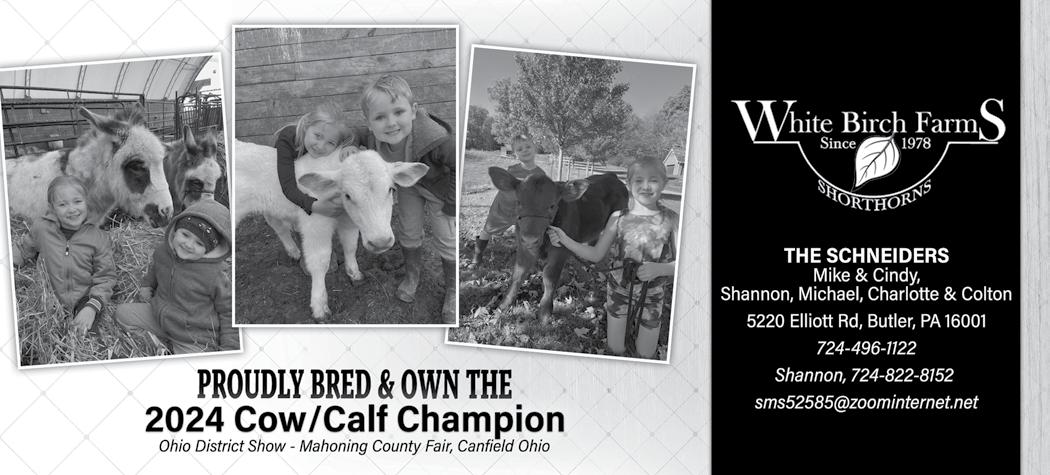
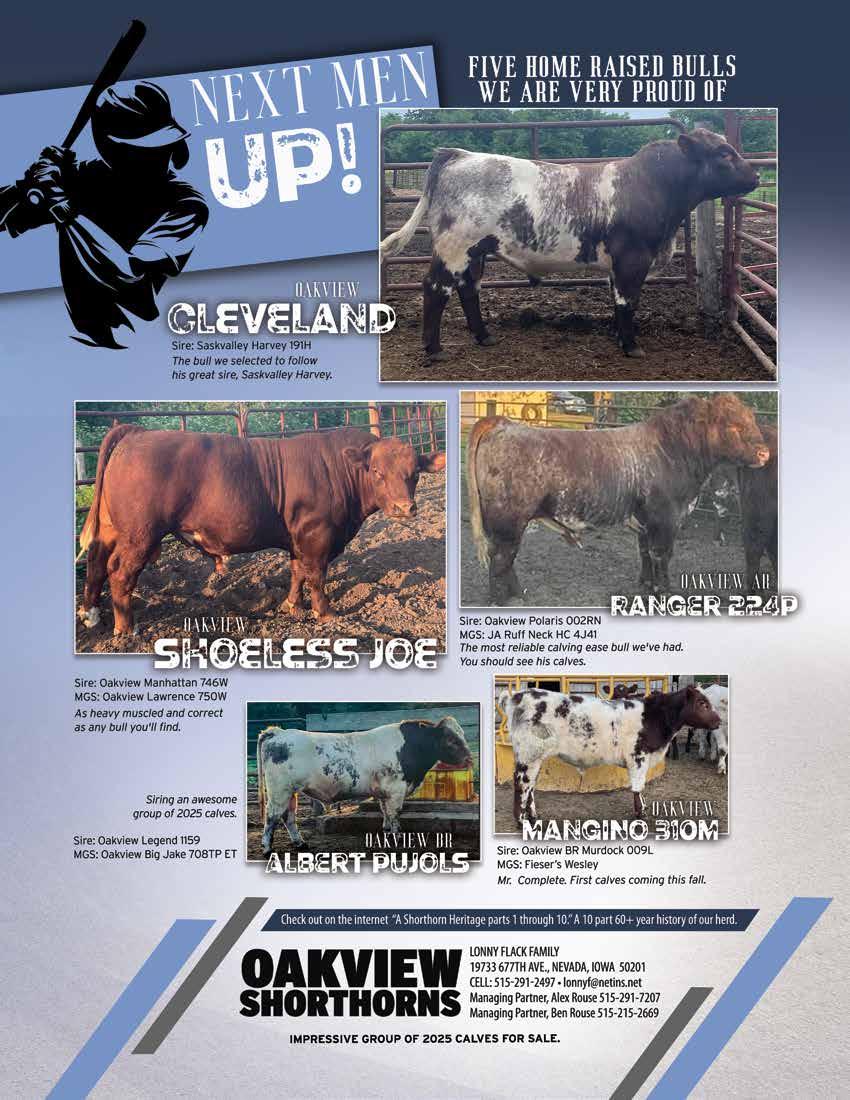




Just like that, half of 2025 has come and gone — and so has another Shorthorn Junior Nationals. While we were all busy “grooving” in Grand Island, our breed welcomed three new Red Coats to the Junior Board of Directors, first-time exhibitors officially joined the association, and the 2025 National Junior Shorthorn Show & Youth Conference helped participants reach new heights in both professional development and the livestock industry.
For me, this summer’s story is a little different. Showing at my final Junior Nationals and wrapping up my term as AJSA President happened in the blink of an eye — and I wouldn’t have wanted it any other way than with my favorite people by my side. Like every article I’ve written as a Board Director, I always come back to one thing: the people who make up this association.
Even though I won’t be standing in the ring as a showman anymore, I’m beyond thankful for the opportunity to now stand ringside — as a supporter, a friend,
and a mentor. The end of one chapter doesn’t mean you have to close the book entirely. I’ve reread a few books over the years (emphasis on few), and each time, I notice something new or interpret the story a little differently.
We all move through different chapters in life, being shaped by the many roles we take on. At some point, we’re all a leader and a follower, a giver and a receiver, a mentor and a mentee — and that’s okay. No matter what role you’re currently in, embrace it fully. That way, you’ll be prepared for the next one when it comes along.
Over the past three years, I’ve been incredibly grateful for the roles the AJSA has allowed me to step into. I’ve led, I’ve learned, and I’ve grown in ways I never imagined possible. The memories and the relationships I’ve built will last a lifetime — and I hope that, in some small way, I’ve made a lasting impact on someone else too.
From the bottom of my heart, thank you, AJSA.


Director
“The
is the one who makes the most players valuable.” -Peyton Manning





Making a donation guarantees a Return on Your Investment as you are encouraging the future of the breed to continue their involvement in the Shorthorn breed.

“It is important to support these kids because it is such a team building and leadership building event for these young people. To see the results of the dollars we invest as sponsors of this event is incredible it develops great people for our ag industry, cattle industry and beyond.”
-Jeff Aegerter, AMS Online Sales
“We throw around the catchphrase ‘the future of our breed’ and we say it so much we don’t realize how deeply we have to support it with our time, effort, interest and belief in young people. The things we do at NJSS are all-encompassing. They do everything all week to develop cattle and themselves.”
-Julie
French, Little Cedar Cattle Co. scan here to donate now!







The National Shorthorn Lassie Association invites you to join the Legacy 56. Your donation provides young ladies from all backgrounds with scholarship support and the opportunity to represent the Shorthorn breed across the United States. Please consider making a onetime donation of $56 (or more) or an annual donation of $56 in honor of all the Lassies since 1956 that have worked to promote the Shorthorn breed.
Please use the QR code and pay online or Mail payment to: Pam Dressen N4787 515th St. Ellsworth, WI 54011
Thank you for your support.

As part of the Chicago International Livestock Show, the National Shorthorn Lassies were officially organized in 1956.
The National Shorthorn Lassie Queens represent the Shorthorn breed across the United States. Each year, the Shorthorn Foundation and the National Shorthorn Lassie Association provide funds during the queens’ reign to keep them financially supported so they can represent our breed throughout the country. This requires more than $15,000 annually.
In addition to promoting our breed and serving as spokespersons, the National Shorthorn Lassie Queens also devote their time providing educational opportunities such as Lassie 101 and Lassie Princess Hour to future generations of our breed.
We are asking you to donate $56 (or more) in honor of all the Lassies since 1956 that have worked to promote the Shorthorn breed. Your gift provides young ladies from all backgrounds with scholarship support and the opportunity to represent the Shorthorn breed across the United States.


How You Will be Paying: Cash Check Online with Square Circle The Payment Option: One-Time Annually Mail Payment to: Pam Dressen, N4787 515th Street, Ellsworth, WI, 54011




Hometown: Attica, KS
Future Plans: I plan to return to Kansas State University this fall to complete my degree in Animal Science with a concentration in Production Management. After graduation, I hope to combine this degree with my minor in Agricultural Sales to advocate for the beef industry, support producers, and help educate the next generation of agriculturists.
One thing you hope to learn during the internship: Having grown up raising and showing livestock, I developed a deep appreciation for the livestock industry and the people who support it. I’m eager to learn how a breed association operates behind the scenes and to contribute to its mission, all while strengthening my communication and teamwork skills in a professional setting.
Favorite activity/pastime:
My favorite pastimes include spending quality time with family and friends, going on road trips, and listening to music—I never do anything without music playing in the background.
Hometown: Taylor, Texas
Future Plans: I’m currently a student at the University of Nebraska–Lincoln, planning to graduate in May 2026 with a degree in Agricultural Leadership, Education, and Communications. After that, I’m hoping to pursue a Master’s degree in Public Service and Administration. My long-term goal is to work in leadership or communications for an organization that supports the beef industry or youth livestock exhibitors.
One thing you hope to learn during the internship:I’m excited to gain new perspectives and build meaningful connections with others in the industry.
Favorite activity/pastime: I’m on the livestock judging team at Nebraska, and in my free time, I love taking pictures of animals and the people who love them.
Hometown: Lecompton, Kansas
Future Plans: I’m currently a graduate student at Kansas State University. I received my undergraduate degree in Agricultural Communications and Journalism in December of 2024 and am now pursuing a Masters in Business Administration with an emphasis in Marketing. After earning my Masters degree I plan to continue working in the livestock industry, preferably in the marketing sector.
One thing you hope to learn during the internship: First and foremost, I am thankful for the opportunity to serve the Shorthorn breed for a second year. This summer I hope to continue building new connections and improving key skills such as graphic design and photography.
Favorite activity/pastime: A pastime I have recently taken up is paddle boarding. The activity is a good way to exercise, relax and cool off after hot summer days.




The American Shorthorn Association (ASA) recently launched an initiative to promote members who are offering beef products directly to consumers.
It is called Shorthorn Beef — Locally Raised.
The Shorthorn Beef program is an avenue for connecting the breed’s cattle producers with those interested in buying locally raised beef. The effort includes promotional opportunities through social media, the ASA website and other media platforms. View a list of producers below.
Contact the ASA office, 816.599.7777 (shelby@shorthorn.org) to be added to the list or visit shorthorn.org for more information.
List of Shorthorn Beef Producers
1. Knutson Shorthorns :: Pine Island, Minnesota :: knutsonshorthorns@gmail.com :: 507.259.9804 :: knutsonshorthorns.com
2. Kirsch Family Farms :: Fremont, Ohio :: kkirsch5@hotmail.com :: 419.707.9839 :: https://facebook.com/KirschFamilyFarms/
3. Wilfred Tate :: Chickasha, Oklahoma :: 405.320.1621
4. Holland Family :: Tecumseh, Oklahoma :: 405.488.4783 :: ironrock@gmail.com
5. Muddy Water Farm :: Madisonville, Tennessee :: lisalay99@yahoo.com :: 423.295.4483
6. DTR Cattle Company :: Raymond, Kansas :: ngrathwohl@me.com :: 785.587.7947 :: www.dtrcattlecompany.com
7. Cannondale Farms :: Red Wing, Minnesota :: tombryan6380@gmail.com :: 651.301.9555
8. Dreamy 280 Farm Fresh Meats, LLC :: Blue Mounds, Wisconsin :: dreamy280@gmail.com :: 608.437.8074 www.Dreamy280.com
9. Dale B. Spurlen :: Dublin, Texas :: spurlen@cctc.net :: 254.734.5429
10. Maples Shorthorns :: Copperas Cove, Texas :: maplessh@earthlink.net :: 254.289.3429
11. Barrett Family :: Randolph, Minnesota :: bsf_shorthorns@hotmail.com :: 507.302.9444 :: barrettstockfarm.blogspot.com
12. Paint Valley Farms :: Millersburg, Ohio :: paintvalley81@yahoo.com :: 330.231.6834 :: paintvalleyfarms.com
13. Brambleridge Farm :: Frankewing, Tennessee :: brambleridgefowl@gmail.com :: 931.732.5142
14. Bright Lights Show Cattle :: Beloit, Wisconsin :: mackenzie@brightlightsshowcattle.com :: 608.728.3238 :: brightlightsshowcattle.com
15. Blazin A Shorthorns/Amos Hereford Farm, Craig & Denise Amos :: Indianola, Iowa :: cdamos@msn.com :: Craig cell515.238.9852, Denise Cell -515.238.1610 :: www.amosherefordfarm.com
16. Francis Shorthorns :: Lyndon, Illinois :: lightning2956@gmail.com :: 815.590.2053
17. Robin Bonn :: Eugene, Oregon :: robinwbonn@gmail.com
18. Ahlschwede Shorthorns, George Ahlschwede :: San Angelo, Texas :: 325.651.7533 :: ahlga@zipnet.us
19. Beckler Shorthorns :: Wooster, Ohio :: gbeckler@wpdlad.com :: 330.201.5975
20. Country K Shorthorns :: Stitzer, Wisconsin :: countrykshorthorns@yahoo.com :: 608.943.8850
21. Circle K Cattle Company :: Udell, Iowa :: mbkorthaus@gmail.com :: 641.895.4695
22. Leveldale :: Mason City, Illinois :: mathers@leveldale.com :: 309.678.4230
23. Meyer Family Shorthorns, Craig & Jamey Meyer :: Greensburg, Indiana :: craigandjameymeyer@gmail.com :: 812.374.2329
24. 4 Spear Ranch :: Casper, Wyoming :: snlcattleco@gmail.com :: 307.439.3069
25. GSKI Shorthorns :: Snyder, Colorado :: ej_baughman@hotmail.com :: 970.380.5458
26. Ropp Farms :: Albany, Oregon :: contact@roppfamilyfarm.com :: 541.223.2870 :: roppfamilyfarm.com
27. New Town Shorthorns, Dan Owen :: Taft, Tennessee :: 1danowne@gmail.com :: 931.607.9821
28. Davis Farms, Matt Davis :: Manhattan, Kansas :: rockyford24@hotmail.com :: 785.313.3993
29. Oakview Shorthorns, Lonny Flack Family :: Nevada, Iowa :: lonnyf@netins.net :: 641.377.2112
30. Bowman Superior Genetics, Phillip & Linda Bowman :: Greens Fork, Indiana :: bsg.phillip.bowman@gmail.com 765.886.5777 :: breedforprofit.com
31. Waukaru Farms :: Rensselaer, Indiana :: tojo@waukaru.net :: 219.819.4603 :: waukaru.net
32. M&M Shorthorns, Mike & Matt Sloan :: Jeromesville, Ohio :: sloan.7@hotmail.com :: Mike Sloan – 419.685.0960, Matt Sloan 419.685.4777
33. Hidden Paradise Ranch, Devin Hadorn-Papke :: Eau Claire, Wisconsin :: devinhp22@gmail.com :: 715.271.5018
34. Elbee Farms, Lee Bigham :: Frankfort, Kansas :: elbeefarms@diodecom.net :: 785.556.0375
35. Yokeley Farms :: Winston Salem, North Carolina :: yokeleyfarms@gmail.com :: 336.345.7333 :: yokeleyfarms.com
36. HAHN Family Shorthorns, LLC., Aaron Hahn :: Minonk, Illinois :: hahnfamilyshorthornsllc@gmail.com :: 309.645.4488 :: hahnshorthorns.com
37. Peak View Ranch LLC :: Fowler, Colorado :: peakviewranch@hotmail.com :: 719.263.4321
38. Shinglepile Creek Farm :: Luverne, Alabama :: ashleyocatrett@gmail.com :: 334.508.0464
39. Green Gate Farm :: Rochester, Washington :: christykmk@hotmail.com :: 360.273.3882
40. Prairie View Farms :: Holland, Michigan :: brentpvf@att.net :: 616.510.9005
41. M Bar Shorthorns, Troy and Sommer Smith :: Walton, Kansas :: 620.386.4696 :: janesommersmith@gmail.com :: mbarshorthorns.net
42. C Squared Shorthorns, Cole Strickland :: Nashville, North Carolina :: bigcstrickland22@gmail.com :: 252.908.2071
43. Sugar Grove Farms :: Hillsboro, Ohio :: sugargrovefarms@outlook.com :: 937.840.8482 :: https://sugargrovess.com
44. JVT Livestock :: Opelika, Alabama :: hdm0004@auburn.edu :: 334.734.6841
45. La Quilla Shorthorns, Duane Lehman :: Rice, Washington :: dlehman456@yahoo.com :: 509.738.6595
46. Esselburn Grain and Cattle Farm LLC, Tom Esselburn :: Shreve, Ohio :: ohioag81@yahoo.com :: 330.201.1345 esselburnbeef.com
47. JB Land & Livestock, Jason & Tasha Bunting :: Emington, IL :: Jrbunting76@gmail.com :: 815.252.5520
48. Jay Benham :: Troy, Ohio :: 937.335.1622
49. Bolinger Family Farm :: North Manchester, Indiana :: saletsinger@gmail.com :: 317.385.4911
50. Evolution Beef :: Millers Creek, North Carolina :: evolutionbeef@outlook.com :: 336.973.5207
51. Donnelly Shorthorns, Adam Donnelly :: Clear Lake, Wisconsin :: dfencecc@hotmail.com :: 651.470.4069
52. Allison Homeplace Farms :: Washington, Indiana :: bovine08@gmail.com :: 812.254.6185
53. JNK Farms :: Soldiers Grove, Wisconsin :: jesse.swenson4@gmail.com :: 608.632.0043 :: Find us on Facebook!
54. Northern Hills, Gary Weilbaker :: Fort Wayne, Indiana :: gary@careersolutionsco.com :: 260.414.5727
55. Glory Days Livestock :: Graford, Texas :: amber.emilee@yahoo.com :: 940.567.1026
56. Fahrmeier’s :: Lexington, Missouri :: Fahrmeiersupick@gmail.com :: 816.289.2496
57. Rocky Acres Shorthorns :: Shady Spring, West Virginia :: rockyacresshorthorns@gmail.com :: 304.546.1684 or 304.575.0850
58. STS Cattle Co. :: London, Ohio :: shonkwilerk@outlook.com :: 614.419.8022
59. Perlich Stock Farms :: Albion, Indiana :: perlichbeef@gmail.com :: Allen – 260.564.0662 :: David – 260.564.0663
60. MFK Shorthorns, Maurice & Faye Korthaus & Wes Korthaus :: Smithfield, Kentucky :: mfkshorthorns@gmail.com :: 502.649.6475
61. South Starr Farm, The McGill Family :: Iva, South Carolina :: 864.376.9407:: stevemcgill62@gmail.com
62. Sowers Farms :: Roseville, Ohio :: sowersfarmrs@gmail.com :: 740.621.6360
63. Pirsue Show/Sale Cattle, Charlie Hartsfield :: Lynnville, Tennessee :: 931.629.2265 :: charliepsc@gmail.com
64. Ryan Kegley :: Kearney, Nebraska :: 308.440.8417 :: kegleyryan@yahoo.com
65. Spring View Cattle :: Neillsville, Wisconsin :: Karen 612.770.1831 or Lee 608.400.5657
66. Derek Launius :: Broughton, Illinois :: 618.924.0343 :: dereklaunius@hotmail.com :: can ship to you!!
67. J Armstrong Cattle :: Alpena, Arkansas :: 281.851.1151 :: jarmstrongcattle@gmail.com
68. Oak Hollow Farm :: Platteville, Wisconsin :: 608.348.8046 :: oakhollowfarm@outlook.com
69. DJ & Amanda Huff :: Wabash, Indiana :: 812.592.4929 :: dylanjhuff@gmail.com
70. Shady Maple Farm :: Panama, New York :: 716.782.4643 or 716.665.9423 :: 5osborne@windstream.net
71. JP Bar Ranch, Juston & Gena Plummer :: Herald, California :: 916.834.1898 :: luvhim6@icloud.com :: jpbarranch.com
72. Crestmead Farm :: Pilot Grove, Missouri :: Bill 660.888.9790 or Mary 660.888.3937 :: wbetter@iland.net
73. VW Cattle :: :: Volga, SD :: Dallis 605.690.9069 :: vwcattle1978@gmail.com :: vwcattle.com
74. Juniper Crossing Farms :: Quincy, Florida :: 850.510.9393 :: junipercrossingfarms@yahoo.com :: junipercrossingfarms.com
75. DJ Huff :: Wabash, Indiana :: 812.592.4929 :: dylanjhuff@gmail.com
76. Turner Shorthorns, Tom & Susie Turner :: Somerset, Ohio :: 614.499.5248 :: tom@turnershorthorns.com :: www.turnershorthorns.com continued on next page
77. Double Nickel Cattle Company :: Trovoli, IL :: Brimfield IL :: 309.224.1321 :: doublenickelcattle@gmail.com :: doublenickelcattle.com
78. Lane Cattle :: Will Lane :: Grove, Oklahoma :: 918.253.7344 :: will@grandinsuranceagency.com
79. Harzman Farms :: Brent Harzman :: Downs, Kansas :: 785.454.1102 :: bharzman@gmail.com :: sell by the ¼ ½ or full beef
80. Aegerter Cattle Company :: Jeff Aegerter & Jon Schernikau :: Seward, Nebraska :: 402.450.0292 :: jon.schernikau@gmail.com
81. Schooner Valley Shorthorns :: Nashville, IN :: 812.340.4153:: hoozreiner@gmail.com
82. Legacy Ranch :: Rhineland, Missouri :: 314.609.1887 :: connie@cruzcompany.com
83. John Lathrop :: Sherburne, New York :: 607.226.0930 :: jlathropgrazing@yahoo.com
84. Schabbing Shorthorn Farms :: Cape Girardeau, Missouri :: 573.335.1938 :: schabsh@gmail.com
85. Tadmore Farms :: Caldwell, Texas :: 281.684.4809 :: tadmorefarms@gmail.com
86. JLCF Livestock, Jason, Lisa, Caytie, & Fayth Couch :: Miami, OK :: 918.752.4237 :: jlcflivestock@gmail.com :: https://www.facebook.com/profile.php?id=100071046504686&mibextid=ZbWKwL
87. Canyon Rim Farms, David and Elizabeth Magar :: Goodnight, Texas :: 806.437.3754 :: dmagar.canyonrimfarm@gmail.com :: Quarters, halves, and individual cuts
88. JEM Farms, Joel & Esther McBride :: Oakville, Washington :: 360.470.9250 :: jemshowcattle@gmail.com
89. Stone Barn Shorthorns, Ethan Murry :: Conestoga, Pennsylvania :: 717.405.2521 :: jemurry91@gmail.com
90. Jerome Cech :: Clarkson, Nebraska :: jepcech@gmail.com
91. Reese Lock :: Fleming, Colorado :: 970.466.1427:: jenae.lock@gmail.com
92. BS4 Cattle :: Hawkeye, Iowa :: 563.422.7815 :: ben.steph7@gmail.com
93. Prairie View Shorthorn Farm :: Seneca, Kansas :: 785.541.1012 :: redcowfamily@gmail.com
94. Burntwood Livestock :: McKinnon, Wyoming :: 307.871.9320 :: firechild@burntwoodlivestock.com :: Facebook – Burntwood Livestock
95. 3-C Ranch, Malissa and Rick Cavazos :: Kennard, Texas :: 469.212.6035 :: 3cranchtexas@gmail.com :: Facebook
96. Merrill Farms :: Wakeman, Ohio :: 440.935.2827, 419.706.4196 :: elizabethrowland2827@gmail.com
97. Hollow Tree Branch :: Virginia Beach, Virginia :: 757.721.7456 :: mcullipher@icloud.com :: https://www.cullipherfarm.com/
98. Dover Ranch Shorthorns :: Billings, Montana :: 406.259.8706 :: doverranchshorthorns@gmail.com :: Facebook – Dover Ranch
99. Bum Steer Cattle Co - Lewie Pugh :: Holden, Missouri :: 330.795.0482 :: bumsteertrking@aol.com :: https://www.facebook.com/ profile.php?id=100000100050345
100. Nile Valley Shorthorns - Hendrickson Trust :: Sedalia, Missouri :: 618.367.4190 :: roanbullman2@gmail.com :: http:// nilevalleyfarm.mysite.com :: https://www.facebook.com/nilevalley.shorthorns.9/



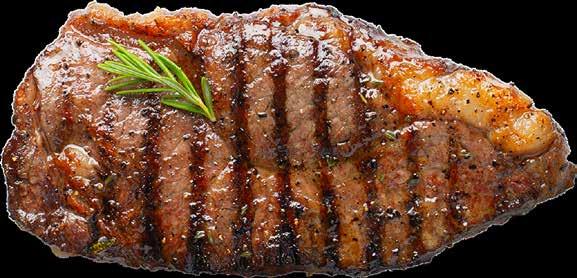
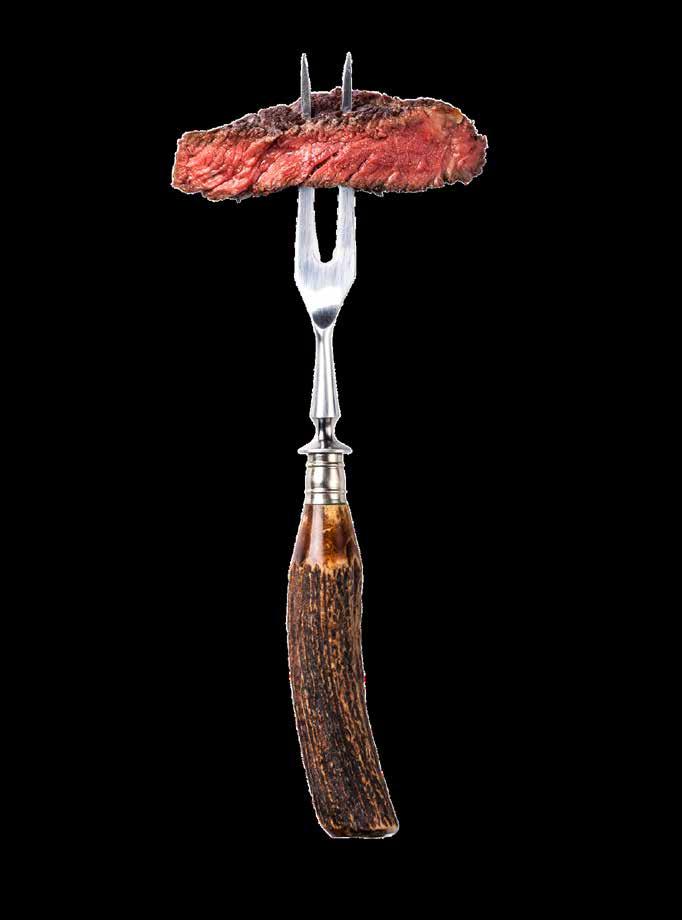



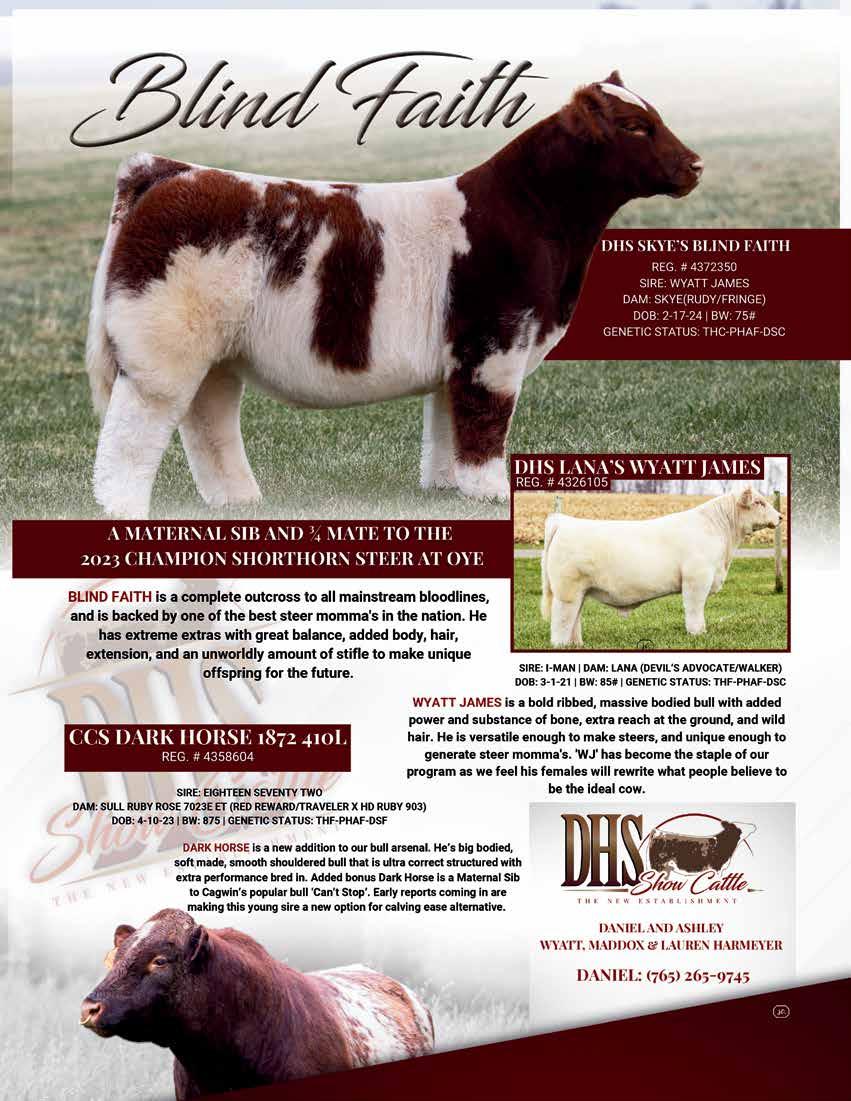
1945: Thomas E. Wilson; James Tomson; L.E. Mathers, Sr.; Wharton Allen; Wallace Campbell; Albert Hultine; and Paul Teegardin.
1946: Russell Kelce; Fred Hubbell; T.D. Jones; Charles Broughton; Will Dryden; L.W. Thieman; and Charles Lynn.
1947: Josef Winkler; Homer Clausen; R.D. Arnold; C.M. Caraway; W.J. Russell; H.L Straus; and Bert A. Hanson.
1948: William Bartholomay, Jr.; Frank W. Harding; E.M. Sims; Dale Bellows; George E. Day; George E. Smith; and Fred A. Johnson.
1949: Byron Hawks; Luther K. Rice; Fred Lee; Otis A. Carter; Fred Blomstrom; and Harold Thieman.
1950: D.M. Gregg; James Napier; George Struve; Kenneth E. Deacon; J.W. Bennett; and Charles H. Nickel.
1951: S.A. Donahoe; W.A. Cochel; George N. Fisher; Stewart G. Bennett; Russell Blomstrom; and Cleo Hultine.
1952: Frank Scofield; C.K. Tomson; Carl Greif; J.W. Durno; Harry McCann; and Carl M. Johnson.
1953: H.H. Allen; W.N. Anderson; Dewey Carnahan; Harold White; J.R. Kenner; and John Bertz.
1954: John C. Blume; Reford Gardhouse; B. Hollis Hanson; Carl W. Retzlaff; Grant Campbell; Gerald Clodfelter; and E.P. Laughlin.
1955: Allan C. Atlason; Cyrus S. Eaton; Autrey Caraway; W.L. Lyons Brown; Miss Emma Allison; W.W. Rapley; and Walter H. Larson.
1956: Louis Cadesky; Stanley G. Harris; Robert A. Collier; A.R. (Sandy) Cross; Otto Thiede; James L. Adams; and Fred W. Smalstig.
1957: Alex Cross; S.J. O’Bryan; John F. Shuman; Dr. O.W. House; Phil J. Sauer; W. Henry Dilatush; F.T. Brown; and P.S. Troubadour.
1958: W.W. Donaldson; John Alexander, Sr.; Thomas B. Hawkins: Don James; Harry Ackerman; B.W. Cooper; and Miles Wertz.
1959: R.E. Smith; David S. Graham; Gilbert Elken, Jr.; W.C. Jones; Wayne A. Carr; F.E. Jackson; and Byron D. Reser.
1960: Robert G. Heine; James G.
Tomson; Raymond P. Duer; Miss Betty Royon; Harvey B. Wilson; Ray Clodfelter; and Roland G. Magill.
1961: W.H. Boutell; George T. Richardson; L.E. Mathers, Jr.; Sumption Brothers; W.A. Warters; Daniel J. O’Conner, Jr.; and Jacob Walter, Jr.
1962: C.D. Swaffar; Otto H. Grosse; Levi Johnson; Cecil Steinmetz; Clarence Worden; George Garvin Brown; and W.P. Hix.
1963: Louis Wernicke; Henry Dietz; Charles Ewald; Russell Held; Louis Latimer; George R. Gallatin; and Fred E. Smalstig.
1964: Mervin F. Aegerter; R.B. Stimson; Dr. Arthur H. Weiland; True Buckmaster; George DePape; Jack Ragsdale; and Otto Johnson.
1965: Ted L. Aegerter; Max L. Cardey; Paul Potter; E.H. Stoltz; Mrs. Hugh Fenwick; Harry McCabe; and Charles Hix.
1966: Dwight McCoy; Herman R. Purdy; Carroll Latimer; Cary A. Colburn; Lyle Brooks; Dave Brockmueller; and Lou Laughlin.
1967: William H. Roda; J.E. Halsey; Albert J. Hamann; Clyde G. Harlow; J.E. Klokkenga; Harry T. Peters, Jr.; and Chris R. Bertz, Jr.
1968: A.C. Buehler; Roger Applegate; Orlyn Oswald; Mr. and Mrs. Dave Lorenz; Norman D. Hogg; Roy R. Rutledge; and Ed Rocker.
1969: Burke N. Allison; Jos. Biglands; Ben G. Studer; Ed Hoyt; Howard Snethen; Charles B. Leemon; and Bill Hoewischer.
1970: Truman Kingsley; Bob Gordon; Mrs. W.C. Pitfield; Dewey Lunstra; Mrs. Glenn Miller; Joe Huckfeldt; and Jim and John Humphreys.
1971: James A. Brennen; Mrs. George Garvin Brown; Dick Braman; John Draper; Mr. and Mrs. Edward J. Long; Martin Nold; and Milton Nagley.
1972: Lyle V. DeWitt; R. Lee Johnson; Rudolph Kaehler; Mr. and Mrs. Arch Allen; George Inness; William Cruickshank; and Wendell Lovely.
1973: Dr. L. Eugene Byers; Jerry Taylor; Richard Prentice; Mr. and Mrs. Fred
Coats; Mrs. Frank J. Haumont; Larry A. Hart; and Lloyd Hatch.
1974: Mrs. T.C. Stuart; Mr. and Mrs. Vic Taylor; Dover Sindelar; Wertz Bros.; Robert Hahn; Harvey Fulton; and Bert Kessi.
1975: Mark L. Graham, Sr.; A.D. Tilley, Jr.; Buck Bardwell; W.J. Boake; Barry Jordan; Lloyd Waters; and Ernest Esau.
1976: Earl Fieser; R.W. Parrott; Edgar Philpott; Bill Scott; Don and Pat Stout; Louis M. Womack; and Joe Woods.
1977: Robert Miller; Robert Raisbeck; Val and Bev Kjernisted; Gary Englehorn; Charles DeBusk; Donald Kaehler; and W.O. “Bill” Jennings.
1978: Horace Curtis & Sons; Herbert and Harry Krug; Joseph T. Christen; George and Janice Alden; Lester Love; William and Wayne Hartman; and Russell M. Sloan.
1979: Thomas Elias McGee; David W. Clark, Jr.; F.A. Heckendorf, Jr.; Duane Rocker; Sandra and Bert Pepper; Virgil Wegener and Steve Washburn; and Otis W. Rothlisberger.
1980: Donald W. Schlegel; Harvey W. Schulhauser; Carvin H. Guy; Gilbert Lee Miller; Ronald B. Hofstrand; Richard D. Yarnell; and Rex, Brian, and Randy Cates.
1981: Ric and Judy Hoyt; M.R. and Lil Boake; W.N. and Harriett H. Moore; Scott Dau; Steve and Tom Torgerson; Orville A. Stangl; and Max Tribbett Family.
1982: Robert Dahl; Stanley Melroe; Roger Steiger; Orville and Kendrick Berg; Paul Schrag; Mike Dugdale; and Darrel, Dave, and Dean Steck.
1983: N. Gerald and Grant C. Alexander; Ralph and Don Pope; James A. McAnear, Jr.; Sherman Berg; Edgar and John Wise; Don Cardey; and Archie and Gary Hansen.
1984: Wayne Clark; Stanley H. Harper; Odis A. Lowe, Jr.; William McCullough; Dr. and Mrs. George M. Smith; Dick and Wilma Russell; and Damar Farms, Inc.
1985: Kadel Urice; Howell F. Eyler; Duane Sicht; Roy D. Dedmon; Darrell and Denny Jordan; Art and Luke
Bakenhus; and L. Jack Bedwell.
1986: Eddie and Judy Grathwohl; Gladys Dau; Bradley Eisiminger; Gary and Pam Naylor; Jim Scott; Calvin and Steve Hiatt; and Dale Louis Wernicke.
1987: Dale Rocker; Keith H. Lauer; Gary and Chuck Buchholz; G.M. “Mike” and Linda Kahoa; Hugh, Jr., Tom, and Ron Moore; Steve and Linda Haywood; and William Earl Wilson.
1988: Hale Charlton and Jim McCollum; Alfred and Darrell Ippensen; Doug Schrag; Bill Smithers; Herbert Symington; and Paul Wharton & Sons.
1989: Gordon Brockmueller; Don Hoyt; Dr. W.L. Munson; and Charles Meisner & Sons.
1990: Robert and Ronald Alden; Phil and Chuck Johnson; Robert and Dorothy Connell; and Duane and Evelyn Greeley.
1991: Neil and Mary Davis; Bruce and Sandra Wallace; Arden Preheim; and Joseph O. and Joseph F. “Sam” Erhnthaller.
1992: Wayne C. Neely; George W. Slater; Bernie and Norma Bolton; and Mary and J.O. Bass III.
1993: Jesse Duckett and Larry Kohlstaedt.
1994: Don Cagwin and Frank and Mary Kaehler.
1995: William H. Hoskins and James A. Cato.
1996: Gene McDonald and North Dakota State University.
1997: Bill Rasor and Lyle Ewald.
C.F. Martin.
1999: Dr. George Ahlschwede and Rick and Sandy Osterday, Stangl Shorthorns.
2000: Dale Studer Family Shorthorns and Steve Melroe & Family, Melroe Shorthorns.
2001: Merl Welch, Green Ridge Shorthorns and A. Lorne Edmondson, Bromelee Shorthorns.
2002: The Bertz Family, Meadow Lane Farms and Ronald Gooch, Greenbelt Shorthorns.
2003: Harold and Kay Good, Good Family Shorthorns, and Donald McMillan & Sons, McMillan Shorthorn Ranch.
2004: Dave McFarland Family, Diamond M Shorthorns and Richard C. McElhaney, McElhaney Stock Farm.
2005: Jim and Beverly Freed, Double J Ranch/Jeepetta Cattle Co. and Dick Hahn, Hahn Family Shorthorns.
2006: The Jim Williams Family, V8 Shorthorns and Verl Shell, Milestone Cattle Co.
2007: Nick Steinke Family, Steinke Shorthorns and L.E. ‘Les’ Mathers III, MD, Leveldale Farms.
2008: Randy & Nancy Griffis, Carolina Cattle Company and George & Gail McLachlan, Lakeside Farms.
2009: Ralph S. Larson, Y Lazy Y Shorthorns and John R. Hagie, Cyclone Trace Cattle Co.
2010: Steve & Laura McGill, South Starr Farm, Robert ‘Bob’ & Joyce Wilson, Dr. Larry Wilson, Robjoy Shorthorns
Leemon Stock Farm and Dr. Raymond Ediger, Green Spring Farm.
2012: Derek Jungels, Jungels Shorthorn Farm and Edward Meyer, Meyer Farms.
2013: Marty Loving, Loving Farms, Steve & Julie French, Little Cedar Cattle Company and Don Washburn, Iroquoian Shorthorns.
2014: Charles and Judy Obrect, O-Dale Farms and Virginia Davis, KV Cattle.
2015: Kevin & Kari Vander Wal, Vander Wal Shorthorns; Sammy Richardson, Richardson Farms, and L. Martin Haliton Jr., Wind Crest Farm.
2016: Penny, Caleb, Seth & Courtney Vance, Bill & Jane Hale, Hale Farms; and Scott Horton & Family, Horton Farms.
2017: Laurence Pathy, Shadybrook Farms and John Sullivan, Sullivan Farms.
2018: Dave Greenhorn, Greenhorn Cattle Company, and Jon Byers & Jeff Byers, Byland Polled Shorthorns.
2019: Mark W.P. Gordon, and Phillip & Linda Bowman, Bowman Superior Genetics.
2020: RC Show Cattle, Dr. Roger Hunsley, Ben & Sharon Wilson.
2021: Dr. Bert Moore, Dr. Tom Turner. 2022: Greg Crawford, Cory Bollum, and Jeff Bedwell.
2023: Ward Bakenhus, Bill & Joe Bales, Rick Leone & Family.
2024: Mike Bennett & David Ragsdale. In Memoriam: Hal Longley; Don Longley; and Horace Walker. Honorary: Charlotte MacLeod.
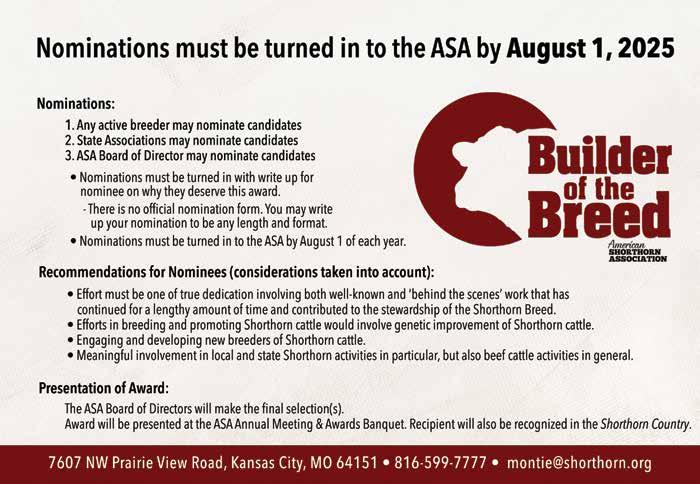

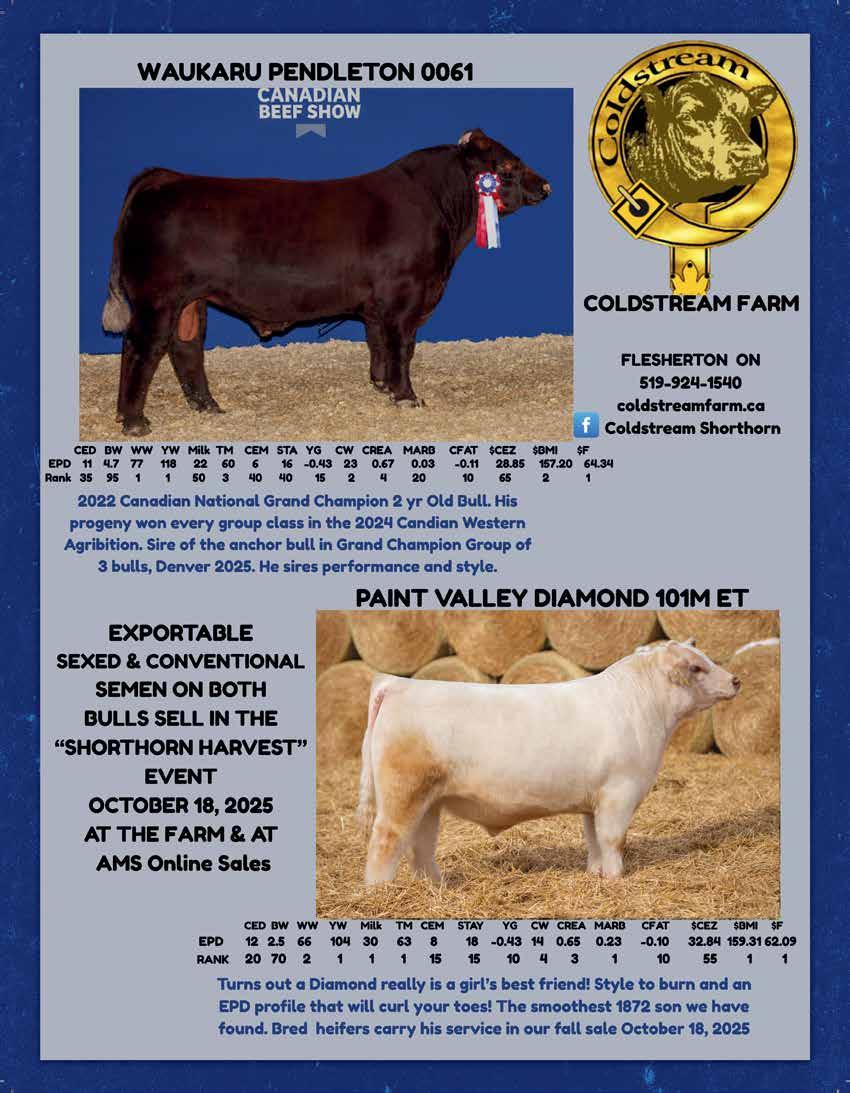
2023-24: Show Bull of the Year, BFS LCCC AFLC Direct Deposit 2254 ET; Show Female of the Year, CF Crystal Lucy 230 RK X ET; ShorthornPlus Bull of the Year, TESCC Almighty Zeus 755J ET; ShorthornPlus Female of the Year, S/T CULL Dream of Me 3011 ET.
2022-23: Show Bull of the Year, Little Cedar Currency 2146; Show Female of the Year, CF CSF Dream Lady 140 HC X ET; ShorthornPlus Bull of the Year, TSSC BT Limit Up 1099J ET; ShorthornPlus Female of the Year, SULL Fancy Cherri 1221J ET.
2021-22: Show Bull of the Year, CF Maskerade 070 BW X; Show Female of the Year, SULL Special Chelsie 0453H ET; ShorthornPlus Bull of the Year, SMCK Jameson; ShorthornPlus Female of the Year, CF Mona Lisa Primo 115 X ET.
2020-21: Show Bull of the Year, CF S/F Upper Hand X ET; Show Female of the Year, Steck WSCC Chelsie HC 911G; ShorthornPlus Bull of the Year, SS Southern Comfort 908; ShorthornPlus Female of the Year, CF CSF Mona Lisa 934 Primo ET.
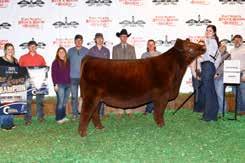

2019-20: Show Bull of the Year, CF S/F Upper Hand X ET; Show Female of the Year, CF CSF Margie 830 AV X ET; ShorthornPlus Bull of the Year, LDB Premium Reward Apache 911; ShorthornPlus Female of the Year, SULL Crystal Blue 8076F ET.
2018-19: Show Bull of the Year, TJH Bo’s Maxim H7; Show Female of the Year, Steck Chelsie C 704 ET; ShorthornPlus Bull of the Year, CCF Nicholas C59E; ShorthornPlus Female of the Year, SULL Black Cherri 7217E ET.
2017-18: Show Bull of the Year, SULL RGLC Legacy 525 ET; Show Female of the Year, CF CSF Demi 650 SOL ET; ShorthornPlus Show Bull of the Year, 5J Gustus 24E; ShorthornPlus Show Female of the Year, KOLT Blue the Roo 940.
2016-17: Show Bull of the Year, SULL RGLC Legacy 525 ET; Show Female of the Year, SULL Dream On 5158 ET x; ShorthornPlus Show Bull of the Year, DTR Buzz 612D; ShorthornPlus Show Female of the Year, KOLT Blue the Roo 940.
2015-16: Show Bull of the Year, JM Vortecs Rider ET; Show Female of the
2024-25: Show Female of the Year, LDB Mercis Magnolia 3111 ET, owned by Lane Blankinship.
2024-25: ShorthornPlus Show Female of the Year, MFS Lucy’s Masha 87L ET, owned by Carter Kornegay.
2024-25: Show Bull of the Year, CF Logic X, owned by Leemon Cattle Company.
Year, SULL Dream On 5158 ET.
2014: Show Bull of the Year, CF V8 Fascination X; Show Female of the Year, KOLT Gentry 363 ET.
2013: Show Bull of the Year: SULL Master Rose; Show Female of the Year, GCC Lucky Sunshine 153 ET.
2012: Show Bull of the Year, CF BCL HBO X ET; Show Female of the Year, GCC Achiever Charm 71 ET.
2011: Show Bull of the Year, CF Flex; Show Female of the Year, SULL Salute Destiny 9001.
2009: Show Bull of the Year, SB PFC Proud Venture WH ET; Show Female of the Year, Miss V8 Mona’s Hip Hop ET.
2008: Show Bull of the Year, Mr. V8 D’Brickashaw 11552; Show Female of the Year, Miss V8 Mollie Jo 93S2.
2007: Show Bull of the Year, AF KF VG Step Ahead 525, Show Female of the Year, Miss V8 Dionne D 50R7.
2006: Show Bull of the Year, HD Big and Rich 204; Show Female of the Year, SULL Sara’s Sable.
2005: Show Bull of the Year, COR Fear Factor 11702, Show Female of the Year, Miss V8 Can’t Fool Me.

2024-25: ShorthornPlus Show Bull of the Year, LPW Bo Duke, owned by Alexis Wright.


California
Amanda McKeith President amanda@sunnydayshorthorns.com 209-358-9377 californiashorthorns.com Matt Bigelow Vice President mjbigelow1@hotmail.com 559-647-2817
Colorado Rick Leone President peakviewranch@hotmail.com 719-468-1980
Four State Carl Burton President ccshorthorn@embarqmail.com 620-856-5750
Florida - see South Carolina
Georgia
Johnny Spencer Vice President 417-285-6130
Charles Osborn State Rep/ Director osborn22@bellsouth.net 706-540-5992
Illinois Luke Turner President mainstreetfencing@yahoo.com 217-202-2484
Alyssa Penrod Vice President 618-697-7324
Indiana Matt Fry President matthew.fry@cargill.com 765-720-8138 indianashorthorn.com
Iowa
Jalane Vaughn President aldenjalane@gmail.com 816-465-0341
Emily Fox Vice President foxshorthorns@hotmail.com 574-320-7013
Kansas Ross Mosteller President redcowfamily@gmail.com 785-541-1012 kansasshorthorns.com
Kristin Mizner Vice President kloving13@hotmail.com 620-786-4907
Kentucky David McCall President mccallfran@gmail.com 502-494-9644
Jason Martin Vice President jasmar@scrtc.com 270-774-2283
Louisiana Ricky Guidry President ricky@rlcattlecompany.com 337-540-2825
Maryland
David Bowman President bowmanfamilyshorthorns@verizon.net 240-549-9507 marylandshorthorns.com Sean Hough Vice President smhough13@gmail.com 443-745-5146
Michigan Tara Miller President narrowbrookfarms@gmail.com 517-749-8187 michiganshorthorns.com
Carla McLachlan Vice President mclachlancarla@gmail.com 517-242-2395
Minnesota Eric Schoenbauer President scattle@gmail.com 952-237-3836 mnshorthorn.com
Cody Nelson Vice President soilrx1@gmail.com 507-720-2998
Missouri Jose’ Cruz President legacyranch@cruzcompany.com 314-803-1104 missourishorthorn.com
Missouri - Ozark
Nebraska
North Carolina
North Dakota
Ohio
Kyle Dameron Vice President kyledameron1978@icloud.com 573-656-3205
Janet Fritter President mammafritt@sofnet.com 417-742-0508
Katie Stewart Vice President kstewart@crinet.com 417-839-3184
Jennifer Ruby President jjfarms25@gmail.com 580-461-2648
Christy Brus Vice President brus.shorthorns@gmail.com 308-750-1860
Bruce Humble State Rep/ Director humblestockfarm@yahoo.com 336-264-1496
Roberta Francis President 701-799-4568
Ryan Galbreath Vice President showpigs@mlgc.com 701-799-4568
Jeff Winkle President cattlejock9@yahoo.com 937-694-1871 ohioshorthorns.org
Jason Workman Vice President caseih460@yahoo.com 419-651-2442
Oklahoma Steve Soules President ssoules@skiatookschools.org 918-857-1504
Mandee Blankenship Vice President mandee.donelan@yahoo.com 405-513-3687
Pennsylvania Don Cowden President 724-255-5083
South Carolina
Steve McGill President steve.mcgill@merial.com 864-376-9407
Eastern Shorthorn Association, Kris Dedmon Vice President kcdedmon@gmail.com 794-472-6371 FL, GA, NC, SC
South Dakota
Rick Osvog President kbegalka@itctel.com 605-237-1116
Riley Buck Vice President buck_riley@yahoo.com 605-881-4260
Tennessee Luke Teeple President teeple@hotmail.com 931-761-3043
Charles Curtis Vice President doublecshorthorns@gmail.com 931-498-2847
Texas Tony Brooks President tonybrooks551@gmail.com 972-825-7109 txshorthorns.org
Greg Priddy Vice President gregpriddy89@gmail.com 325-721-3605
Western States Shorthorn Breeders Assoc. Sherry Walter President 989-388-3591
Wally Klose President
Cammy Tetlow President
Wisconsin Cole Chapman President colechapman50.cc@gmail.com 608-617-8064 wisconsinshorthorns.com Jason Chapman Vice President jchappy8072@gmail.com 608-235-8072

Alabama Ashley Catrett
ashleyocatrett@gmail.com 334-527-3533
Cassidy Catrett cassidycatrett@gmail.com 334-403-0947
Arizona Mikayla Askey azshorthorns@gmail.com 480-338-8597
California Krista Vannest fourvannest@yahoo.com 209-521-0723
Colorado Richard Leone
peakviewranch@hotmail.com 719-263-4321
Illinois Karl Miller kmill926@gmail.com 309-502-2673
Indiana
Mitchell & Courtney Smith mnsmith2036@gmail.com; mrs.courtsmith18@gmail.com 765-606-6224
Iowa Lisa Green mom2cma@gmail.com 641-691-0266
Cynthia Moffitt kcmoffitt@yahoo.com
Kansas Nancy Grathwohl Heter ngrathwohl@me.com 785-587-7947
Kentucky
Maryland
David McCall mccallfran@gmail.com
502-494-9644
Fran McCall mccallfran@gmail.com 502-836-9523
Heidi Bowman bowmanfamilyshorthorns@verizon.net
301-651-0852
Annete Braun mdorgdbraun@aol.com 240-687-2686
Casey Holland 301-407-8460
Michigan Stacy Stinson stacystinson14@gmail.com 517-231-6320
Minnesota Cody & Melanie Nelson mnelson710@gmail.com 402-525-6155, 507-720-2998
Missouri Clint and Lisa Youse lisayouse84@gmail.com, yousesteers@yahoo.com 660-651-4779, 660-651-4384
Bret and Lorin Fahrmeier fahrmeierl@gmail.com, fahrmeiersupick@gmail.com 819-289-2496
Montana Debbie Sokoloski dsokoloski2001@yahoo.com 406-208-9075
Nebraska Greg Crawford gcfshorthorns@gmail.com 402-423-3944
Christy Brus brus.shorthorns@gmail.com 308.750.1860
North Carolina Jessica Simpson
JDAVIS4@clemson.edu 864-617-2457
Ohio Katie Cull katie.cull@okstate.edu 402-380-0404
Scott Winkle jswinkle18@aol.com 937-681-1550
Oklahoma Kaila Williams kailarwilliams95@gmail.com 580-735-2386
Oregon Margaret Strang mandmshorthorns@gmail.com 541-550-9930
South Carolina Jessica Simpson
JDAVIS4@clemson.edu 864-617-2457
South Dakota Kevin & Kari VanderWal kevin.vanderwal@sdstate.edu 605-627-9409
Tennessee Phyllis Ferguson phyll23ferg@gmail.com 931-239-5568
Texas Jeff Sargent jrsarge@gmail.com 903-624-7265
Virginaia Sarah Russell virginiajuniorshorthorn23@gmail.com 540-717-4982
Wisconsin Hannah Olsen hannah.olsen0@gmail.com 920-987-5826
Courtney Stelzer courtney.stelzer@yahoo.com 920-590-1262

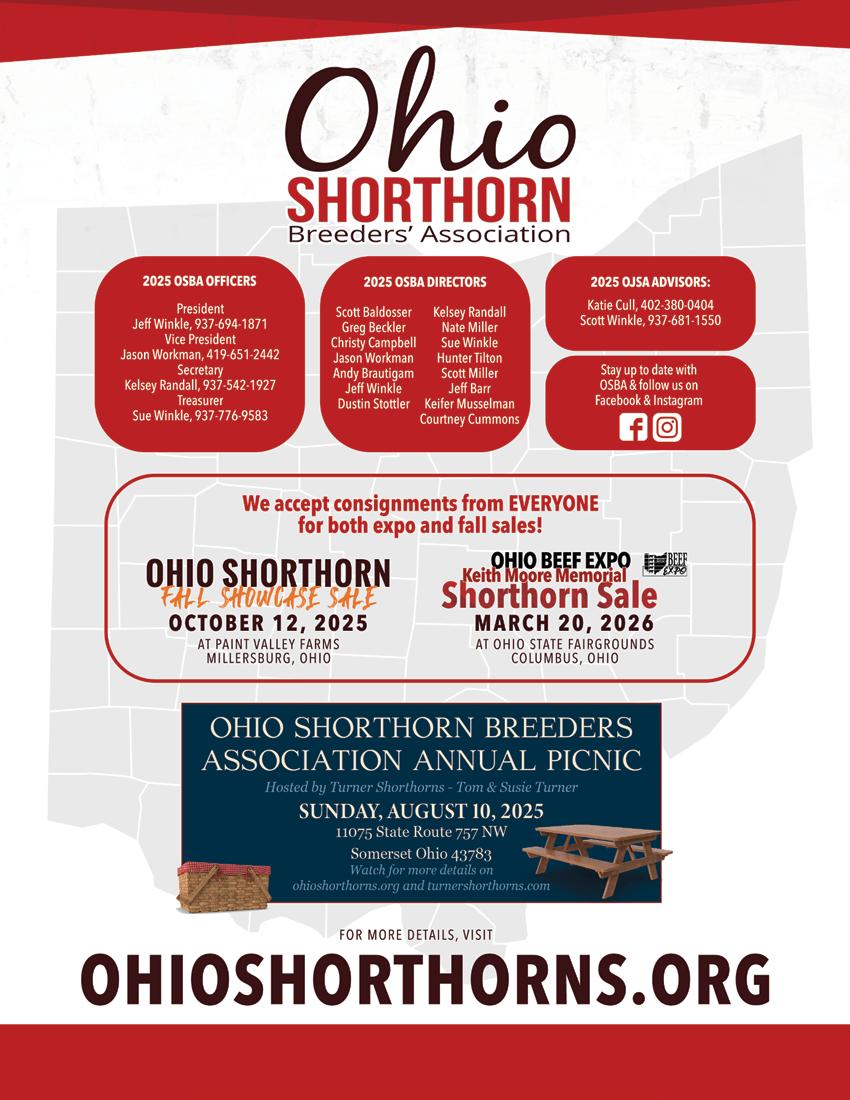
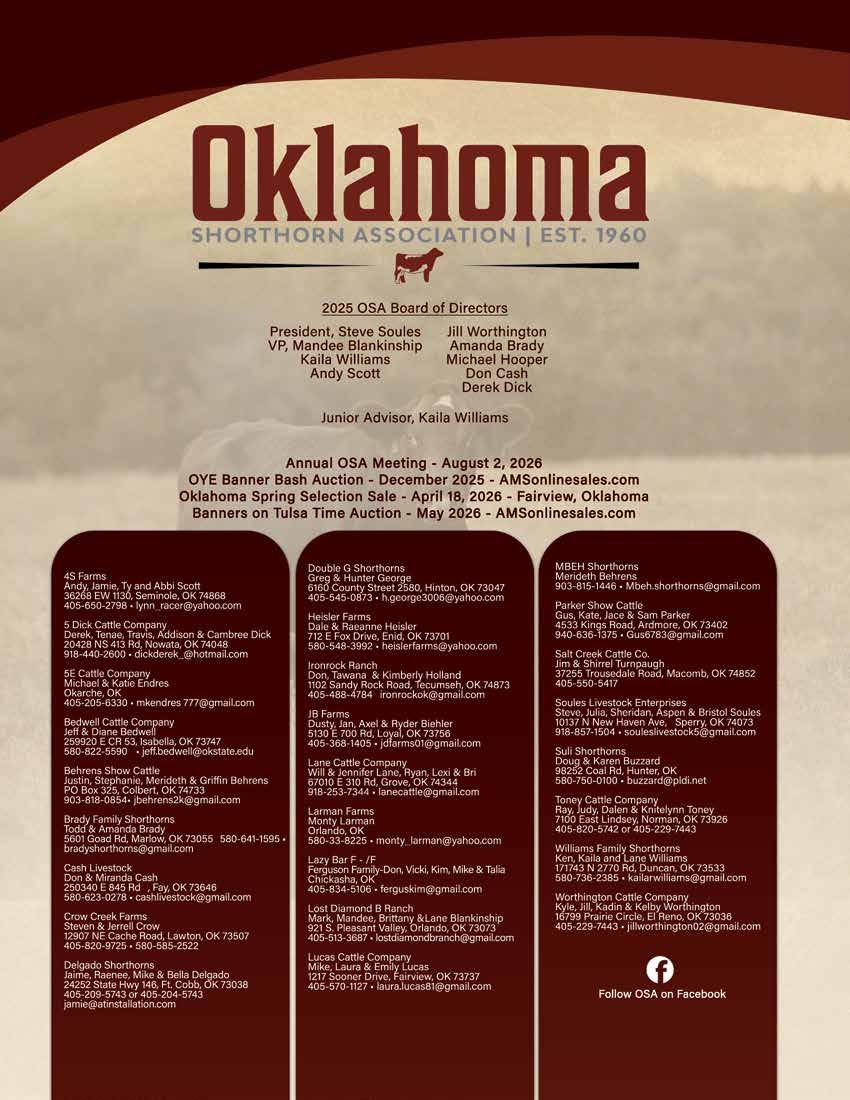
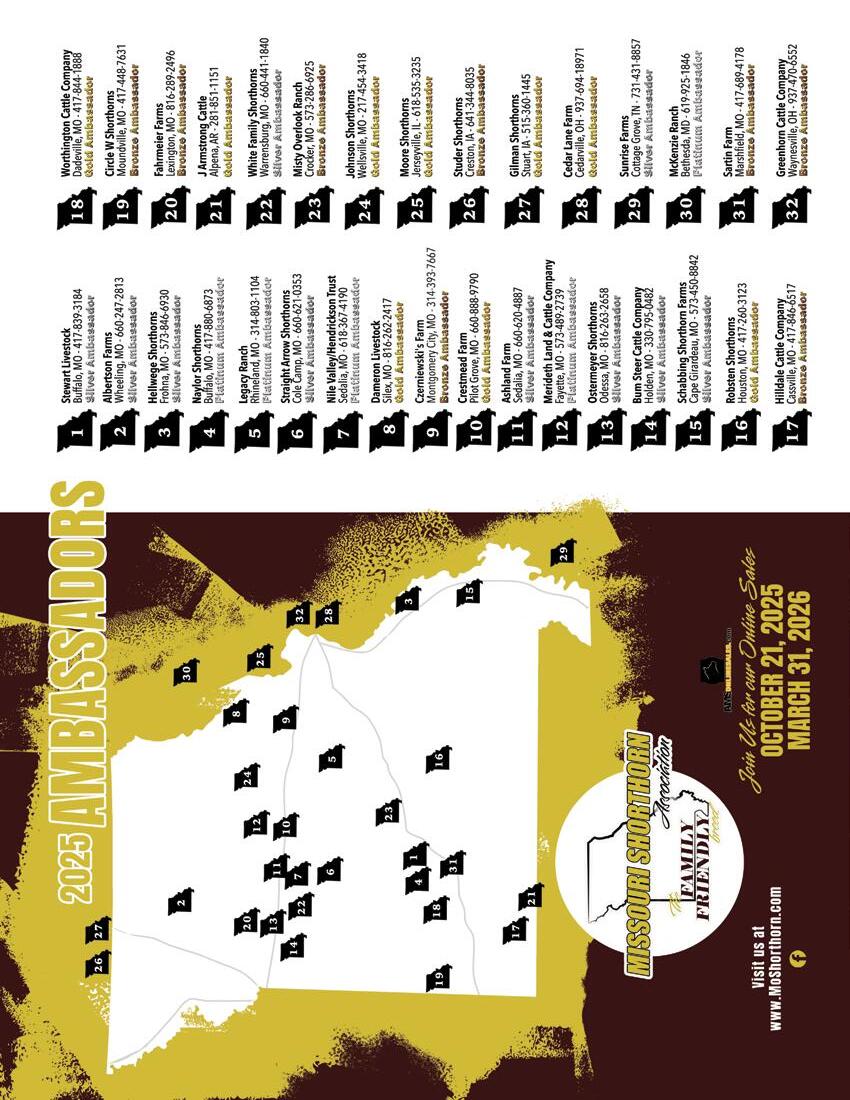
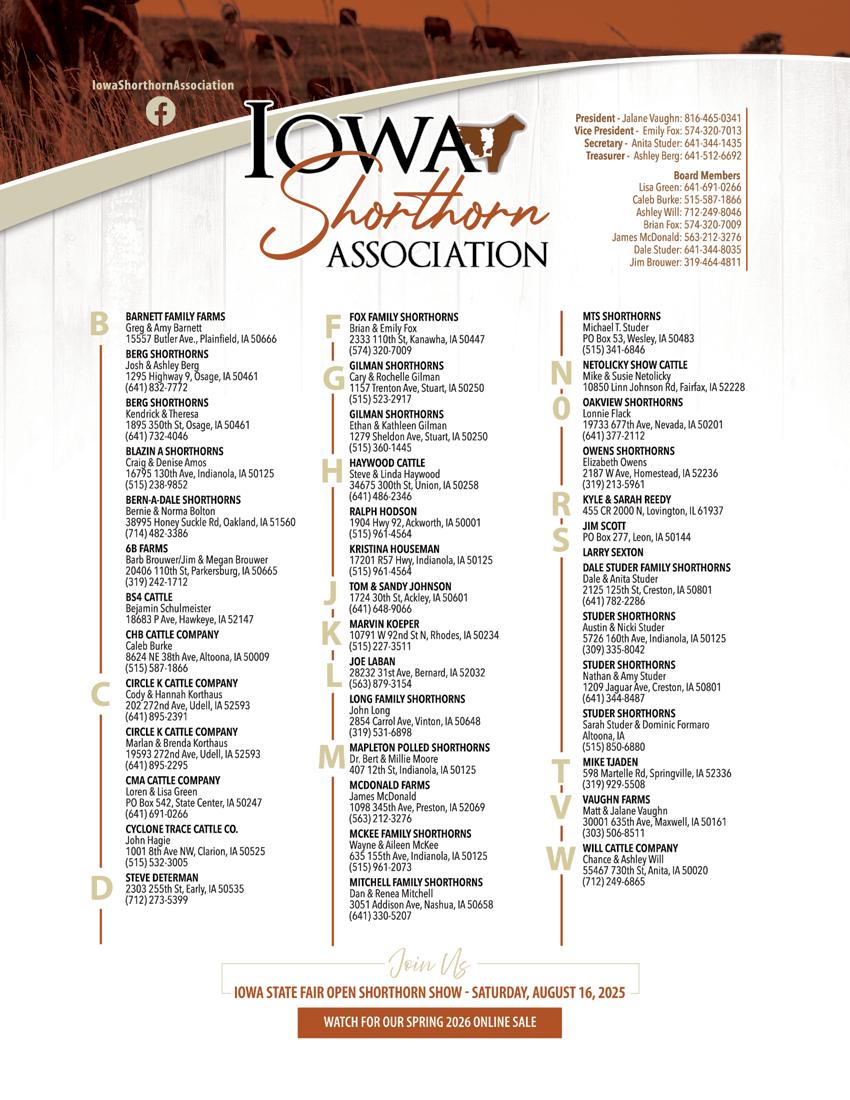
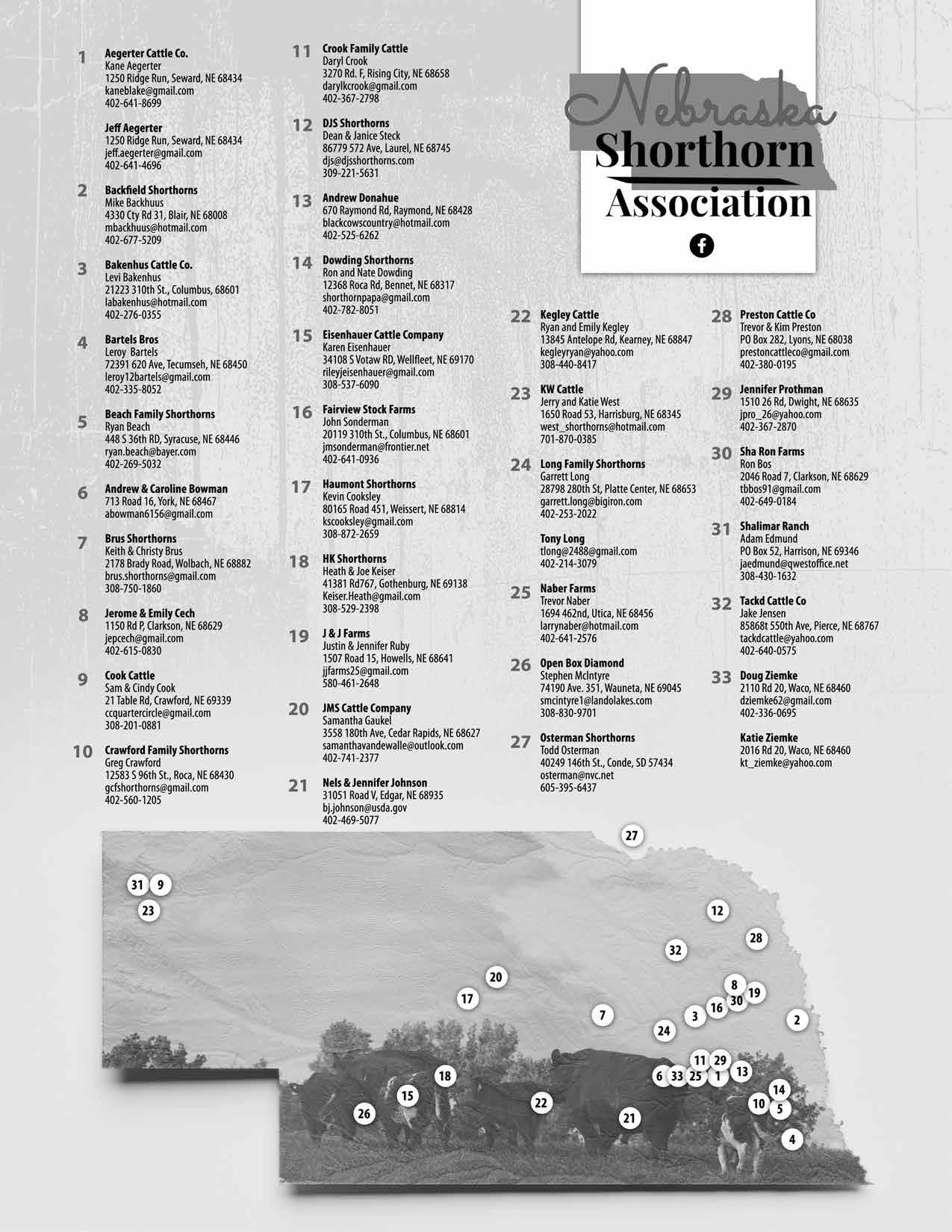

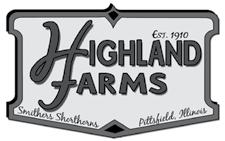
Home of Studer’s Crunch Time 22C
-Top 5% in the breed for WW, YW, TM, CW, and $F - Semen: $30/unit
Jason Smithers & Girls - 217-491-2140 jasonsmithers74@gmail.com
Greg & Pam Smithers - 217-285-6280 36739 205th Avenue • Pittsfield, IL 62363
Quality cattle for sale at all times. Located just a few miles south of Route 36/I-72.
Wayne Hinderliter Family 629 Co. Rd. 350 North Albion, IL 62806
Wayne: 618-384-8250
Doug: 618-384-1932
Visitors always welcome! Cattle usually for sale. Four miles north of I-64. Exit 130 on Illinois 130.
VisitorsWelcome... Stopbyanytime!
Don Cagwin P.O. Box 77 • Virginia, Illinois 62691 office: 217-452-3051 • cell: 217-341-7552
Kerry Johnston cell: 217-370-6033
Dalton Johnston cell: 217-416-9536
Cindy Cagwin-Johnston cell: 217-370-6034 cagwincattle@casscomm.com FarmlocatedfivemileseastofVirginiaonRoute125, thenonemilesouthoftheelevatoratPhiladelphia,Illinois.


Trey & Hailey Wright
Steve & Marsha Wright Route 2, Box 55
Beecher City, IL 62414
home: 618-487-5559
Trey: 618-367-0764
Steve: 618-267-3229

31056 Old Fidelity Road • Jerseyville, IL 62052

Scott Horton, Owner
Chris Cassady: 815-674-5129
Buddy Haas: 630-536-9180
4N010 Town Hall Rd. • St. Charles, IL 60175
WATAGA, IL 61488 contact: Dave Steck

Hugh: 618-729-4448 • Tom: 618-498-5848 Ron: 618-729-3258 Bulls, Females, Club Calves For Sale at all times. Full Irish calves available. 40 miles north of St. Louis.







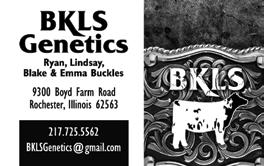

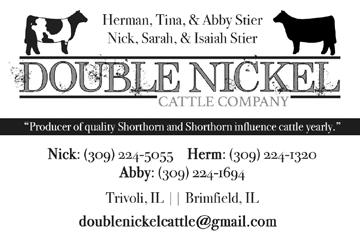






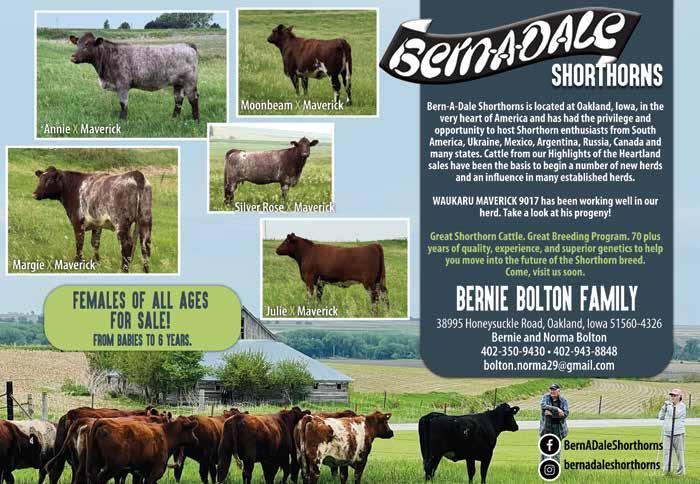




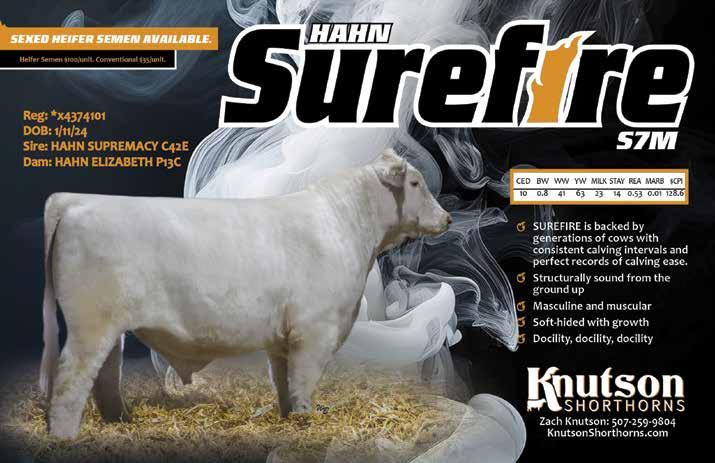
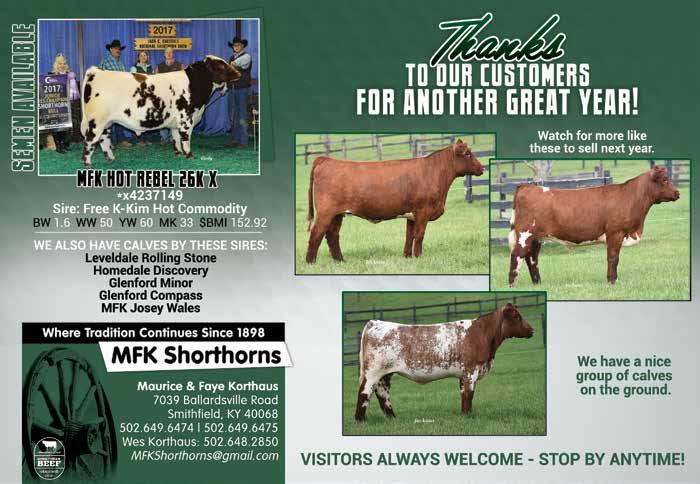


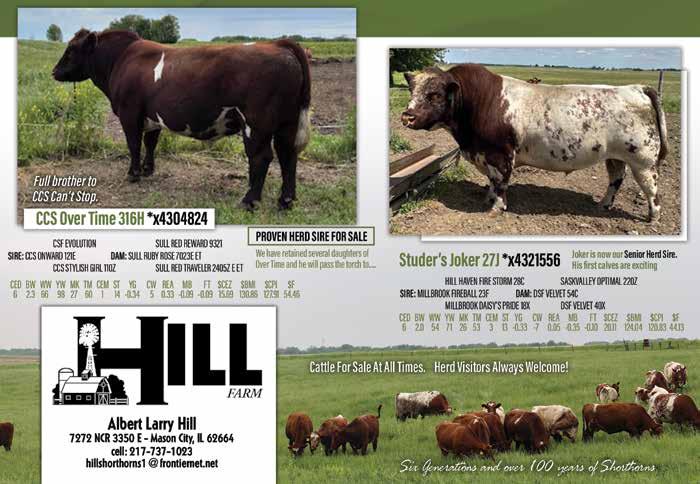








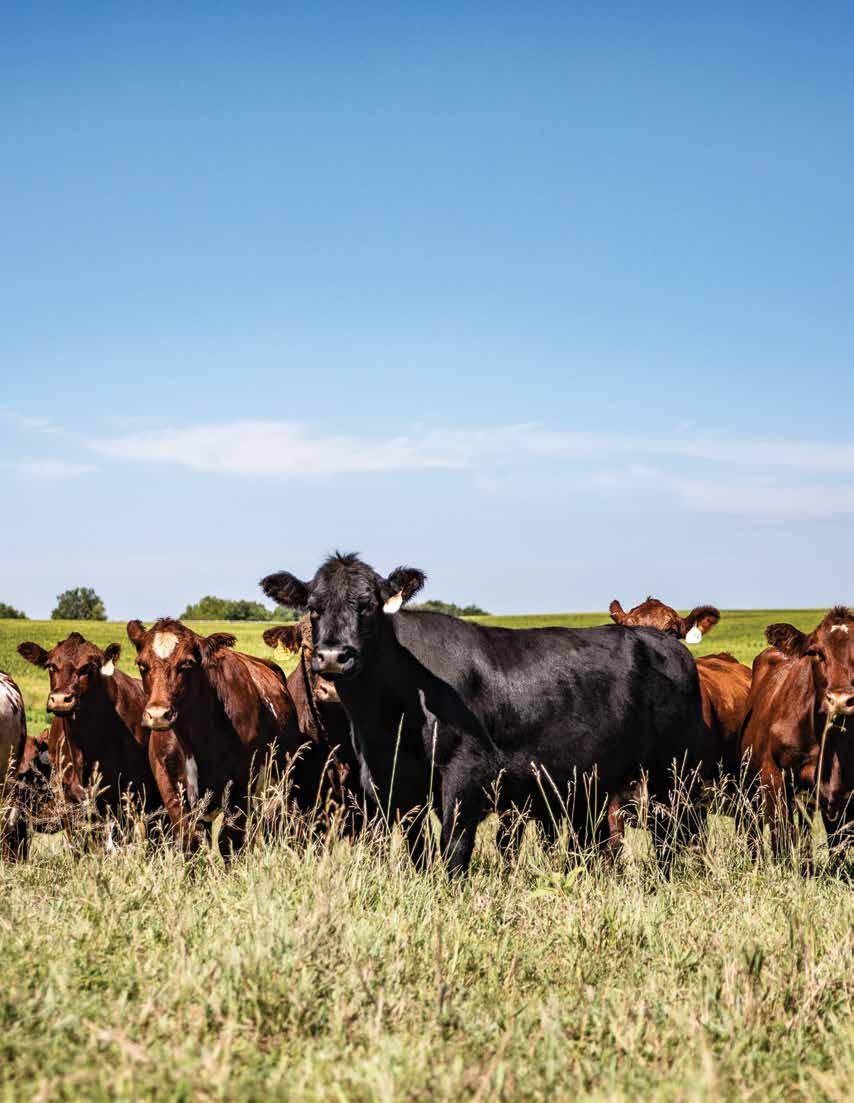
Shorthorns rank first among British and maternal breeds for yield grade, fat cover and percent retail product, according to data from the U.S. Meat Animal Research Center (MARC).
That means the Shorthorn breed offers a unique combination of muscling, marbling and maternal traits. Everything your cow herd needs to improve profitability.
Sale Summary
1 Bull ............................ $ 6,600 .................$ 6,600
18 Open Heifers .......... $ 64,700 ...............$ 3,595
9 Plus Open Heifers..... $ 29,450 ...............$ 3,272
6 Bred Females ............. $ 17,150 ...............$ 2,858
2 Cow/Calf Pairs .......... $ 5,300 .................$ 2,650
36 Live Lots ............... $ 123,200 ............$ 3,422
3 Embryo Pkgs $ 2,925 $ 975
8 Semen Pkgs $ 2,410 $ 302
2 Steers $ 3,000 $ 1,500 Sale Gross: $131,535
Saturday, April 19, 2025
Major Country Fairgrounds Fairview, Oklahoma
Auctioneer: Kevin Wendt Sale Management: Aegerter Marketing Services, Inc by: Darryl Rahn
A good crowd gathered at the fantastic facility on the Major County Fairgrounds for this high quality sale sponsored by the Oklahoma Shorthorn Assc. The consignors offered a top quality group of Shorthorn cattle for all to evaluate. The snappy sale saw very steady prices given for the leading lots in this sale. Congratulations to the consignors and all involved in making this sale a success.
$7,250 - Lot 19 - Plus Open HeiferAD Miss Boog. A black, polled October 10, 2024 daughter of LDB Braveheart 113 ET and out of a Simmental
influenced cow. This one was easily rated at the top of the sale by many. She has the body shape and style to make her an instant contender in the show ring and the look of a top brood cow. Offered by Addison Dick and purchased by Jan Biehler of Loyal, Oklahoma.
$6,600 - Lot 28 - Bull - HOBC Iceman. A white, polled March 10, 2024 son of Butt Big Cat and out of SLBL Francine 105F ET. The only herd bull in the sale but what a good youngster he was. Thick made with an extended front and the bone and foot needed on a herd sire. He will sire some outstanding club calves for his new owner. Offered by Jessica Hobaugh and purchased by Regan Bowman of Greenville, Ohio.
$5,000 - Lot 2 - Open Heifer - 2G Beau’s Girl 461 FL ET. A roan, polled November 1, 2024 daughter of Byland Flash 9U106 and out of SULL Moore Beau’s Girl ET. This was truly a fancy young show prospect that will compete. She is sweet fronted with the balance and style that make her one to look up to. She will be a good one. Offered by Double G Shorthorns and purchased by Waggoner Spurlen of Deleon, Texas.
$5.000 - Lot 15 - Open Heifer - AD Miss Tiger Lilly ET. A R/W, polled October 10, 2024 daughter of SULL
Dream Maker 9141G ET and out of LDB Mirage Premium Brave 901. There is great potential here. A daughter of the popular Dream Maker and out of a Premium Reward daughter. Her pedigree alone makes her a top prospect. Offered by Addison Dick and purchased by Ryan Harrington of Mowata, Oklahoma.
$4,500 - Lot 3 - Open Heifer - 2G Beau’s Girl 474 EV ET. A roan, polled November 21, 2024 daughter of CSF Evolution HC and out of SULL Moore Beau’s Girl ET. Evolution daughters have been in high demand in many recent sales and this one fits the bill. She has the show look and design to always be in contention. Offered by Double G Shorthorns and purchased by Peyton Ramsey of Jones, Oklahoma.
$4,500 - Lot 1 - Open Heifer - AD Miss Martini ET. A roan, horned October 1, 2024 daughter of FSF Perfection 812 and out of SULL Red Bo 3273 ET. This one was easy to look at. She has the added bone and dimension that comes with the Perfection offspring. She will surely be one to contend with this show season. Offered by Addison Dick and purchased by Regan Bowman of Greenville, Ohio.

Sale Summary
20 Cow/Calf Pairs $ 107,750 $ 5,388
3 Bred Cows $ 15,150 $ 5,050
17 Bred Heifers $ 80,450 $ 4,732
9 Open Heifers $ 42,150 $ 4,683
3 Bulls $ 14,400 $ 4,800
52 Live Lots ............... $ 259,900 ............$ 4,998
4 Embryo Pkgs $ 7,800 $ 1,950
5 Semen Pkgs $ 1,650 $ 550
1 Semen Tank $ 475 $ 475
Sale Gross: $269,925
Saturday, May 10, 2025
Reality Farms Sale Facility Campbellsburg, Kentucky
Auctioneer: Kevin Wendt Sale Management: Aegerter Marketing Services, Inc & Elam Managment Services by: Darryl
Rahn
A nice crowd gathered prior to the sale to view the sale cattle on display. What they found was the highest quality set of cattle that were the best ever offered at this sale. The demand for this quality was evident during the sale. The prices were steady throughout the sale on the offering. There was really a strong set of cow/calf pairs as well as the bred heifers. Congratulations to the consignors for presenting just an outstanding group of cattle. The totals for the sale were easily the best ever at this leading grass time event.
$8,500 - Lot 6 - Cow/Calf PairSharben Roan Rose’s Eve 1080 ET. A roan, polled 2019 daughter of CSF Evolution HC and out of SULL HD Roan Rose’s ET. At her side was a roan, polled heifer born February 6, 2025 sired by Byland Red Dog 05S44. What a great pair lead this sale. An Evolution female
with a great young calf by a son of Soggy Dog. This pair was in demand. Offered by Sharben Shorthorns and purchased by Ross Thompson of Frankfort, Kentucky.
$8,500 - Lot 2 - Bred HeiferSharben Lady Crystal Look 1428 ET. A red, polled 2023 daughter of CSF Long Look HC 706 ET and out of CF Lady Cryatal 624 RR ET selling bred to Gilman’s Basin 151L for a September 2025 calf. There was an extremely strong set of bred heifers in this sale and this was one of the best. A great pedigree to go with a top quality female. She will be a great addition to any herd. Offered by Sharben Shorthorns and purchased by Carolina Cattle Co of Central, South Carolina.
$8,000 - Lot 1 - Bred Heifer - Sharben Roan Rider FP 1427 ET. A roan, horned 2023 daughter of JSF Foreplay 168J and out of CF Red Rider 653 BS selling bred to Gilman’s Basin 151L for a September 2025 calf. This was one impressive beast. She had overall dimension to go with a sweet front one third and an added shot of frame that made her fun to look at. She will be a great cow in the future. Offered by Sharben Shorthorns and purchased by Six’s Shorthorn of New Freeport, Pennsylvania.
$7,750 - Lot 37 - Bred HeiferSharben Mona Lisa Look 1437. A red, polled 2023 daughter of CSF Long Look HC 706 ET and out of 7P Mona Lisa B2 selling bred to Gilman’s Basin 151L for a September 2025 calf. This was another of the really good bred heifers in this sale. Another one with a strong pedigree that makes her a great addition to a breeding program. Offered by Sharben
Shorthorns and purchased by Trena Greer of Garrison, Texas.
$7,250 - Lot 21 - Bred Cow - RFSS Red Margie 2331 ET. A red, polled 2021 daughter of SULL Red Reward 9321 and out of D&D Margie’s Beauty 610S ET selling bred to RFSS Roan Knight 25K ET for a September 2025 calf. This was an outstanding cow. Her pedigree alone is top of the line. Red Reward and out of the proven donor female, 610S. This one could easily go to the donor pen. Offered by Sugarbird Shorthorns at Respite Farms and purchased by Cheynne Cattle Co of Eddyville, Kentucky.
$7,000 - Lot 13 - Cow/Calf PairMartindell Lita 204. A red, polled 2022 daughter of Studer’s Golden Boy 21G and out of Martindell Lita 325. At her side was a RWM, polled heifer born February 21, 2025 sired by SBR Leverage 960L. The Spring pairs in this sale were truly outstanding individuals and this pair was among the best in that group. A beautifully made cow with a fancy young heifer at side. Ready to go. Offered by Martindell Farms and purchased by Daniel Powers of Manchester, Tennessee.
$7,000 - Lot 7 - Cow/Calf PairLGL Katrina 06. A roan, polled 2020 daughter of L&L Express ET and out of Byland Katrina 2RW70. At her side was a RWM, polled bull calf born February 23, 2025 sired by Byland Casino 3WS130. This cow is a true beef cow. She is thick made with a great udder and very correct on her feet and legs. She will be a great addition to any herd. Offered by Frank Laamphier and Sons and purchased by Nellie McCall of Simpsonville, Kentucky.
an exciting new home at Double Arrow Stock Farms of Thorhild, AB.
Thursday, April 3, 2025
Saskatoon Livestock Sales Saskatoon, SK, Canada
Auctioneer: Michael Fluery by: Royce Moellenbeck
Lot 43 – Saskvalley Lemans 234L$11,500. The crowd favourite for the day was a red, all-around, balanced made Flagstaff son. He was purchased by Anwender Cattle Co. of Radville, SK.
Lot 5 – Bell M Atlantis 19M - $11,000. This impressive roan Zirconium son out of a high producing Marion female was brought to Saskatoon by the Moellenbeck’s and is heading to
Lot 1 – Bell M Ironspring 3M$10,000. This long bodied, correct made Stockmaster son made lots of friends on sale day. He was purchased by a long time repeat customer, Bar 33 Ranch of Pierceland, SK.
Lot 53 – Saskvalley Lebowski 291L - $10,000. This smooth made, roan two-year old bull whose dam is a CSA Performance Dam was purchased by Bruce Bamford of Calgary, AB.
Lot 10 – Bell M Bravo 45M - $9,500. This attractive made son of Paragon was purchased by Lochart Ranch of Oxbow, SK.
Lot 4 – Bell M Discovery 6M - $9,000. This powerful roan Zirconium son was purchased by Bullseye Shorthorns of Picture Butte, AB.
Lot 3 – Bell M Cynergy 5M - $8,500
This deep bodied red son of Stockmaster was purchased by Sunnyland Shorthorns of Guernsey, SK.
Lot 22 – Muridale Thermal 5L$8,250. The Muri’s brought a set of bulls sired by Thermal Energy who walked the very same ring when he was a twoyear old. 5L was the top pick for the day and he is headed to Zane Lammers of Purdue, SK.
Lot 60 – Bell M Marion 100M$5,000. This roan heifer was purchase by Flightpath Shorthorns of Caledon, ON.
Lot 61 – Bell M Flower 123M$5,000. This red heifer was purchased by Marshall Wallum of Iroquois, SD, USA.


The ASA is excited to announce that we have launched a NEW website!! This website has all the information on the previous website - it is more modern and easier to navigate.
We are also excited that it now features ALL the junior information as well. ONE website for all info!
You can still access the DigitalBeef Registry at the very top right of the page for easy access to your registry account.
Included perk - this website is much more mobilefriendly, making it easier to access on the go.




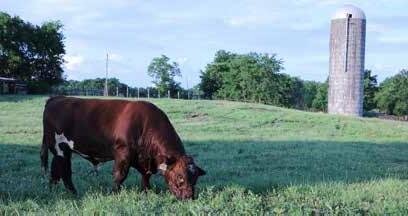




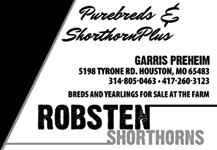


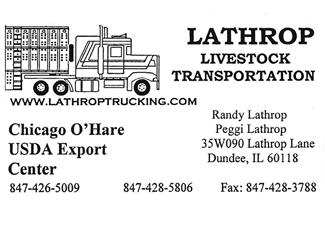
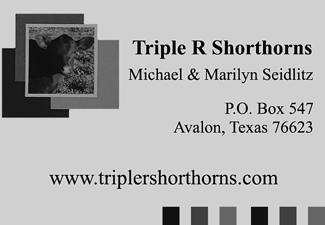





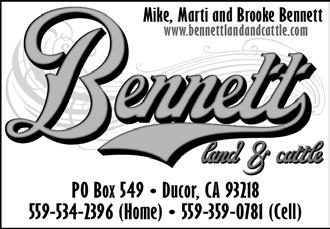

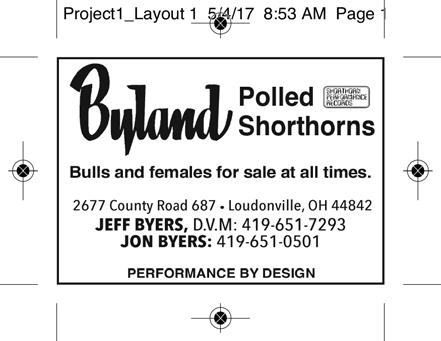
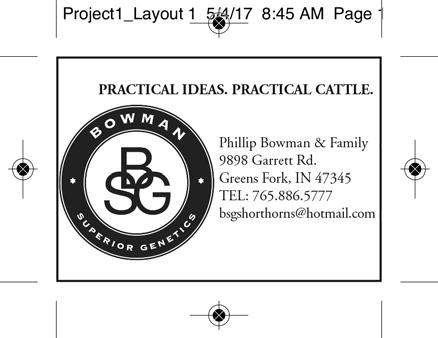








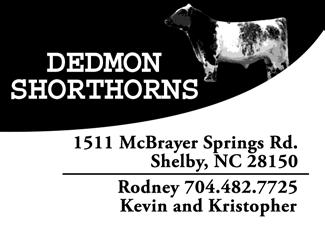


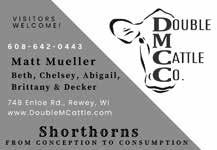


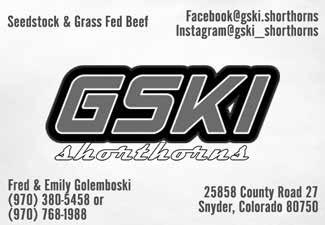
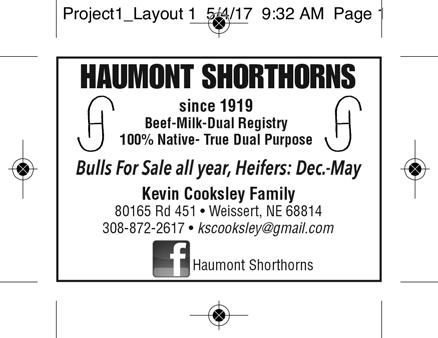

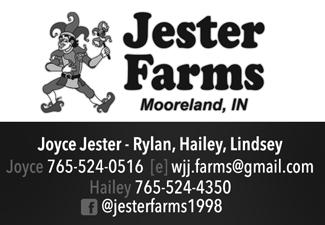





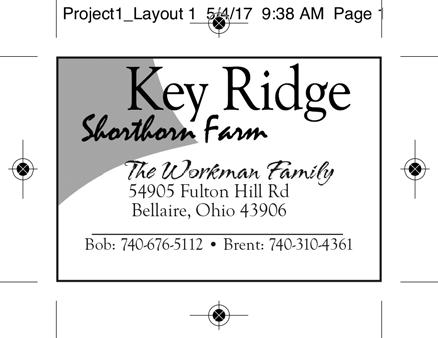



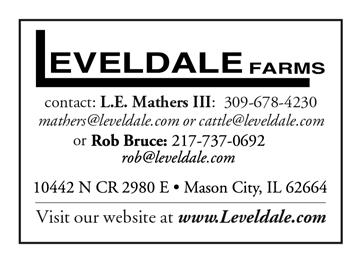

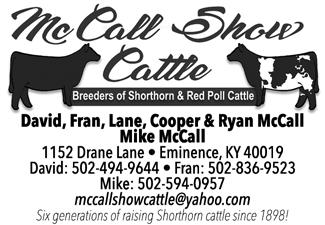



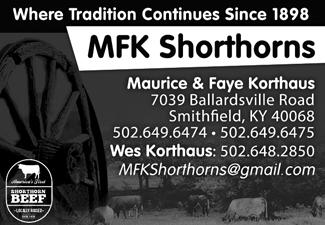




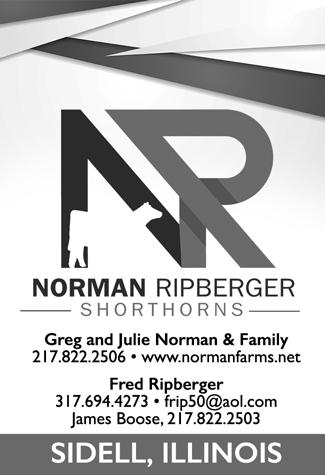





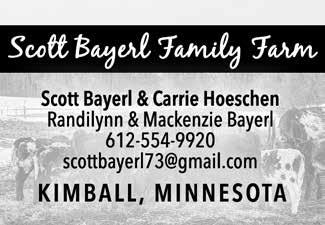



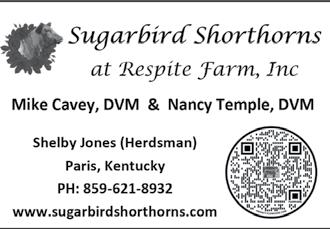

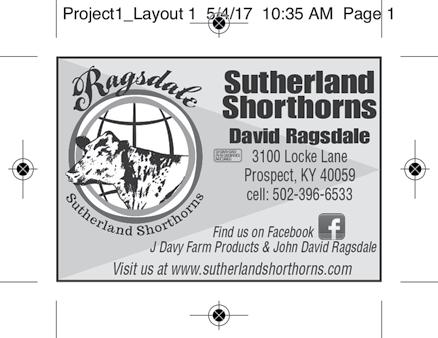


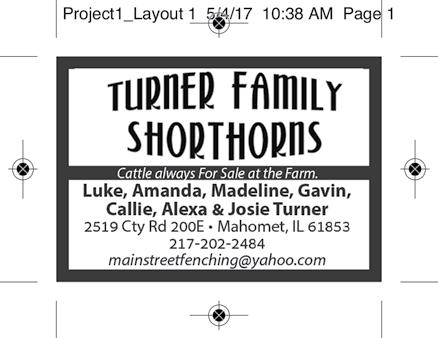
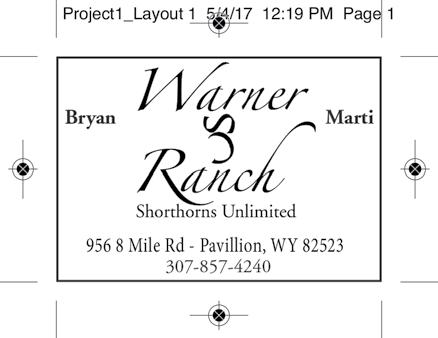




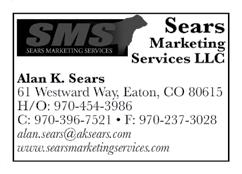


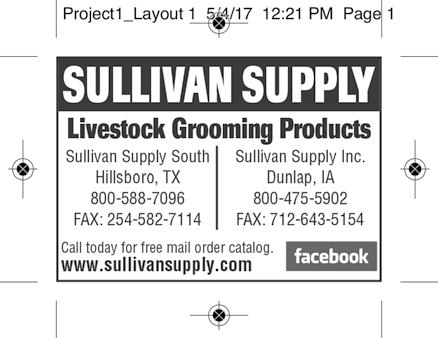
Show Season: April 1, 2025 – March 31, 2026
*Individual show schedule subject to change
Northeast Region :: CT, DE, IN, ME, MD, MA, MI, NH, NJ, NY, OH, PA, RI, VA, VT, WV
National Show :: Keystone International Livestock Expo
Super Regional Show :: Ohio State Fair
Regional Shows :: Maryland State Fair & State Fair of West Virginia
Southeast Region :: AL, FL, GA, KY, MS, NC, SC, TN
National Show :: Dixie National
Super Regional Show :: Tennessee State Fair at Wilson County Fair
Regional Shows :: Appalachian Fair & Kentucky State Fair
North Central Region :: IL, IA, MO, MN, NE, ND, SD, WI
National Show :: American Royal
Super Regional Show :: Minnesota State Fair
Regional Shows :: Illinois State Fair & Iowa State Fair
South Central Region :: AR, KS, LA, OK, TX
National Show :: Fort Worth Stock Show
Super Regional Show :: Kansas State Fair
Regional Shows :: Tulsa State Fair & Tri-State Fair
West Region :: AZ, CA, CO, ID, MT, NV, NM, OR, UT, WA, WY
National Show :: National Western Stock Show
Super Regional Show :: Western Idaho Fair
Regional Shows :: Northern International Livestock Exposition & Washington State Fair
*Regional Awards calculated from Regional, Super Regional & National Shows within each region. Animal must exhibit at 2 of 4 shows to qualify.
Super National Shows :: 2 total
North American International Livestock Expo :: Louisville, KY Cattlemen’s Congress :: Oklahoma City, OK
National Shows :: 5 total, 1 in each region
Northeast :: Keystone International Livestock Expo :: Harrisburg, PA
Southeast :: Dixie National :: Jackson, MS
North Central :: American Royal :: Kansas City, MO
South Central :: Fort Worth Stock Show :: Fort Worth, TX
West :: National Western Stock Show :: Denver, CO
*National Show Bull & National Show Female points accumulated from 7 total National & Super National Shows listed above. Animal must exhibit at 2 of 7 shows to qualify for National Show Awards.
* To have your sale listed in the sales calendar, you must be an advertiser with the Shorthorn Country.

PA, amsonlinesales.com
Sept. 15 - Jester Farms “No Foolin” Sale, Mooreland, IN, amsonlinesales.com
Sept. 16 - Moore Shorthorns Show Heifer Online Sale, Jerseyville, IL, amsonlinesales.com
Aug. 30 - Cates Farms “Star Search” Production Sale, Modoc, Ind.
Aug. 30-31 - R-C Show Cattle Early Bird Online Sale & Open House, Eaton, Ohio., sconlinesales.com
Aug. 30-31 - Turner Shorthorns “Somerset Sensations” Open House & Private Treaty Sale, Somerset, Ohio.
Aug. 31 - Cagwin Farms Open House “Show Heifer and Frozen Genetics Online Sale”, Virginia, Ill.
Sept. 1 - Cagwin Farms “Show Heifer and Frozen Genetics Online Sale”, Virginia, Ill., amsonlinesales.com
Sept. 2 - Cornerstone Farms “Home of the Rockstars” Vol. VI Online Sale, Winchester, Ind., sconlinesales.com
Sept. 8 - Smith Family Farms “Cattlemen’s Cut” Online Sale, Pendleton, Ind., amsonlinesales.com
Sept. 14 - Farrer Stock Farms “52nd Annual Club CAlf Sale”, Royal Center, Ind.
Sept. 27 - The Great Shorthorn Revival, Beaverton, Mich.
Oct. 4 - Greenhorn Cattle Co “Where Great Females Make a Difference” Production Sale, Waynesville, Ohio.
Oct. 6 - Bollum Family Shorthorns “Red, White & Roan” Online Sale, Goodhue, Minn., amsonlinesales.com
Oct. 11 - Studer Family Shorthorns “Family Legacies” Production Sale, Anita, Iowa.
Oct. 11 - Schrag/Nikkel “Family Event Sale”, Marion, S.D.
Oct. 12 - Ohio Shorthorn Breeders Association “Fall Showcase Sale”, Millersburg, Ohio.
Oct. 18 - Bedwell Cattle Co & Lost Diamond B Ranch “Lasting Impressions Sale”, Isabella, Okla.
Oct. 18 - Coldstream Farm “Shorthorn Harvest” Event, Flesherton, Ontario, Can., amsonlinesales.com
Oct. 20 - Brennstuhl Farms “From the Pasture for a Purpose Female Sale” Bid-Off, Danville, Ohio
Oct. 21 - Missouri Shorthorn Association Fall Online Sale, amsonlinesales.com
Oct. 21 - Double G Shorthorns Online Sale, Hinton, Okla., amsonlinesales.com
Oct. 26 - Six’s Shorthorns “Legends of the Fall” Sale, Wind Ridge, Pa.
Oct. 30 - Shadybrook Shorthorns “The Tradition Contiues” Online Sale, West Brome, Queb, Can. amsonlinesales.com
Nov. 1 - Jungels Shorthorn Farm “Durham Nation” Production Sale, Kathryn, N.D.
Nov. 15 - Revival “Louisville Elite”, Louisville, Ky.
Nov. 16 - Greenhorn Cattle Co “Where Future Generations Are Created” Sale, Louisville, Ky.
Nov. 22 - Bowman Superior Genetics “Profit by De$ign” Production Sale, Greens Fork, Ind.
Nov. 23 - Farrer Stock Farm “30th Annual Dynamic Dams Sale”, Royal Center, Ind.
Dec. 1 - Vogel Shorthorn Farm & Osterman Shorthorns “Shorthorns of the Midwest” Online Sale, amsonlinesales.com
Dec. 13 - Paint Valley Farms, Byland Polled Shorthorns & Beckler Shorthorns “Maternal Event” Sale, Millersburg, Ohio.
Sept. 22 - Leemon Cattle Company “Banners and Bloodlines” Online Sale, Fairland, OK, amsonlinesales.com
Sept. 23 - Shoufler Shorthorns Online Sale, Fortville, IN, amsonlinesales.com
Sept. 27- Great Shorthorn Revival, Beaverton, MI.
Sept. 30 - Cagwin Farms 1872 Opportunity Sale, Virginia, IL, amsonlinesales.com
Sept. 30 - West Fork Ranch Club Calf Sale, Loup City, NE, amsonlinesales.com
Oct. 1 - Millbrook’s Northern Exposure Volume IV, Brome, Quebec Canada, amsonlinesales.com
Oct. 4 - Greenhorn Cattle Company “Where Great Females Make a Difference” Production Sale, Waynesville, OH.
Oct. 6 - Bollum Family Shorthorns Red, White, and Roan Online Sale, Goodhue, MN, amsonlinesales.com
Oct. 11 - Crow Creek “Heart of the Prairie” Production Sale, Lawton, OK, amsonlinesales.com
Oct. 11 - Schrag 605 “Family Event” Sale, Marion, SD.
Oct. 12 - Ohio Shorthorn Breeders Association Fall Showcase Sale, Millersburg, OH.
Oct. 12 - 4 Spear Ranch Roans in the Rockies Sale, Casper, WY, amsonlinesales.com
Oct. 13 - Hill Haven Selection Sale, Duntroon, Ontario, Canada, amsonlinesales.com
Oct. 13 - Bishell/Nollswood Online Sale, Mineral Point, WI, amsonlinesales.com
Oct. 14 - Nelson Farms Maternal Icons Show Heifer and Genetic Online Sale, Seneca, IL, amsonlinesales.com
Oct. 18 - Bedwell Cattle Co. & Lost Diamond B Ranch “Lasting Impressions” Sale, Isabella, OK.
Oct. 18 - Coldstream Farm “Shorthorn Harvest” Event, Flesherton, ON Canada, amsonlinesales.com
Oct. 21 - Double G Shorthorns Online Sale, Hinton, OK, amsonlinesales.com
Oct. 21 - Missouri Shorthorn Association Fall Sale, amsonlinesales.com
Oct. 22 - Schutz Cattle Company “Bred for Banner’s” Sale, Parkland County, Alberta, Canada, amsonlinesales. com
Oct. 26 - 3 Buck Cattle Company Online Sale, Bryant, SD, amsonlinesales.com
Oct. 26 - Six’s Shorthorns “Legends of the Fall” Sale, Waynesburg, PA
Oct. 27 - Horns in the Heartland Sale, Syracuse, NE, amsonlinesales.com
Oct. 27 - KAW Red Angus Maternal Magic Sale, Seward, NE, amsonlinesales.com
Oct. 28 - S Co. Farm “Minnesota Made” Elite Multi Breed Sale, Hastings, MN, amsonlinesales.com
Nov. 1 - Jungels Shorthorn Farm “Durham Nation” Production Sale, Kathryn, ND

6B Farms 85
AAA Shorthorns .......................... 130
Aegerter Marketing Services, Inc... 33, 135
Bar M Shorthorns 129
Beckler Farms LLC ........................ 98
Bell M Farms 116
Bennett Land & Cattle ................ 130
Berg Shorthorns 130
Bern-A-Dale Shorthorns.............. 115
Bigelow Farms 130
Bollum Family Shorthorns 53
Bowman Superior Genetics .. 6-7, 130
Brennstuhl Farms 99, 130
Byland Polled Shorthorns ............ 130
Cagwin Cattle Services LLC 133
Cagwin Farms .......................... 16-17
Cairns Shorthorns 130
Cates Farms 19, 130
Cattle Visions .............................. 133
Cheyenne Cattle Company 92
Circle K Cattle Company ............ 129
Coldstream Farm 97
Cornerstone Farms ................ 27, 130
Crawfdown Farms 130
Crowe Shorthorns ......................... 96
Dale Studer Family Shorthorns ... IFC
Deckert Stock Farm 129
Dedmon Shorthorns ................... 130
Deerhorn Farms 75
DHS Show Cattle ......................... 93
DJS Shorthorns 130
Double C Shorthorns .......... 103, 130
Double G Shorthorns 68
Double M Cattle Company 64, 130
DTR Cattle Co. .................... 39, 130
Duis Farms 130
Elam Sale Management ............... 120
Fairview Stock Farm 130
Farrer Stock Farms......................... 61
Fieser’s Polled Shorthorns 131
Gellerman 122
Gilman Shorthorns ....................... 15
Greenhorn Cattle Co. 29, 131
Greg Crawford Family ................. 116
GSKI Shorthorns 115, 131
Hansen Shorthorns ..................... 129
Haumont Shorthorns 113, 131
Hi-View Shorthorns 129
Hill Farm .................................... 119
Hillside Farm 131

Homedale Farms 119
Homeplace Farms........................ 131
Humble Stock Farm 122, 131
IL Breeders Unitd For Impact .. 110-111
Illinois Shorthorn Association 120
Inness Shorthorns ........................ 131
Iowa Shorthorn Assoc. 107
Ippensens Family Shorthorns 86
James F Bessler LLC .................... 133
Jester Farms 131
Jordan Acres .................................. 49
Jungels Shorthorn Farm 138-139
Kafka Cattle Co ....................... 12-13
Kansas Shorthorn Association 109
Kevin Wendt 133
Key Ridge Shorthorn Farm.......... 131
Keystone Shorthorns 83, 131
Knutson Shorthorns .................... 117
KSS Keystone Shorthorns 59, 131
Lakamp ‘Willow Branch’ Sh Farm .. 129
Lathrop 129
Lazy Bar F Shorthorns ................... 63
Legacy Ranch 69, 131
Leveldale Farms 45, 131
Little Cedar Cattle Co. .......... 31, 131
Lost Diamond B Ranch 37
Loving Farms ................................ 28
Mapleton Polled Shorthorns 118
Martindell Farm ............................ 40
McCall Show Cattle 131
McKay Farms 131
Merck Animal Health.................... 32
Merideth Land & Cattle 81
Meyer Family Shorthorns ............ 132
Meyer Farms 117, 132
MFK Shorthorns ................. 118, 132
Miller Farms Shorthorns 74
Millvale Shorthorns 122
Missouri Shorthorn Assoc. .......... 106
Moore Shorthorns 50
MTS Shorthorns ......................... 129
Narrow Brook Shorthorns 113, 132
Nebraska Shorthorn Association .. 108
Nelson Farms 52
Norman/Ripberger Shorthorns.... 132
Oakview Shorthorns...................... 72
Ohio Shorthorn Breeders Assoc. 104
Oklahoma Shorthorn Assoc......... 105
Oler Farm 132
Paint Valley Farms ........................ BC
Peak View Ranch 23
Pearl Valley Shorthorns.................. 56
Richardson Farms 132
Robert & Bev Alden 51
Robjoy Shorthorns ...................... 132
Robsten Shorthorns 129
Rockin’ G Land & Cattle ...... 79, 132
Rocky Branch Shorthorns 114, 132
Ron Alden ................................... 129
Schrag|Nikkel Cattle 3
SCI Designs 87
Scott Bayerl Family Farm ............ 132
Sears Marketing Services, LLC 122, 133
Shadeland Farm........................... 132
Shadybrook Farm 5
Sharben Shorthorns ............... 41, 132
Shorthorn Foundation 77
Six Shorthorns 10-11
Smith Family Farms .............. 35, 132
Smoky Mountain Farm & Ranch 132
Sodhouse Cattle Co. .................... 121
South Starr Farms 137
Stangl Shorthorns .................. 36, 132
Stecks Cattle 57
Stepping Stone Ranch 114
Stone Springs Shorthorns ...... 67, 132
Stuart Wilson Consulting 133
Sugarbird Shorthorns .................. 133
Sullivan Supply 133
Sutherland Shorthorns ................ 133
Tadmore Farms 65
Texas Shorthorn Assoc. 24-25
Triple R Shorthorns ..................... 129
Turner Family Shorthorns 133
Turner Shorthorns ....................... 136
Twin Oak Farms 133
V8 Shorthorns............................. 133
Vogel Shorthorn Farm 112
Warner Ranch 133
Waukaru Shorthorns ............. 43, 133
White Birch Farm 71
WHR Shorthorns ............................ 9
Wise Shorthorns 73
Woodrange Farm ...................... 20-21
WZ Polled Shorthorns 112



